





Balers
Sprayers
In Focus
PowerGuard
Articles
Regenerative agriculture
Sustainable & profitable farming
Hedgerows for greater biodiversity
The future of palm oil
magazine
Included inside
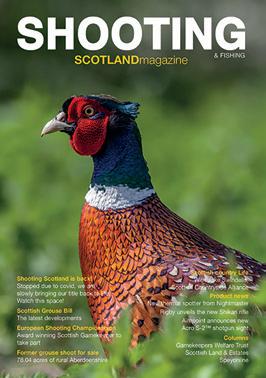
Shooting Scotland Magazine
Our sister title is back again
Travel Scotland
Destination Dunfermline
Farmhouse Kitchen
Celebration of cheese plus
Flavour of Scotland • Beatha an Eilean Ffermio Cymru • Scottish Country Life
Women in Agriculture
Book Serialisation • Food & Drink including our regular news areas and columns

£3.75 April 2024
Tuathanachas Alba
Proud to support Scottish farming, and agriculture throughout the five nations










contents April 2024 All Editorial & PR enquiries EDITOR Athole Murray Fleming Tel. 01738 639747 E-mail: mail@farmingscotlandmagazine.com 14 COPYRIGHT This publication has been produced and published by ATHOLE DESIGN & PUBLISHING LTD who are the copyright owners. No reproduction, copying, image scanning, storing or recording of any part of this publication without the permission of ATHOLE DESIGN & PUBLISHING LTD. Contents disclaimer: FARMING SCOTLAND MAGAZINE is not responsible for any factual inaccuracies within press information supplied to us. Any concerns regarding such matters should be directed to the supplier of the materials. FARMING SCOTLAND MAGAZINE is designed, produced and published by Athole Design & Publishing Ltd., Tolastadh, 18 Corsie Drive, Kinnoull, Perth, Scotland PH2 7BU. Tel. 01738 639747 ISSN: 2041–918X ©ATHOLE DESIGN 2024 est 1994 COVER IMAGE: The proud stag Features 22 Balers 41 Sprayers In Focus 20 PowerGuard Articles 13 Sustainable & profitable farming 39 Regenerative agriculture 49 The future of Palm Oil 55 Hedgerows-improving biodiversity Flavour of Scotland 14 Champion butchers Ffermio Cymru 32 News from Wales Northern Isles 52 Stories from Orkney and Shetland Beatha an Eilean 54 Life on the Islands Shooting Scotland Magazine 77 The re-birth of a title Travel Scotland 94 Destination Dunfermline Book Serialisation 96 A Sky Full of Kites part 2 Women in Agriculture 98 Oxford Farming Conference Farmhouse Kitchen 100 Celebration of Cheese News Areas 6 Arable & Root Crops 16 Food & Drink 18 World Farming 19 Science & Technology 37 Environment 40 Renewable Energy 50 People 51 Aquaculture 56 Beef 57 Livestock 66 Dairy 70 Sheep 74 Pigs 87 Finance 88 Estate 92 Forestry 102 Machinery 121 People on the Move 122 The Book shelf Columns 6 Editor’s Bit 9 James Hutton Institute 11 R.S.A.B.I 15 Scotland the Brand 17 Scottish Government 33 Welsh Government 38 Farming for the Climate 61 Quality Meat Scotland 65 The Vet 69 Crofting 69 Farm Advisory Service 71 NSA Scotland 75 NFU Scotland 80 Gamekeepers Welfare 83 Scottish Land & Estates 85 Speyonline 91 Conservation Matters 92 Scottish Forestry 93 Farm Advisory Service 99 Southern Belle Subscriptions 36 Order your copy here. Next Issue Out in May. Featuring: RHS Preview, ScotSheep, Game Fair, Milking Equipment, Potato Equipment and so much more!. See our website for details. www.farmingscotlandmagazine. com Advertising & Editorial Enquiries Call 01738 639747 or email mail@farmingscotlandmagazine.com 39 79 90 95 facebook.com/FarmingScotlandMagazine All Advertising & Editorial enquiries ADVERTISING DIRECTOR Athole Murray Fleming Tel. 01738 639747 E-mail: mail@farmingscotlandmagazine.com ADVERTISING MANAGER Barry Tweed Tel. 01475 910153 Email: barry@farmingscotlandmagazine.com PRODUCTION DIRECTOR Christina Fleming Email: christina@atholedesign.com
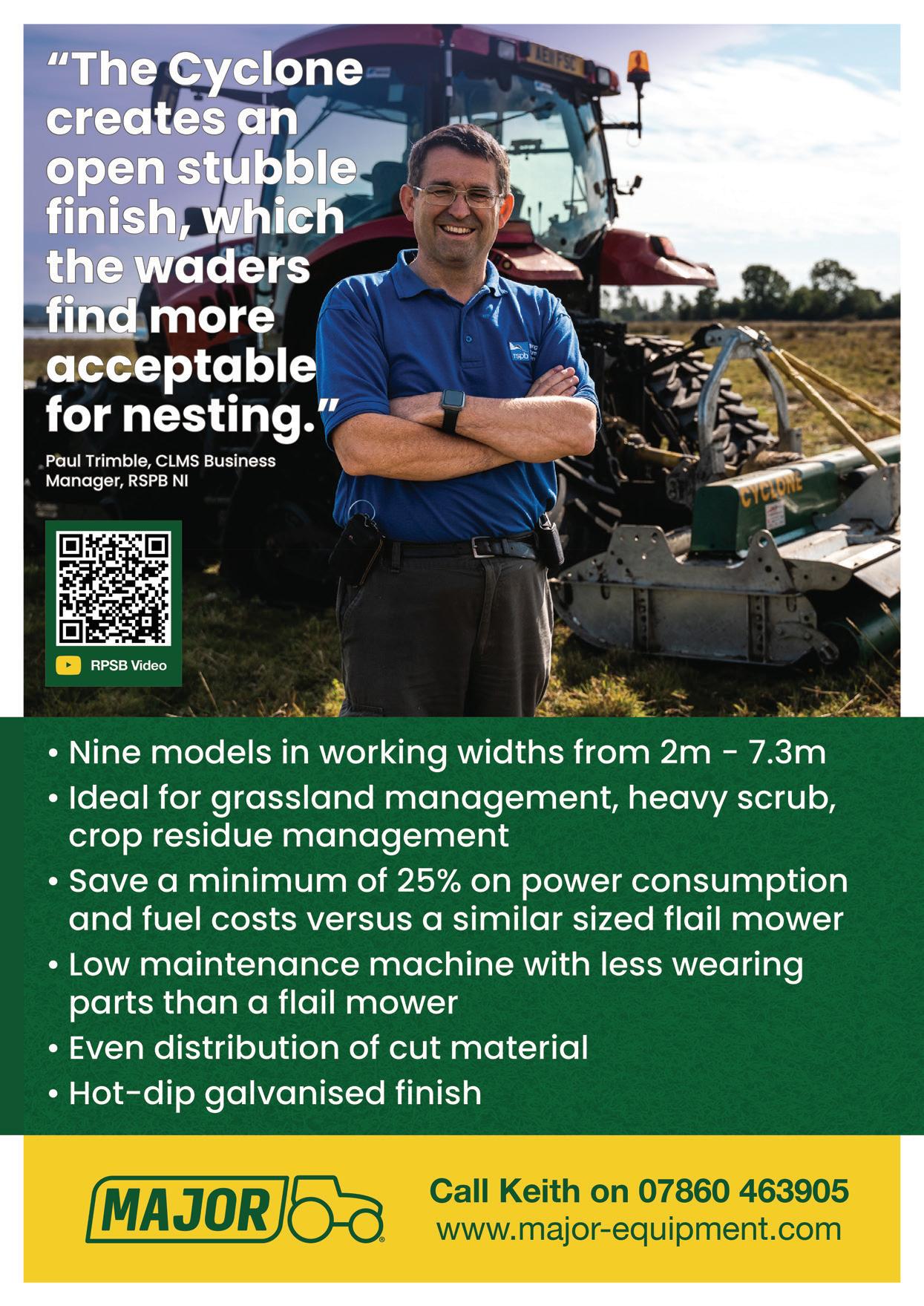

editor's bit Spring is in the air!
Welcome to our spring edition, can you tell I’m in a good mood?
The wee flowers are popping up just outside my garden office and the sky is staying lighter for longer, “Aye, the nights are fair drawing oot!”.
All of this makes us feel better, and with that comes enthusiasm for life.
New life in the fields, life in the trees, all around us life is re-emerging from its winters slumber.
Grey skies are slowly turning into blue, and the warming of the ground has begun to bring our spring flowers back to life.
But then, there is always the rain!
One thing Scotland is never short of, and that’s the waater.
But if we didn’t have the ‘waater’, we wouldn’t have the ‘Whisky!’….bonus!
So there was have it, my wee thoughts on spring.
Time to prepare Bongo the Bruce, our we campervan, can’t wait!
Can you tell I’m in a good mood?
Slàinte, Athole.
Call
& root crops
for farmers to complete fresh produce consultation
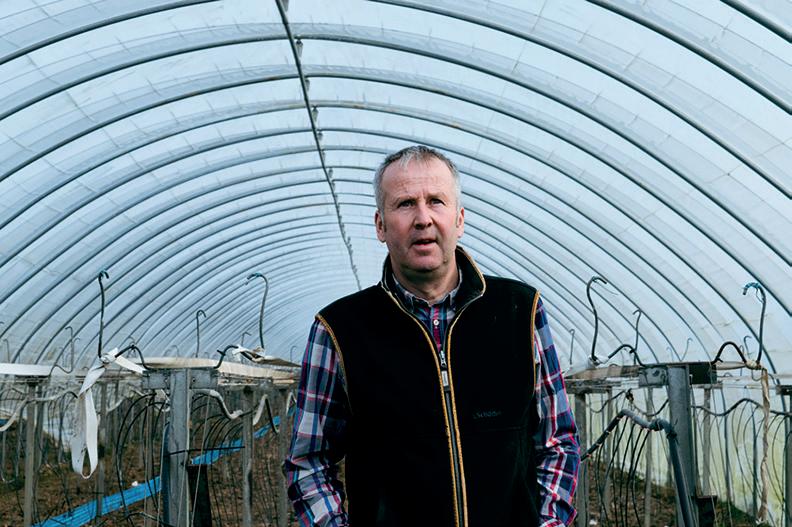
Union welcomes spotlight on contractual arrangements for vegetable, potato and soft fruit growers.
Defra is undertaking a major consultation into contractual relationships in the fresh produce sector and NFU Scotland is urging the nation’s growers to take part.
This latest Defra consultation follows on from similar examinations of the pig and dairy sectors and is part of a UK Government commitment to review supply chain practices.
The consultation will gather evidence from individual businesses about how supply arrangements in the fresh produce sector currently function and explore the nature of relationships in the supply chain. It is also seeking views on whether the functioning of the supply chain can be improved.
It is available to complete at https://consult.defra.gov. uk/supply-chain-fairness/ contractual-relationships-inthe-uk-freshproduce-i/
NFU Scotland’s Horticultural chair Iain Brown said: “I welcome a review of the contractual arrangements in the fresh produce sector. It must put in place regulation for a fairer deal for growers including a mutually agreed pricing mechanism, rules to prevent avoidance of agreed contracts and a ban on below cost selling similar to that already in place in some parts of the EU.”
NFU Scotland Head of Policy Team Gemma Cooper added: “This is a UK consultation, but it is hugely important that Scottish growers are well represented. The structure of the consultation is designed for individual businesses to respond, and we urge any Scottish fresh produce grower to take part and give their views.”
Five do’s and don’ts for managing 2024’s winter wheat disease control challenges
Wide variations in drilling dates, the aftereffects of the wet winter on crop growth, and the early appearance of disease are set to make winter wheat disease control challenging this spring, says a leading agronomist.
www.farmingscotlandmagazine.com
According to Mike Thornton, head of crop production for agronomy company, ProCam, crops will need managing very much on a field-by-field basis.
“Don’t let attention to detail slip with any crop,” advises Mr
arable
6
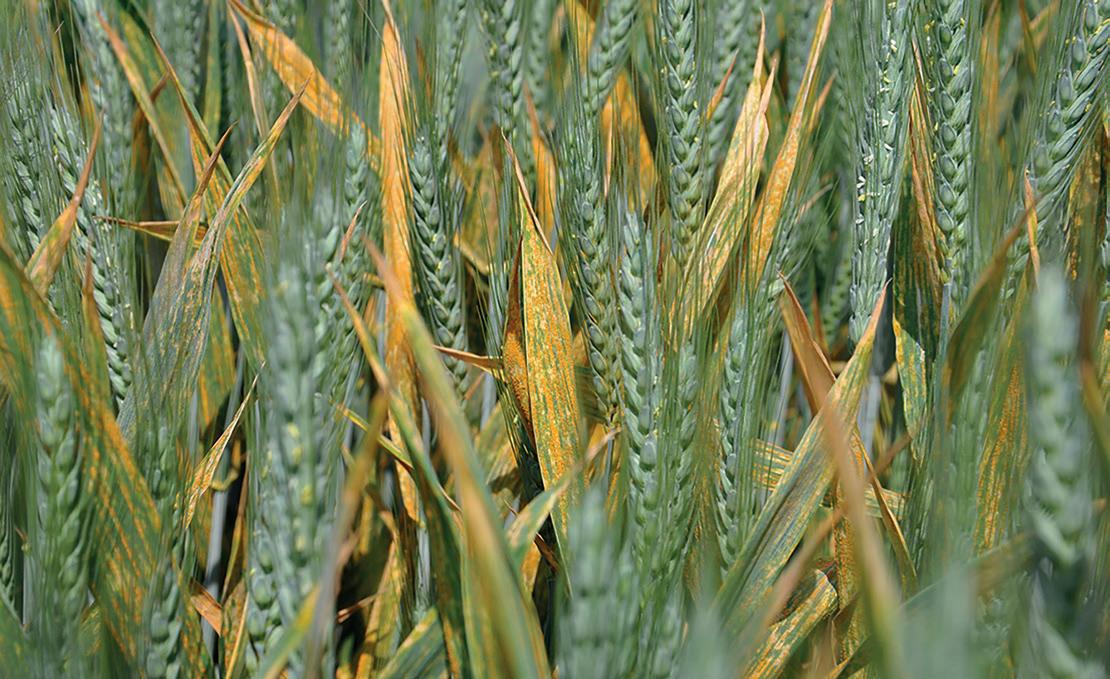
Thornton. “Just as much effort, if not more, will be needed to protect backward crops as normal ones to ensure further yield potential isn’t eroded.”
To help growers, Mr Thornton offers five key tips:
1. Do remember the importance of early disease management
While it might be tempting to ease back on early fungicide inputs if crop potential has been compromised by delayed drilling or poor winter growth, diseases are already present, says Mr Thornton, and a T0 fungicide provides a wider management tool.
“Yellow rust is already being found in crops, particularly in the southern half of the country, and it becomes more difficult to control later. Similarly, Septoria is easy to find in early-drilled crops.
“As well as targeting diseases present at application, a T0 fungicide provides a level of insurance in case the followup T1 fungicide is delayed. We saw this in 2023; in fields where T0 fungicides were omitted, Septoria exploded once the rains arrived in March.”
2. Don’t get caught out with spray timings
Accurately timing fungicide sprays to target the correct leaf layer that has emerged is essential for maximum yield protection, says Mr Thornton. But with drilling dates varying widely from September to February this season, and varieties having different speeds of development, crop growth stages will be all over the place, he notes.
“Don’t assume that just because one field has reached the correct growth stage for its T1 spray, for example, that its neighbour will also have. Fields will need checking individually – splitting stems to expose the developing leaves and counting back from the ear to identify which leaf layers have emerged.”
3. Don’t overlook the effects of crop stress
Backward and poorly-rooted plants, whether from later drilling or because they have sat in cold, waterlogged fields over winter, together with leaching of soil nutrients by the heavy winter rainfall, mean crops are likely to

arable & root crops www.farmingscotlandmagazine.com 7
be under increased stress this spring, says Mr Thornton. This makes them more vulnerable to infection, he says, particularly yellow rust.
“Use accurate soil testing to identify which nutrients need topping up. But don’t just test for the nutrient levels present in the soil. Use testing which shows the levels actually available to the plant. And consider a phosphitebased treatment such as Incite to encourage rooting.”
4. Don’t discount diseases not seen for a while
Just because a disease has not been a problem for a few years, do not assume it has gone away, says Mr Thornton. “The rootrotting effects of take-all could be exacerbated this year if second wheat has small roots because it has sat in wet soil. If we have a dry spring and summer, take-all effects are worsened.
“With more crop debris left on field surfaces due to minimum tillage, eyespot can also be hidden a threat, which increases lodging risk. Several varieties chosen for their good Septoria tritici resistance have low eyespot ratings. Make sure you know what your varieties are susceptible to.”
5. Do keep your eye on the ball
Even varieties with good Septoria resistance, when drilled early, are at risk from the disease, says Mr Thornton, so don’t let variety resistance ratings make you complacent.
Similarly, last year’s hot, dry June brought sudden yellow rust outbreaks in some areas, he says, illustrating how disease
pressures can suddenly change.
“The lesson is to ensure you have all likely disease threats covered. As a national company, we’re able to
monitor disease development around the country. Having persistent protection from the fungicide is also important,” he adds.
First ‘pulse pioneers’ recruited to farmer-led research project

UK pea and bean growers are being invited to become ‘pulse pioneers’ and be paid to carry out on-farm trials which contribute to a groundbreaking research programme.
The Nitrogen Climate Smart (NCS) Project aims to facilitate the increase of pulse cropping
from 5% to 20% in arable rotations, and displace up to half the imported soya meal used in livestock feed rations.
At least 40 farmers will be recruited and the first contracts to conduct the work have been signed this week.
“We are looking for farmers who are growing, or plan to grow, beans or peas this season and who are growing them in the

www.farmingscotlandmagazine.com
8 arable & root crops
Tom Allen-Stevens, founder of the British On-Farm Innovation Network (BOFIN), is leading the farm trials work.
rotation for the next four years,” he said.
“We will offer support and payment for them to monitor the crop. In particular we want to compare an area grown to pulses with one that isn’t over a period of four years. This rotational platform approach will enable us to monitor the benefits of pulse crops through the rotation.”
One of the first farmers to commit to becoming a pulse pioneer is Will Oliver of Osbaston House farm, Leicestershire.
Will is an award-winning mixed arable and poultry farmer with a 200,000-bird broiler coupled with 850ha of arable land which is put to winter wheat, maize, winter beans and permanent pasture countryside stewardship. Sheep also graze some parts of the farm.
“Pulses are really important to us because we’re not growing oilseed rape anymore,” Will says. “They’re our break crop with an early entry – in most years – and good for the ground as well.
“They provide a nitrogen and organic matter boost. Just having to use less bagged fertiliser in general is a positive.”
Will first heard about the NCS Project in late 2023 and decided he was interested in being part of some work to improve the understanding of the potential beans have in UK agriculture.
“I just think beans have never really had as much research into them as they deserve,” he said. “Maybe if we can fine tune how we grow them a bit, tweak varieties perhaps, we might be able to get a bit more out of them.”
His winter beans usually return between three and four tonnes per hectare with an average of 4.2t/ha in 2023. But for Will it’s not all about yield.
“People tend to call profit what you actually get in your bank at the end,” he said. “But then you can say, right, our soils are in good condition, and we’re saving a pass on our wheat establishment.
“So sometimes you’ve just got to look away from the money side of things and see what else it brings to the rotation, especially in this current climate.”
The exact details of what he wants to trial for the NCS Project are yet to be set in stone.
Algifol sales rise 25% in 2023
A supplier of an increasingly popular biostimulant has reported another exceptional year.
MJP Supplies, which distributes the seaweed-based Algifol biostimulant in the UK, has said that sales in 2023 were up 25% year-on-year.
Marcus Palmer, owner of MJP Supplies, says the increase is due to three key factors. “2023 was a very good year indeed,” he says. “We saw sales increase by a quarter largely down to larger repeat orders from satisfied customers and also thanks to sales of our 1,000 litre IBCs, which proved popular with both large-scale growers and liquid fertiliser manufacturers, wanting to include Algifol as part of their

Optimised soil bacterialegume crop combinations could reduce emissions and save Scottish farmers’ cash
The widespread reliance on man-made nitrogen fertilisers has become a significant challenge for Scottish farmers. Damaging to the environment, both in terms of increased greenhouse gas emissions and harmful water pollution, nitrogen-based fertilisers also leave farmers perilously reliant on an ever more fragile international supply chain – one that was significantly exposed by the conflict in Ukraine.
Reducing reliance on these kinds of fertilisers is a particular challenge when it comes to forage crops, as large volumes of synthetic nitrogen are needed to grow and maintain vast areas of pasture to feed ruminant livestock, like cattle and sheep.

root nodules and a specific group of soil bacteria called ‘rhizobia’”.
own mixes.
“As well as the repeat orders and IBC sales, I think we’ve also benefitted from the increased popularity of natural products, with an increasing number of growers looking to biostimulants as a way of helping their crops.”
Algifol is derived from brown algae, which is dried and refined. The result is an entirely natural liquid boasting a wealth of trace elements, vitamins, enzymes, amino acids, carbohydrates, polyuronides and growth-regulating plant hormones.
Algifol’s manufacturer, Neomed Pharma, says the biostimulant helps crops in several ways, from improving root establishment to increasing
www.farmingscotlandmagazine.com
As part of a £3.3 million research project, known as ‘NUE-Leg’ (nitrogen utilisation efficiency-legume), funded by The UK Department of the Environment, Food and Rural Affairs (DEFRA), The James Hutton Institute has been tasked with finding a solution.
Pete Iannetta, Head of Ecological Food Systems at The James Hutton Institute said: “Legumes, such as white and red clovers, have a unique ability to convert, or ‘fix’, atmospheric nitrogen gas from the air into biologically useful nitrogen that satisfies the crops’ nutritional-nitrogen requirements. They do so through a relationship between
“The project will enhance the nitrogen-fixing capabilities of selected clover varieties to improve grassland productivity. By combining the best-inbreed qualities of new legume varieties with the most efficient rhizobia, we expect to achieve a two-to-threefold increase in atmospheric nitrogen fixation. These levels can meet the grassland nutritional requirements in full”.
“In addition, the provision crops like clover make to the agri-ecosystem is organic and complex, delivering far more than just nitrogen; for example, carbon, and complex secondary compounds, to enhance soil processes and qualities”.
“Based on these results, we believe that optimising crop growth and biological nitrogen fixation should save the average 200 ha farm £22,000 in annual fertiliser costs, and offset up to 66 tonnes of carbon dioxide equivalent (CO2eq) in GHG emissions per year too.”
The James Hutton Institute is a world-leading scientific research organisation working to resolve global challenges in food, climate, energy and water security. The Institute works in partnership with people, organisations and governments to enhance sustainable environmental, social and economic development to deliver practical solutions for our shared future. www.hutton.ac.uk
arable & root crops


disease resistance and reducing the effects of extreme weather.
One grower who has been exceptionally pleased with the results Algifol has delivered last year is Andrew Meginson of J K B Megginson & Sons Ltd in Driffield. “We’ve had a really good result with Algifol last year. The canopy stayed lovely
and green throughout the season despite some very challenging weather, which I’m sure was causing stress to potatoes not treated with Algifol. The yield was up, and we were delighted with the uniformity of size and the overall quality of the crop when it was lifted. We will be using Algifol again for sure!”
New urea inhibitor from Timac Agro UK cuts ammonia emissions
Timac Agro UK has launched a new urea inhibitor, Excelis Maxx, proven to reduce nitrogen losses by up to 90% and therefore improve nitrogen efficiency.
Rules on the use of inhibited urea fertilisers were confirmed by Defra last year, with applications to crops after 1 April 2024 needing to be inhibited, if containing more than 1% urea, to slow the release of ammonia.
Nico Papworth, commercial director at Timac Agro UK, says the innovative product combines the inhibitor, NBPT (N-(n-butyl) thiophosphoric triamide), with a patented microbial activator to increase nitrogen efficiency and reduce ammonia emissions.
“The NBPT in Excelis Maxx in combination with the unique Rhizovit complex inhibits urease enzyme activity to allow time for it to be utilised by the plant and the soil, while increasing the efficiency of N already in the soil,” he says.
Excelis Maxx can be applied as a coating to urea granules or incorporated into liquid urea to comply with the upcoming legislation.
Urease inhibitors reduce nitrogen volatilisation by slowing down the conversion of urea to ammonia, making treated urea more efficient, as more nitrogen is retained in the soil for plant use.
Mr Papworth says this can cut down the amount of
www.farmingscotlandmagazine.com
subsequent nitrogen applications required.
Excelis Maxx unique patented microbial activator complex, Rhizovit, which works in combination with NBPT to stimulate soil microbial life, further enhancing the availability of the soil’s natural nutrient reserves.
Mr Papworth says: “Excelis Maxx has also been proven to increase the value of this treatment, is in its ability to penetrate the urea granule for extended protection.
“It penetrates the granule by up to 100% more than other inhibitors on the market, which means the level of protection is consistent throughout the treated urea.
Typically, NBPT inhibitors can be sensitive to oxidation once they have been exposed to air, which affects the efficacy of the inhibitor and the nitrogen itself.
To prevent this, the addition of garlic-based phenolic extracts (antioxidants) helps to stabilise the product and extend the shelf life of the treated urea by over 2 months once opened or in a bulk environment.
“Growers need look beyond meeting immediate legislative requirements, selecting options that promote soil health, crop performance and are economically viable,” Mr Papworth finishes.
For more information about Excelis Maxx, please contact your local Timac Agro UK distributor.
10 arable & root crops
The Scottish seed potato industry faces up to increasing challenge from virus
Scottish seed potatoes are renowned for their unrivalled quality. In particular, the cool climate in Scotland has ensured its seed potatoes have a reputation for the best virus health in the world.
However, as a result of climate change, along with other factors such as the loss of insecticides, the challenge from aphid-borne viruses (particularly Potato Virus Y and Potato Leaf Roll Virus) has increased substantially - as demonstrated by the increased loss of seed potato crops to virus infection across Europe.
In order to meet the challenge of the increasing virus threat, representatives of all sectors of the UK potato industry1 met at a Virus Summit in early December organised by the Potato team at SRUC/ SAC Consulting and hosted by the Plant Health Centre at The James Hutton Institute. A number of sponsors provided funding for the event2.
The Summit comprised of a morning of short, technical presentations reviewing the current situation from a range of viewpoints, and an afternoon of workshops where options to meet the virus challenge were discussed and action points established.
The Summit focussed on establishing short- and longer-term actions that would enhance the industry’s ability to continue to contain the increasing virus threat.

Farmers Offered Free Dyslexia Assessments
Scottish agricultural charity RSABI has been working with Dyslexia Scotland to raise awareness of the challenges many people involved in farming face with dyslexia by offering free dyslexia assessments.
The campaign which launched during November’s Scottish Dyslexia Awareness Week has now been extended until the end of March.
Around 25% of Scotland’s farmers are estimated to have dyslexia, with assessments costing approximately £500. RSABI are offering those working in Scottish agriculture, aged over 40, a free professional assessment. Assessments can be requested by contacting RSABI’s 24-hour freephone Helpline - 0808 1234 555.
To raise awareness, RSABI launched a powerful video interview with Fife farmer Pete Black, who farms at Newton of Collessie, about the impact of dyslexia on his life and farming career.
He said: “When I was at school in the 1990s dyslexia wasn’t spoken about very much, but I knew I was always last to finish my reading,”
“I am lucky to do a job I love but it was a great relief to me to discover that I had
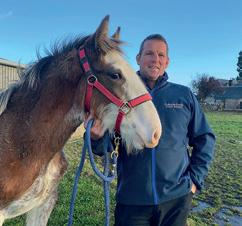
dyslexia and to know that the reason I was struggling wasn’t down to a lack of effort or not trying hard enough.
“My advice to any young person, and especially those in farming, is dyslexia should not hold you back in any way.”
Carol McLaren, Chief Executive of RSABI, said: “We are regularly contacted by farmers who are struggling
with dyslexia and we know it can be worrying and distressing to be struggling to read and understand information, particularly for farmers with dyslexia living on their own.
“We hope that by working with Dyslexia Scotland and offering the free assessments we can help improve understanding of dyslexia and the challenges these farmers can face.”
To view the video interview with Pete Black about life and farming with dyslexia visit: https://youtu. be/jIM6bKZFetU
For more information about RSABI’s free dyslexia assessments please visit www.rsabi.org.uk or call 0808 1234 555.
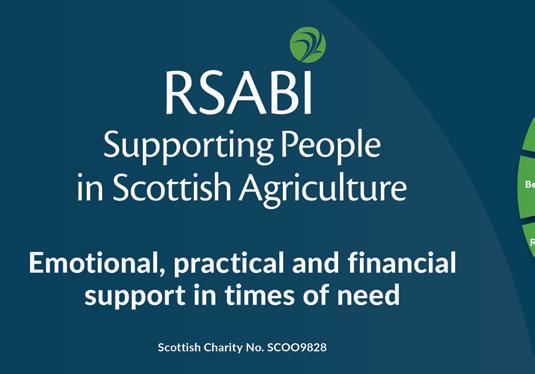
RSABI offers free practical, financial, and emotional support including counselling services, delivered quickly after receiving the initial enquiry. Its free confidential support service is available 24 hours a day, every day of the year, by calling 0808 1234 555 (calls won’t show up on phone bills) or through a confidential webchat service, available on RSABI’s website www.rsabi.org.uk.
In all, over 30 action points were determined across 10 aspects of production. These included ways to enhance the biosecurity in seed growing areas such as careful siting of seed potato crops away from virus sources and increased monitoring of nearby ware crops. Other actions proposed were to encourage growers to adopt new IPM techniques such as use of straw mulch to deter aphids landing on the potato crop and a continued move to reduce generations of seed multiplication. It was recognised that greater integration of virus control measures would be required in the future.
The Summit also identified knowledge gaps which require future scientific research to improve control of aphids and virus transmission.
Outcomes from the Summit will be considered in the coming months by the relevant authorities (e.g. SASA and RPID), and the Scottish Aphid Borne Virus Working Party3 and implemented as appropriate. However, it was agreed that all sectors of the potato industry needed to work together to meet the virus challenge.
The Summit delegates were confident that the virus challenge could be met, and the Scottish seed industry would continue to produce the quality demanded by domestic and export markets.
Arable farmers need to rethink herbicide strategies`
With some fields still under water following widespread flooding in January, farmers will need a robust herbicide plan in place as they battle to catch up this spring.
A wet autumn delayed drilling of many winter cereals, causing a backlog of fieldwork that will need to be fulfilled as quickly as possible.
Those who did manage to drill their wheat will also need to review their herbicide strategy following the bad weather.
“We’ve had a number of difficult seasons in a row, and each poses a new challenge for arable farmers,” says Corteva Agriscience’s Cereal Herbicides Category Manager Alister McRobbie. “The past couple of years have been very cold and dry, but we’re facing the opposite in 2024.
“Parts of the major wheatgrowing areas of the UK are either under water or suffering from saturated soils, so it will be a while before there is any onfarm activity in badly-affected areas.
“Those with a compressed fieldwork schedule should plan ahead, decide on their herbicide programme in advance, and make sure it’s in store ready to go.”
Those farmers who managed to drill wheat last autumn will also need to rethink their strategy as it is unlikely they will be able to rely on the activity of their pre-emergence applications.
“A lot of the wheat drilled would have received a preemergence herbicide, but there has been so much water it is likely this will have been washed through the soil profile,” adds Alister. “It won’t have worked very well, so there will be a need to control grassweeds such as brome, ryegrass and wild oats relatively early.”
The performance of autumn residuals will undoubtedly be impeded by the wet conditions, making a spring clean of weeds even more essential than usual.
Broadway Star is a mainstay of spring grassweed control programmes and will be among the first products applied as soon as the opportunity to get sprayers working presents itself.
It gives excellent control of brome species, ryegrass, wild oats and a range of broad-leaved weeds in winter wheat and also has approval for use in spring wheat.
“Generally, we don’t recommend applying a residual alongside Broadway Star, but this season we would advise it –Broadway Star is contact only, so it will kill the weeds there at the time
of application and a residual will remain in the soil and eradicate grassweed seeds as they are germinating, before they get too big,” Alister explains.
Broadway Star also controls a range of difficult broad-leaved weeds, including cleavers, charlock and cranesbill, so there is usually no need for a broadleaved weed follow up spray.
“If you just need to target broad-leaved weeds, it’s better to take them out early with Arylexbased products such as Zypar or Pixxaro,” Alister says. “Get this on in a timely manner and take weed competition out early to avoid them competing with the crop and negatively impacting yield.
“There will be a lot of demands on farmers’ time this spring but cutting corners and overlooking weed control won’t help in the long run.”
Tank mixing with plant growth regulators, fungicides and trace elements will help reduce the number of sprays applied to crops in the busy spring period. This will be especially helpful with the expected increase in spring drilling work. However, farmers should ensure they don’t neglect sprayer hygiene in order to avoid contaminating subsequent loads.

arable & root crops www.farmingscotlandmagazine.com 12
A sustainable and profitable future for Scottish agriculture
NFU Scotland lays out strategic policy priorities and key asks
In its pursuit of a sustainable and profitable future for Scottish farmers and crofters, NFU Scotland has set out its policy priorities and key asks.
In a document launched at the Union’s National Conference and AGM in Glasgow last week (8 and 9 February), the Union has identified eight strategic policy goals. If delivered on, this will enable farmers and crofters to deliver the economic, environmental and social outcomes which governments and communities aspire to.
It states that delivery on these priorities is essential as a successful and prosperous Scottish agricultural industry is key to a successful and prosperous Scotland. Agriculture is the backbone of Scotland’s wider food and drink industry – a sector that’s worth £16 billion to the Scottish economy, employs 130,000 people, and supports Scotland’s national reputation on the world stage.
The priorities and asks are:
• Future Support - Activity driven, accessible and adequately funded measures.
• Fairer Supply Chains - Improved margins in existing and new markets.
• Rural Economy - Opportunities for enterprise and business development.
• Better Regulation - Legislation that is enabling and proportionate.
• Public Perception - Connect with people to change perceptions.
• Effective ConservationBalance in the delivery of biodiversity.
• Optimal Land Use - An integrated approach to land management.

• Climate Change - Recognition and reward for climate actions.
Launching the document in front of 400 delegates, NFU Scotland’s Director of Policy Jonnie Hall said: “Whilst there have been many changes in farming and crofting over the years, the one thing that has remained consistent is our steadfast commitment to supporting our members and the relentless pursuit of a better future for Scotland’s farmers and crofters. As a result, our vision is clear: A sustainable and profitable future for Scottish agriculture.
“Scottish agriculture is under severe pressure. In recent years, farmers and crofters have faced
spiralling costs of production, continuing labour shortages and more extreme and volatile weather, whilst output prices across most commodities have remained static at best. Margins continue to be under significant pressure as supply chains and market behaviours are driven by food prices as retailers focus on consumers rather than primary producers.
“As farmers and crofters seek to respond to these challenges, they also face an unprecedented level of policy and regulation as Governments in both Holyrood and Westminster pursue agendas to tackle significant social and environmental issues which Scotland’s farmers and crofters are uniquely placed to respond to.
www.farmingscotlandmagazine.com
“As the dominant land use in Scotland, active farming and crofting is the key to helping meet climate and biodiversity needs while underpinning rural communities and producing food of the highest quality.
“The next few years will be pivotal for Scotland’s farmers and crofters. If the Scottish and UK Governments, and their agencies, take a positive and pragmatic approach to our eight priorities and 34 key policy asks it will enable a sustainable and profitable future for Scottish agriculture – not least for the next generation and beyond. In turn, this will support thriving communities, given their economic and social reliance on the industry.”
13
ARTICLE

FLAVOUR OF SCOTLAND Champions!
Scotch Butchers Club Team Scotland win at the Four Nations Butchers tournament
Team Scotland - Perth-based father and son butchery team Richard and Ben Megahy – have triumphed at the Four Nations Butchers Tournament in Ireland. They saw off hot competition from leading butchers from England, Northern Ireland and Ireland in the contest, with judges praising their skills as being ‘absolutely superb’.
Six weeks of intense practice saw the pair work in a way that judges said was ‘bordering on telepathic’ as they prepared, crafted and presented a range of 40-50 products and created a retail display with the ‘wow factor’ – all within an hour.
The judges added: “The father and son team worked in unison. The skill levels shown by Richard and Ben were simply fantastic, with their attention to detail bringing them the title.”
The Scotch Butchers Club and Browns Food Group, which produces much of Scotland’s Specially Selected Pork, sponsored the victorious team’s trip to the competition at the Irish Craft Butcher Expo held at The Curragh Racecourse near Dublin. The pair worked with products including a loin of pork, half a lamb, two chickens and a shoulder of pork.
Besides the preparation and presentation in such a short timescale, each team also had to have a theme, with marketing collateral to support their display. Team Scotland triumphed despite their display being held up in Irish customs, forcing a hasty visit to a local garden centre for replacement floral decorations.
Gordon Newlands, who manages the Scotch Butchers Club for Quality Meat Scotland, said: “I am thrilled and delighted
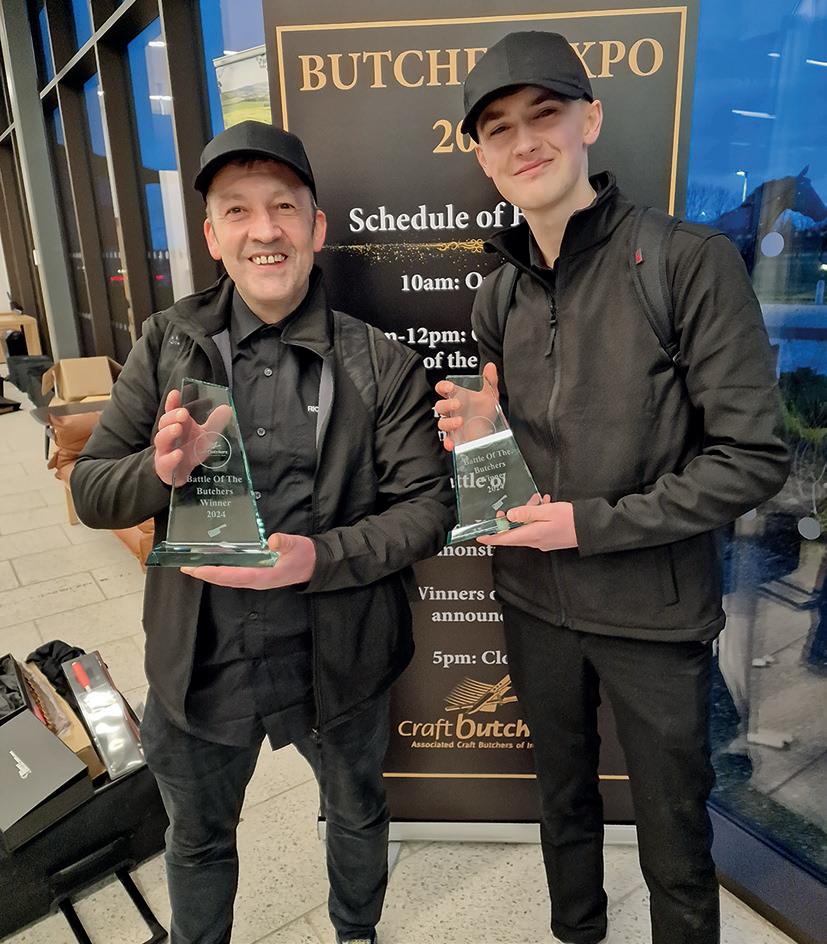
for the boys, but it shines a spotlight on the whole of the Scottish butchery sector as a valued and important trade.”
Richard has been a butcher with Perth-based Simon Howie for 27 years while Ben, who is 21, has been working for the business for almost two years and is currently completing his SVQ.
Gordon added: “Ben, at 21, embodies the spirit of youth, and has a great work ethic along with his father, who in the past has been Scottish butcher of the year. It is fantastic that we are returning from Ireland as international champions!”
The team had plenty of support, with 15 members of QMS’s Scotch
www.farmingscotlandmagazine.com
Butchers Club attending as part of a trip to the Expo and to visit leading Irish butchers to gain ideas and inspiration. “The whole weekend allowed members to network with their Irish counterparts and gain knowledge. Friends were made, and contacts that members can use in their own businesses for help and ideas,” he said.
14

Scottish sizzle added to the sausage market
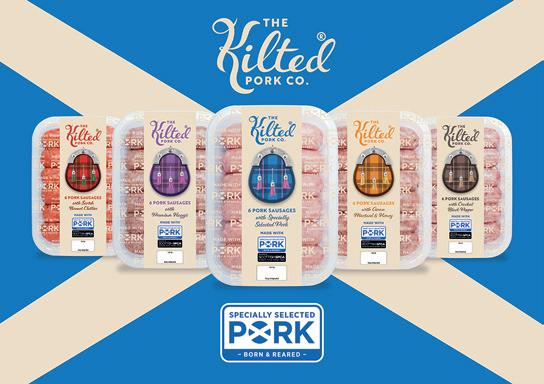
Scottish sausage shoppers are being encouraged to “Seek out the Sporran” on shelves following the launch of a new line of branded bangers from The Kilted Pork Company.
Supermarkets throughout the country have been filling up with this new sausage range from Scotland’s biggest pork supplier which aims to showcase Scottish pork while tantalising tastebuds with some new and different flavour combinations.
The packs feature a prominent tartan sporran logo and the sausages are made from 100% Specially Selected Pork - meat that was born, reared and processed in Scotland.
The quality assurance labelling means the meat is produced and independently assessed to the highest standards of welfare.
There are five products in the range – for those that like to keep things simple there’s Specially Selected Pork on its own and, for those that want to ring the changes, four delicious flavoured varieties of Specially Selected Pork with Cracked Black Pepper, Premium Haggis, Scotch Bonnet Chilli and Arran Mustard & Honey.
With an RRP of £3.30 for a pack of six, Kilted Pork Company sausages are available in store now at most key retailers in Scotland including Tesco, Sainsbury’s, Coop and Asda.

Scotland The Brand
Clear Provenance is Key to Adding Value to our Native Breeds
By Ruth Watson
Wool used to be a crucial source of income for farmers but, in recent years, that value has plummeted. Across the country, determined efforts are being made to join the thread between fleece and finished garment.
“I was running a knitting group, and we were interested in wool from native breeds. We looked up what the rarest breed was – the Boreray - and thought the wool would be selling at a premium because it was so rare, but we found none,” explains Jane Cooper, then a keen knitter living in Newcastle. Jane now is a farmer and the driving force behind the important Orkney Boreray flocks.
The Boreray are an almost pure descendant of the Scottish Dunface – the breed which ran alongside Highlanders until the Clearances saw the people shipped away and the little sheep replaced by the Scottish Blackface. The Scottish Dunface was declared extinct some time ago – but the DNA of the Boreray tells a different tale. The story of the Orkney Boreray is captivating and Jane Cooper’s book, ‘The Lost Flock’, is a compelling read. Jane argues, with a reason which is hard to dismiss, that the breed is such an important
part of Scotland’s heritage, it should be given both national recognition and protection.
Meanwhile, a new brand using 100% Scottish Blackface wool from local farms has been launched by the team at Galloway and Southern Ayrshire UNESCO Biosphere (GSAB): Merrick Scottish Blackface Knitwear. The team worked with British Wool to find the artisans in Selkirk and Leicester who could take the fleece from the farms, spin it into yarn, and make the high provenance clothing range. The hope is, with time, to have this skilled work done in Dumfries and Galloway.
“Hill farming and the heritage around that is so important here. Blackface sheep is an important breed for our area, and we wanted to show the quality of the Blackface wool as well as do something constructive to create high value products using the Blackface fleece,” Marie McNulty, Business Development lead for GSAB, told me.
Scotland needs better infrastructure, from local abattoirs to wool processing, tanneries, and so on: the kind of facilities which create skills and opportunities, and ensures that all-important provenance.
Ruth Watson is the founder of the Keep Scotland the Brand campaign
www.farmingscotlandmagazine.com
FLAVOUR OF SCOTLAND
SCOTLAND MAGAZINE
issue out May 2024
page 36
FARMING
Next
Subscription
NFU Scotland ShelfWatch identifies mixed support for Scottish produce in leading supermarkets
Findings from first ShelfWatch of year appears to highlight strong support for British producers
Initial analysis of the research undertaken on behalf of NFU Scotland has revealed which supermarkets are stocking Scottish produce, providing the Union with a clearer picture of what and where consumers are able to purchase locally produced goods.
Over a 48-hour period in late January, an independent research firm visited 71 stores across mainland Scotland. Researchers looked at beef, lamb, pork, chicken, eggs, vegetables and dairy products (milk, cheese, butter and yoghurt) on offer in Tesco, Asda, Morrisons, Sainsbury’s, Co-Op, Marks and Spencer, Lidl and Aldi stores. In all over 15000 products were reviewed. Researchers reviewed the country of origin of products being offered by the stores’ own brands to identify if they were Scottish, British or imported. Soft fruit is not included because it is currently 100% imported due to seasonality.
All retailers involved in the survey were notified in advance and invited to join a panel session at the AGM to discuss the results and outline their commitments to support Scottish farmers and crofters.
The results show:
· Aldi has the largest percentage of Scottish produce overall (48.7%).
· Sainsbury’s has the lowest percentage of Scottish produce overall (7.6%).
· Three retailers (Asda, Tesco and Sainsburys) have less than 10% Scottish products overall.
· The largest percentage of other produce was UK.
Breaking the results down into categories:
• Aldi had the largest percentage
of pork, bacon and sausages labelled as Scottish. Six retailers had no Scottish labelled pork. Most of the non-Scottish pork was UK. Asda (33%) and Tesco (17.3%) are importing fresh pork.
• Aldi, Lidl and Morrisons had more than 70% of Scottish beef. The largest amount of beef in other stores came from UK. Tesco and Sainsburys had Irish beef, the largest was Sainsburys with 10.4%.
• Lidl had the largest percentage (100%) Scottish lamb followed by M&S with 83.6%. Two retailers (Asda, Co-Op) had no Scottish lamb. Four retailers, Aldi, Asda, M&S and Tesco, had imported lamb with 55% of lamb on Asda shelves imported.
• Aldi had the largest percentage (86.7%) of Scottish chicken followed by Co-Op with 73%. Two retailers, Tesco and Sainsburys, had no Scottish chicken.
• Aldi had the largest percentage (100%) of Scottish eggs, Lidl had 96.4%.
• Aldi had the largest percentage (100%) of Scottish potatoes, Tesco was the lowest with 6.4%.
• Aldi had the largest percentage (61.8%) of Scottish vegetables and Co-Op was lowest at 4.8%.
• M&S had the most Scottish milk (62.4%), Tesco had the lowest (30.7).
Sharing these high-level results from the Shelfwatch survey with delegates at the NFU Scotland Conference in Glasgow today (Thursday 8 February), NFU Scotland Chief Executive John Davidson said; “The results from the Shelfwatch survey unveil a completely mixed bag of what
is going on in shops across the country and available to Scotland’s consumers. While it is encouraging to see that there is strong support for Scottish and UK produce in general and examples of some retailers stocking 100 percent Scottish, others appear to have absolutely none on their shelves in some sectors.
“Clearly more can be done to ensure consumers are able to source more locally produce. This also begs some questions on labeling and marketing and whether consumers have full transparency of the origin.
“These results provide us with a fantastic opportunity to not only hold retailers to account and accurately highlight to our consumers what’s going on in some shops, but also enables us give credit to those who are tremendous supporters of local food production within Scotland.
“We have loads of new data to analyse. We aim to use the good examples and results from this survey, the first of four planned for this year, to celebrate good practice and highlight how consumers and retailers can build their support for the amazing produce from our Scottish farmers and crofters. Nobody wants to rely on cheaper, imports exasperating a deepening food security crisis. Our farmers and crofters can deliver on so many levels given the right conditions to support and help deliver a thriving economy, environment and rural communities.
“Similarly, we will also use these positive results to inform discussions we have with those retailers who have been identified as having zero or low levels of Scottish produce available, to

better understand any sourcing challenges they have and look to resolve these.
“The ways in which Scottish consumers can support local produce through the likes of local shops and butchers, farm shops, farmers’ markets, and direct sales from the farm are growing. But supermarkets remain the dominant force when it comes to food sales. To succeed in our ultimate goal of seeing more Scottish produce stocked, priced and promoted on the shelves of supermarkets across the country appropriately and primary producers fairly rewarded for their critical role in the supply chain, we will need a collaborative approach with retailers and other key stakeholders including Governments to take ownership of their role within each supply chain.
“This Shelfwatch provides the ideal platform to benchmark against over the year ahead when looking for improvements in the marketplace and for these essential discussions with supermarkets on responsible treatment of suppliers and guaranteed delivery of a fair price to producers for the food they produce.”
food & drink www.farmingscotlandmagazine.com 16
food & drink British cheese takes centre stage in Vegas

Dairy exporters have taken centre stage in Las Vegas to showcase world-class British cheese at an exclusive event for key buyers.
Sixteen exporters took part in the Agriculture and Horticulture Development Board (AHDB)hosted British Cheese Night at the Foundation Rooms, Mandalay Bay Hotel.
The event, which coincided with the Winter Fancy Food Show, brought together exporters with existing and potential customers. It attracted more than 80 high end buyers from hotels and retailers, chefs and distributors and included cheese displays and tastings, underlining what British dairy exporters have to offer.
Lucy Randolph, AHDB Head of International Trade Development (Dairy), said: “Our British Cheese Night was a great success. This is the second year we have run this event which provides a fantastic opportunity for British cheese exporters to showcase their world-class
products to high end buyers in this sought after venue. Last year’s event helped deliver some significant business wins for exporters who took part and our ambition is for this year’s event to replicate and build on that success.”
The US is the UK’s second biggest dairy export market and AHDB analysis has highlighted further opportunities over the next decade with increasing levels of cheese consumption.
Lucy added: “There are considerable potential long-term opportunities in the US for the British dairy sector, building on our current successes in that market. AHDB is committed to working with industry to capitalise on those opportunities and our British Cheese Night has a key role to play in helping realise that ambition.
“Our aim is to grow the event to become the go to annual dairy showcase in the industry calendar for buyers in the US and help our exporters gain a stronger foothold in the US market.”
www.farmingscotlandmagazine.com
Working for Scottish farming
 By Mairi Gougeon, Cabinet Secretary for Rural Affairs, Land Reform and Islands
By Mairi Gougeon, Cabinet Secretary for Rural Affairs, Land Reform and Islands
Scottish farmers make a significant contribution to our economy and to the success of Scotland’ food and drink sector. And despite input costs increasing, output also increased by 10%. That helped average farm incomes rise to the highest level since 2012 in 2021-22.
Yet, this success is precarious. More certainty is needed, not least in relation to funding - there is still no UK Government funding commitment from 2025.
And of course, we could all use more certainty on Brexit –with fewer surprise decisions.
The Scottish and Welsh governments learned that notfor-EU labelling would be imposed on all intra-UK trade at the same time as farmers –when the UK Government published their plans.
The UK Government is either choosing to overregulate through Brexit - notfor-EU labelling will put additional costs onto many businesses already facing export barriers.
Or it is choosing to underregulate. I welcome that there will be a new regime for personal imports of meat to help keep Scotland free from devastating diseases like African swine fever.
But these controls should have been in place last autumn.
No one knows what an open border at Cairnryan
with no biosecurity checks at all, might result in.
Scotland is rightly proud of its current TB free status in its herds, but that status might be harder to maintain if we cannot control livestock movements from Northern Ireland where tuberculosis is devastating farm businesses and families’ livelihoods.
We do not want the same for Scotland.
Provenance is key to your current and future prosperity.
Thanks to our high animal welfare standards, your hard work and everyone’s willingness to pay a premium for Scottish produce, everywhere you go, what you and our food and drink sector produce is valued and valuable.
We need to do all we can to protect that and to maintain Scotland the brand’s reputation, especially for our food and drink.
I will not allow the UK Government to do anything to subsume our brand within a misguided country of origin labelling regime that only allows products to be branded as British.
That would threaten our high production standards, diminish transparency undermine our nation’s food security and risk Scotland’s reputation for quality and integrity.
It could also result in a race to the bottom on price, with the premium that you get from your produce gone.
That is why the Scottish Government supports NFU Scotland’s call for food labelling changes that will underpin the nation’s food security and bolster domestic production of high-quality food.
I want Scotland the brand to flourish – and for your farming and crofting businesses to thrive in the process.

Strong result for Lantmännen… new record dividend to Swedish farmers
Lantmännen’s result for 2023, after net financial items and adjusted for items affecting comparability, amounted to 2 462 MSEK – a slight decline compared to the previous year’s record result of 2 536 MSEK.
“Despite an unsettled geopolitical situation and a weaker economy, Lantmännen delivered a strong result for the full year of 2023. In particular, the Energy Sector, Swecon Business Area and our international businesses in
Lantmännen Unibake reported very good results for the year, while the Swedish food operations had a much tougher time,” says Magnus Kagevik, Lantmännen’s Group President and CEO.
The figures below refer to operating income adjusted for items affecting comparability. The previous year’s results in parentheses.
The Agriculture Sector’s result amounted to 477 MSEK (516). The result has decreased
in the international interest holdings and in the sector’s Swedish operations, which were hit hard by the weak harvest during the second half of the year. The result in the Finnish agricultural operations increased.
The Energy Sector reported a result of 968 MSEK (1 165). The lower result is due to a lower average ethanol price compared to last year’s very high levels. The price drop in ethanol has partly been compensated by a decline in raw material
price. Lantmännen Aspen and Scandbio continue to develop positively.
The Food Sector’s result amounted to 730 MSEK (528), entirely due to higher earnings in Lantmännen Unibake’s international businesses. The result in the Swedish food operations is significantly lower than the previous year. The higher inflation and rising interest rates has led to a shift in consumer behavior, with a stronger focus on discount products.
Joint IFAD and IDB project in Brazil will improve the lives of 210,000 rural people in the semiarid Piauí State
The UN’s International Fund for Agricultural Development (IFAD) and the Interamerican Development Bank (IDB) have joined forces to increase small-scale farmers’ income, and improve food and nutrition security, in the Piauí-Canindé basins, reaching 210,000 poor rural people in Piauí, one of the poorest regions in Brazil.
The new jointly funded Sustainable and Inclusive Piauí project (PSI), which was launched recently together with the government of Piauí, will also improve access to basic services including water and sanitation and will support rural
communities to adapt to climate change.
IFAD is providing a US$18 million loan; IDB, a US$ 100 million loan; and the state of Piaui is contributing US$ 29.5 million to the overall project cost (US$ 147.5 million).
Rossana Polastri, IFAD’s Regional Director for Latin America and the Caribbean, stressed that this is the first jointly funded project between IFAD and IDB in Brazil. “The partnership with the IDB allows IFAD to step up investments in environmental recovery, healthy nutrition, and digital solutions, while scaling up our operations
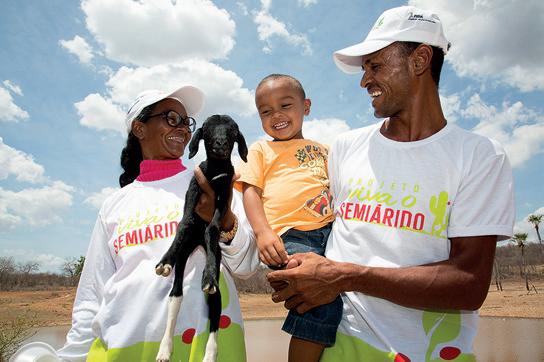
www.farmingscotlandmagazine.com 18
WORLD FARMING
in water and sanitation, in line with our goal to boost the sustainable development of
rural families in one of the most vulnerable regions of Brazil,” she added.

Four-wheel FarmDroid –Extra versatility for energy-independent seed-and-weed robot
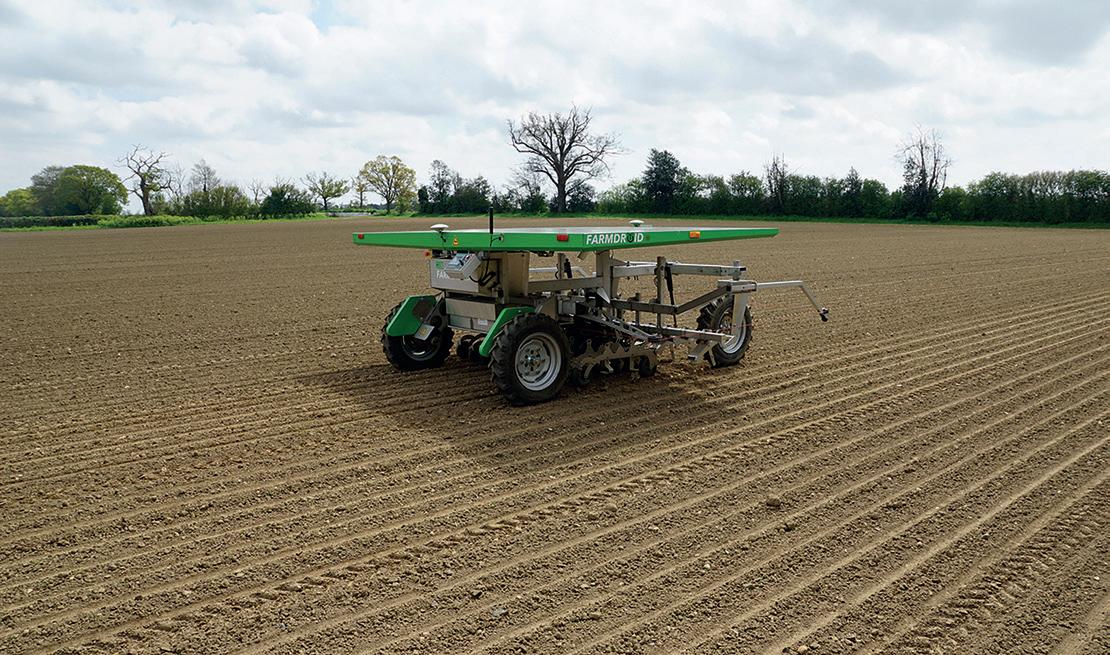
In what was a last-minute addition to the OPICO stand at this years’ LAMMA, the company had a four-wheeled version of the solar-powered FarmDroid on display at the event.
Until now the autonomous seed-and-weed robot has only been available in three-wheeler format, limiting its ability to operate in certain specialist applications such as with salads and herbs grown on narrow rowspacings.
The four-wheeler changes all that. With pairs of wheels running in the same tracks front and rear, the unit can effectively straddle the rows of crop, enabling it to plant seed into flat beds and return subsequently to weed between the seedlings without running any crop down.
Ultra-precise RTKcorrected GPS guidance means the FarmDroid can work autonomously, returning to the same wheelings time and time again with less than 5mm
deviation from the original line of work. This same technology is what makes it possible for the machine to record exactly where it plants each seed, enabling its knife-shares to weed to within 5mm of each seedling.
Having a wheel at each corner also means this latest version is more stable on sloping ground. By reducing the opportunity for a shift in weight distribution when the unit is traversing inclines, the extra wheel means traction is maintained and reduces the need
for the addition of extra ballast to retain grip in tough going.
This latest development is the first of a number of innovations set to widen the FarmDroid’s scope of operations in the UK.
The Danish firm is working on a range of new technology that will give its machines even greater appeal to a wider audience, particularly those looking to reduce pesticide use, move towards energy independence and automate certain operations.
www.farmingscotlandmagazine.com 19 science & technology
FarmDroid 4 Wheel Seeding & Weeding Robot, weeding commercial organic onions in East Anglia

PowerGuard: Cultivating a Greener Future for Farming and Agriculture Through Innovative Power Solutions
In the heart of rural Lincolnshire, England, an electrical equipment manufacturer named PowerGuard has been quietly revolutionizing the way businesses tackle their power challenges since 1999.
Originally specialising in life-critical power for emergency equipment, they branched out into infrastructure-critical power machines that solve many common power problems in agriculture. Although based in Lincolnshire, they have their power solutions helping customers in places from Loch Carron to Turro and as far as South Africa, Malta and Spain.
PowerGuard has become a beacon of green innovation, offering a range of solutions that empower farming and agriculture to navigate the complexities of modern energy demands. Farming Scotland takes a closer look at some of their solutions.
Off-Grid Power: Power to Remote Places.
One of PowerGuards’ standout solutions is their comprehensive off-grid power system.
As the landscape of agriculture changes, farmers are increasingly looking for other income streams, whether that be farm shops, barn renovations, holiday lets or even building
accommodation or houses for their farm workers.
If the chosen location has no easily accessible mains electric connection, then PowerGuards solution is a fantastic alternative to paying for grid infrastructure to be installed.
PowerGuard not only manufacture an off-grid system, but they also write all the control programmes and build all their own PCB’s allowing for a bespoke programme to work exactly as the specific project requires.
They offer systems from 3KVA all the way up to a staggering 500KVA and can build systems in both 1Ø and 3Ø.
One great example is when PowerGuard were approached by a farmer whose farm spread across 3000 Acres. He was in the finishing stages of building 3 houses, soon to be occupied by 3 of his workers’ families.
This consisted of two semidetached properties and one detached larger property, with heating and hot water provided by 3 electricity driven air source heat pumps (ASHP).
At the time of building the properties he had agreed to purchase a Grid mains connection at £60,000. When the build was fully underway, he contacted his District Network Operator again

to schedule the works. He was shocked to be told that the price had risen to £76,000 overnight with no real explanation, causing him to search for alternatives. It was then that he happened to come across PowerGuards website and made contact.
PowerGuard formulated a single system to power all three properties from a purpose-built steel framed outbuilding as a plant room. The 30KVA system consisted of their PS control system, 30KVA of invertors, 2 x 1000Ah batteries at 48V giving a huge 48KWh of usable storage, while cleverly only discharging the battery to 50% to maximise battery life for the customer. With a 30KVA backup generator the system functions autonomously, only bringing in the generator to charge that battery to power the site.
This reduces the generator run time to at least one third of a day. However, with the addition of solar panels the system becomes a cost saving force of its own. PowerGuard used every inch of spare roof space, including the purpose-built plantroom, achieving 25.2KW of solar.
This had the dramatic effect of powering the houses from March until late October on solar and batteries alone, with zero hours recorded on the generator,
including providing all the hot water via the three ASHP.
The icing on the cake for the customer was PowerGuards suggestion to add three electricity meters, one for each property. This allowed the farmer to charge the tenants for the electricity they consumed, transforming the farmer into an independent energy provider and a great yield on the capital expenditure used to purchase the system.
In comparison to spending money on a grid connection and being at the mercy of ever rising electricity costs the return on a PowerGuard off-grid system with renewable energy is staggering. At the start of 2023, commercial electricity prices reached peaks of 90p per KWh. A system like the one described has the ability to provide the properties with the equivalent of £9,000 worth of electricity at those rates. Although electricity prices have come down a lot since then, the customer has reassurances that when they inevitably reach those heights again in the coming years, the PowerGuard off-grid system hedges his business risk against those rises and against any power cuts from the National Grid.
Hybrid System: Unleashing Solar Potential
PowerGuards Hybrid system is a

IN
www.farmingscotlandmagazine.com 20
15KVA off-grid system
Solar install
variation of their off-grid system, only it takes its back up power from the national grid where one is already present. It can be set up with a double back up in parallel with a generator, or simply just the grid-connection.
The benefits of this system over traditional grid connected solar are very interesting. Agriculture business often find themselves heavily constrained by the limitations imposed by local electric providers, such as Distribution Network Operators (DNOs)
Large grid connected solar arrays and battery storage require permission from the DNO to install. Permission will entirely depend on the existing grid infrastructure in the businesses area. In a traditional grid connected system, excess solar generated electricity is sent back to the grid. This can cause significant problems for the grid, particularly in rural areas, where farms often find themselves at the end of the electrical line, and gaining permissions can not only be costly, but heavily restricted.
PowerGuards innovative hybrid system addresses this challenge by maximizing solar utilization without feeding excess energy back into the grid. As such, they can attain as many solar panels as the electricity consumption of the business requires. Agriculture businesses often have the luxury of ample outbuilding roof space but are restricted to a fraction of the solar they need.
By incorporating a substantial battery storage system, this solution enables farmers to harness the solar energy they need, breaking them free from imposed panel limits.
A great example of its application is a poultry farmer PowerGuard has been working with. The farmer owns four farms
and all of them are high electricity users. The businesses use an astronomical amount of power with fans keeping the poultry sheds cooler in the summer and warmer in the winter distributing the heat generated by gas and biomass burners. All four of his sites are restricted in solar capacity to 50KW of solar. This is only a fraction of the site’s electricity usage. PowerGuard, can provide a 250KVA hybrid system, a huge 1550Ah x 480V battery giving up to 558KWh of usable storage and 600 more solar panels at 252KW, increasing their solar production 5-fold on all sites. This would be impossible without PowerGuards hybrid system.
The site uses a large amount of hot water and PowerGuard are able to heat the hot water via excess solar for a large proportion of the year, with the potential to add a generator and CHP for the worst winter months creating a truly self-sufficient and cost-effective operation of the site, hedging the business against future energy price rises.
Combined Heat and Power (CHP): Warming Agriculture’s Winter
Recognizing the seasonal demand for heat and hot water in agriculture, PowerGuard has designed a Combined Heat and Power (CHP) system. Compatible with both the hybrid and off-grid setups, this system ensures a seamless integration of power and heat for any business that has a large requirement for electric and heat. By effectively utilizing energy resources, PowerGuard adds a unique layer of efficiency across agricultural operations, reducing the businesses reliance on the national grid.


Gen-Grid Boost: Tailoring Power to Demand
PowerGuards Gen-Grid Boost steps in when an agricultural site outgrows its existing power supply. The system intelligently monitors the incoming supply from the national grid, while simultaneously monitoring the electric load required from the sites operation.
The system automatically activates a generator to support as the peak demands approach that available from the supply. The clever part of the system is that the generator is used to only support the extra demand, allowing for the use of a smaller generator, rather than one with a KVA high enough to take the entire load. The generator will be switched off automatically as soon as the load decreases to the level supplied by the grid. This dynamic approach minimizes upfront equipment costs and ongoing diesel costs, offering an economical solution to address sporadic high-demand situations.
Commercial Battery Storage: Sustaining Solar Gains
PowerGuard specializes in deploying lead acid wet cell batteries for large-scale battery storage solutions in preference to Lithium batteries.
Lead acid wet cell batteries have been used effectively in agricultural machinery for over a century, and although bigger, heavier, and not as pretty as Lithium batteries, they are significantly cheaper and just as effective. Within agriculture, size and weight is often not a problem due to ample outbuildings.
This ensures efficient storage from solar-generated energy that in a traditional system would go back to the grid. PowerGuards systems maximise every KWh of electricity with a focus on utilising
it in the business’s operation. This becomes particularly advantageous for high-energy users in agriculture who operate electric equipment around the clock 24 hours a day.
We spoke to Adam Lewis, the Managing Director of PowerGuard who reflected on the company’s journey, “We have farmers to thank for the success of our business. Every solution we build now was born out of a farmer reaching out to us with a power problem, allowing us to design a solution and trusting us to install it within their business. Because of this we approach every enquiry in the same way, as a unique problem, we look at every aspect of their operation’s energy use and consumption, before offering a bespoke system matched exactly to their needs.
As electric and heating prices rise, and grid infrastructure struggles to meet national power needs, our solutions continue to grow in significance. The clear payback on our systems, coupled with agriculture’s increasing focus on carbon reduction, makes us genuinely excited about the future and we are committed to continue our focus on helping farming and agricultural businesses with their power problems and ensuring their farms viability is not at the mercy of energy providers.”
In conclusion, PowerGuards commitment to addressing the unique challenges faced by farmers in the realm of electrical power is both commendable and crucial. As the agricultural landscape evolves towards sustainability, PowerGuard stands at the forefront, offering not just solutions but pathways to a greener and more resilient future for the farming community.
IN
For more information: Call PowerGuard on 01507 600688 www.powerguard.co.uk
45KVA Hybrid system
www.farmingscotlandmagazine.com 21
30KVA off-grid system
BALERS
A look at some of the latest baler models on the market today
RB HD Pro Series from Case
The Case IH RB HD Pro series are heavy-duty, flexible round balers for high-volume baling optimised for livestock farmers and contractors. They produce high-density bales in a wide range of crops, from heavy wet silage to bulky straw windrows, and a 2.3m wide, cam-guided heavy-duty pick-up allows operators to handle them with ease.
With durability and reliability at the forefront of priorities, these balers have been designed with extra strong components and fewer moving parts. All RB HD Pro models feature strengthened rolls, shafts and tailgates and have a more powerful gearbox and driveline, which also helps to increase the number of bales per hour. In other areas, they have been simplified to help with
reliability and maintenance, such as a reduced number of driveline chains and sledge rolls.
A unique, active drop floor prevents peak loads from turning into blockages by moving the automatic mechanical floor to a lower position so that heavy crop can pass, maximising output. Additionally, due to its heavy weight, a diameter of 520mm, and high-grade steel composition, the rotor is highlyresistant against blockages, even with lumps in the swath.
Four high-strength belts, with a strong surface grip that rotates as the bale is formed, produce well-formed, high-density bales with a moisture resistant surface. A dual density hydraulic system with a step-less adjustment from the cab was developed for a

high and constant level of bale compaction in all conditions. Fewer, heavier bales require less transport and storage, and promise higher silage quality.
These balers come in two bale size options: the RB 456 HD Pro makes 120cm-wide bales
from 90cm to 165cm in diameter while the RB 466 HD Pro’s are also 120cm-wide but from 90cm up to 190cm in diameter. Each size comes with three rotor options: a feeding rotor, 13 cutter knives or 25 cutter knives, making six models in all.
The new CLAAS VARIANT 500 variable chamber round baler
CLAAS recently introduced new VARIANT 500 variable chamber round balers. In addition to consistent further development of essential functional areas like the pressure control system, these new balers are characterized by larger tyre options, simplified maintenance and a new design.
CLAAS is one of the pioneers in the development and construction of round balers and one of the world’s leading suppliers in this product sector. With the VARIANT 500 series, we have now succeeded in incorporating a clear plus in operator comfort and ease of maintenance with increased
baling density, further optimizing net wrapping and at the same time meeting practical demands for tyres that protect the soil.
More knives for VARIANT 565 RC and 585 RC
The VARIANT 500 series comprises four models. The VARIANT 560 RC and 565 RF can create bales from 0.90 to 1.60 m in diameter, while bale diameter with the VARIANT 580 RC and 585 RF is up to 1.80 m. The new VARIANT 560 RF and 580 RF both feature a spiral ROTO FEED rotor, while the VARIANT 565RC and 585RC both come with a spiral ROTO

www.farmingscotlandmagazine.com 22
BALERS
CUT four-star cutting rotor that ensures excellent forage quality and high baling density.
The VARIANT 565 RC and 585 RC also incorporate heavy duty drive components such as
reinforced drive chains, a strong cutting rotor with 8 mm doubletine stars and special knife protection for where the baler is heavily used and primarily for silage. Both balers are equipped with a 17-knife cutting mechanism with a theoretical chop length of 60 mm. The standard PRO rotor drop floor can be lowered hydraulically to clear blockages at the push of a button from the tractor cab, while the knives are automatically depressurized. In order to prevent blockages in advance, the PRO rotor drop floor compensates for uneven swaths by being able to lower itself by up to 30 mm and automatically return to its original position.
FARMING SCOTLAND MAGAZINE
Next issue out May 2024
Subscription page 36
New variable chamber baler with film binding
The Fendt Rotana 160 V Combi baler-wrapper is now available with film binding and a variety of features which enable it to produce 30 more bales a day and save up to three metres of film per bale. The new model also features a quick-change system for film and net rolls as well as a ‘Speed’ tailgate function. Fendt’s Ed Dennett explains:
“Film binding is already available for the fixed-chamber, baler-wrapper combi machines. To offer variable chamber baler operators the same advantages, this technology has been transferred to variable chamber models of the Rotana.”
Using only film, the Rotana 160 V Combi reduces the air between the bale and the film.
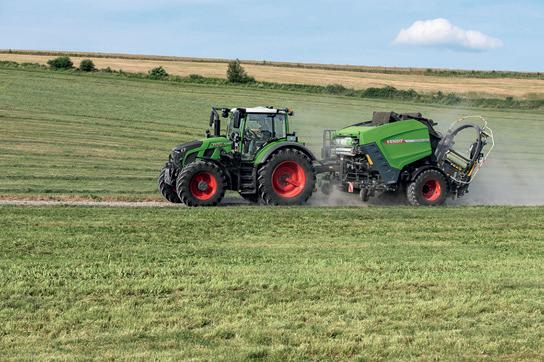
This reduces feed losses caused by mould formation and also protects the bale in freezing temperatures. “Two gathering arms, and a shaft binding system specially
developed for the variable presses, guide the binding material into the baler chamber. The shaft formation also protects the film from damage. An electro-magnetic brake controls
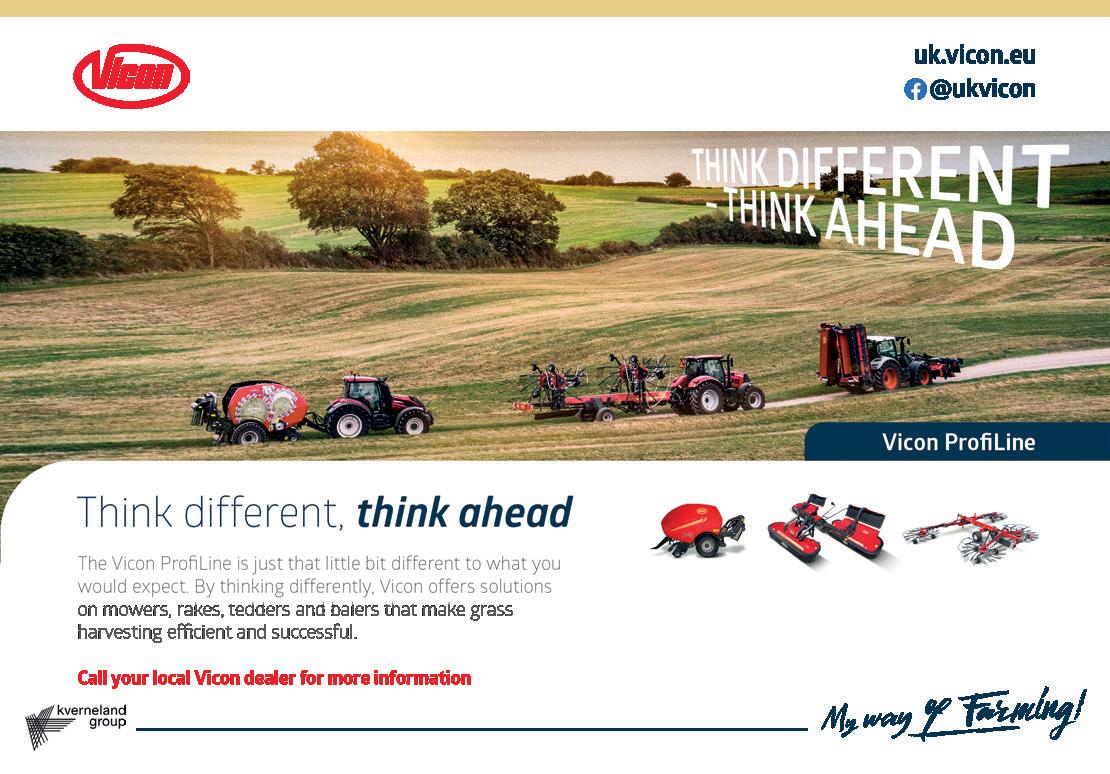
www.farmingscotlandmagazine.com 23
BALERS
BALERS
the pre-stretching of the net or film according to the binder and its roll diameter,” says Mr Dennett.
Only one waste material is created with film binding and film is typically much less contaminated and, therefore, easier to recycle. Usage is also reduced compared to net and Fendt’s new film binding system can save up to three metres of film per bale.
The arrangement of the rolls on a magazine enables a quick change between film and net. This allows operators to quickly switch from silage to hay or straw bales and there is a choice between Eco Load and Comfort Load systems.
“Machines with Eco Load have a simple loading chute that requires a little more muscle power. With Comfort Load, the operator places the roll in a padded carriage, lifts it and guides it up to the quick-change system. A further benefit is that rolls can be loaded from the ground,” says Mr Dennett.
An intelligent lever system makes it possible to switch between the three ready-to-tie rollers in a few simple steps. In addition, the easy operation and padded contact surfaces prevent damage to the net or film.
The new model benefits from a faster ‘Speed’ tailgate capable of baling up to thirty more bales per day than the previous Rotana. Folding, self-steering, pick-up wheels can also be specified on all Fendt Rotana Xtra and Combi machines. To make reversing the baler easier the pick-up wheels can be locked with a pin, an addition that will help operators baling on steep slopes.
For those looking to maximise forage quality, Fendt’s automated dry mass control will be a useful feature. Operators can select how much dry matter a bale should contain before the baling process. Two synchronously operating sensors in the bale chamber record the moisture and mass of the bales. From this, the software calculates the dry matter content during the baling process.
John Deere Balers
John Deere offers flexible, fast solutions for farmers and contractors looking for individual balers or combination wrappers. The range is structured to be fast to bale, easy to operate and built to last, producing extra high-density bales for all.
The range spans the variable chamber V Series, fixed chamber F Series, large square L Series, and small square S Series, in addition to the three-models in the C Series which feature integrated wrapping.
John Deere balers are renowned for their durability in the toughest conditions, while ensuring the best bale and forage quality.
Those looking for a highcapacity round baler without an integrated wrapper can opt for John Deere’s V461R, which offers a high performance 2.2m wide feeding system, with a 480mm diameter converging auger.
Users can adjust the bale diameter in a 1.21m wide chamber for maximum bale weight. The full-width drop-floor is easily operated from the cab. The singleaxle V461R is also suitable for all crops, capable of handling 30 tonnes of straw per hour and producing more than two bales every minute.
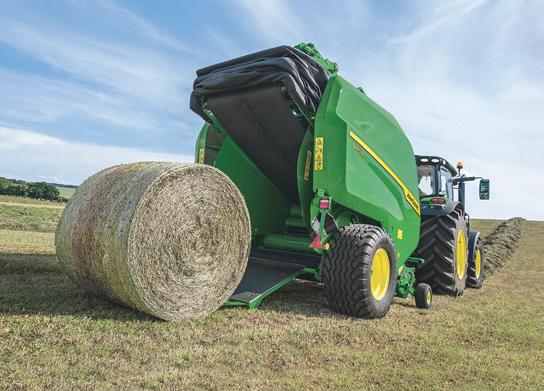
High density, high quality and premium specifications are the key features of the V461R, which has been developed to meet the high-output requirements of contractors and larger livestock farms. It features Deere’s revolutionary Fast Release System, which was launched more than a decade ago, in combination with the high capacity feeding system.
There are three models of large square balers in John Deere’s L600 range; the L624 with a bale size of 70cm x 120cm, the L633 (90cm x 80cm), and the L634 (90cm x 120cm).
The range-topping L634 has a pickup width of 2.30m and has a MaxiCut rotor with 23 knives and 6 double-tie knotters.
It’s suitable for many sectors, packing silage, hay, straw and speciality crops into high-density, rock-hard blocks.
The feeder system found in the whole L600 range is a top-end performer. Cam track technology and wide pick-ups matched to rotors aligned with massive converging augers will transform windrows of any shape and size into the uniform crop stream that is the foundation for consistent bales.
The Krone ‘all-rounder’ baler range is perfect for any type of crop
The Comprima range was developed by KRONE to be both reliable and durable even in the most difficult conditions. Featuring a unique baling technology the NovoGrip chain and slat conveyor bales all types of crops. In combination with an extremely powerful intake system, the machine produces high-density bales with high throughput. Offering a choice of chambers the round balers of the
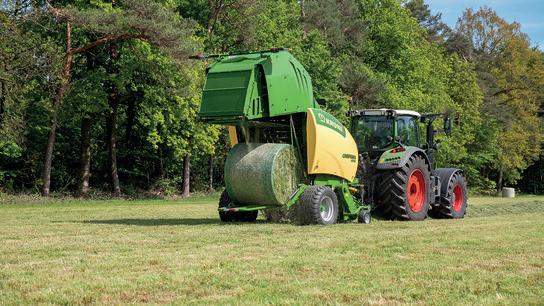
www.farmingscotlandmagazine.com 24

Comprima series are particularly flexible and match all customers’ requirements.
The fixed-chamber round balers Comprima F 125 and F 125 XC deliver with their simple, clear-cut and robust design, high stability, extra operator comfort and ease of maintenance.
The Semi-variable bale chamber Comprima F 155 model produces 1.25-1.50m diameter bales. Operators simply set the required diameter in 5 cm increments on an easy-to-use system combining the many advantages of fixed and variable chamber balers.
The variable chamber round baler Comprima V 150 XC and V 180 XC models allow operators to enter the bale diameter on the operator terminal from the comfort of their own cab. The diameters can
be set from 1.00m to 1.50m or to 1.80m diameter respectively. This way you are set to handle all crops and conditions. Smaller bale sizes are often preferred in grass silage whereas larger bales are more typical in hay and straw. Depending on the crop, the baling density in the core of the bale can be reduced, which is perfect for ventilating hay bales.
The variable chamber combination baler and wrapper the Comprima CV 150 XC has a powerful wrapper and twin arms for high speed wrapping. The wrapping table forms a deep cradle and has large guide rollers on the sides to ensure the bale is consistently rolled during the wrapping process even when operating in steep or bumpy conditions. The Comprima CV 150 XC table can also be used for unloading the bales in pairs when no wrapping is taking place.

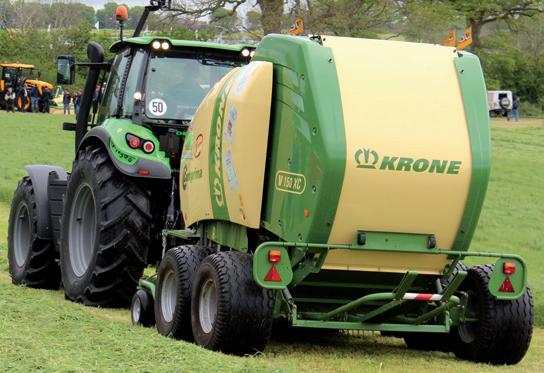
Kubota offers nonstop fixed chamber, baler wrapper combination
Kubota’s baler range has been extended with the FB1000 – a non-stop, fixed chamber round baler wrapper combination.
Designed and developed at sister company Kverneland Group’s baler competence centre in Ravenna, Italy, the FB1000 uses a pre-chamber and a main chamber arranged in series, to allow a number of rollers to be shared.
Operating as a pre-chamber, the front half of the FB1000 produces two-thirds of the bale.
As the pre-chamber reaches its preset density, crop flow is diverted into the main bale chamber allowing baling to continue non-stop. The prechamber is then opened, moving the pre-formed bale into the main chamber, where it can be taken up to its maximum size of 1.25m.
Once bale formation is complete, crop flow is switched back to the pre-chamber without stopping, allowing round baling to continue uninterrupted.

www.farmingscotlandmagazine.com 26
Main dealers in Perthshire for KRONE Balers Sales • Service • Parts Repairs for a wide range of Agricultural Machinery Murthly, Perthshire, PH1 4HG Tel: 01738 710381 email: wilksbrothers@btconnect.com
BALERS
Subscription page 36
Net is then applied to the completed bale in the main chamber, after which, the tailgate is opened and the finished bale is transferred onto the wrapper. This entire sequence enables baling to continue non-stop.
To make bale transfer simple and reliable, the FB1000 uses a wrapper frame that is carried on a parallel linkage. It is a design that enables the wrapper to be lowered from its working position to collect the completed bale as it rolls out of the main chamber.
With the bale collected, the wrapper is raised to allow twin satellite arms to rotate vertically around the bale.
With the required number of film layers applied and the satellite arms in their parked position, the wrapper frame is lowered before its rear roller is raised, releasing the wrapped bale onto the ground.
An ISOBUS compatible machine, the FB1000 is operated
through an IsoMatch Tellus PRO terminal, offering fully automatic control of the baling and wrapping processes, along with manual over-ride functions to suit changes in field condition.
Operators can choose from a combination of 6, 12, 13 or 25 knives through the Super Cut crop chopping system. Knives benefit from spring-loaded protection, and the FB1000 includes a drop floor mechanism.

KUHN introduces new VB 3200 series balers
KUHN Farm Machinery has introduced a new VB 3200 variable chamber baler range offering users 10% additional capacity and bale density compared to the outgoing models.
The new VB 3260 and VB 3290 models replace the VB
3100 series – VB 3160 and VB 3190 machines – and along with the increased capacity, the new models feature Progressive Density Plus to achieve 10% higher bale density. The VB 3260 can produce bale sizes from 0.8m to 1.6m, whereas the VB
3290 can reach bale diameters of 1.85m.
KUHN’s grassland product specialist, Rhodri Jenkins, explains where the new baler series fits in. “We have taken the proven concepts from the outgoing models and

www.farmingscotlandmagazine.com 27
BALERS
BALERS
incorporated these into the new design along with innovative features to increase output and bale quality. The range is aimed at customers requiring higher density bales and greater output in a variety of different crops throughout the season.”
A new heavy crop roller, with spring loaded tines for improved pre compression and crop flow, can increase overall efficiency of the baler by 10% compared with the previous generation. Further efficiency gains are provided by a quicker tailgate that ejects a bale in six seconds.
The Progressive Density Plus system is a pressure boost to provide higher bale density in dry crops. The density is increased by
the hydraulic cylinders and spring tensioner increasing the resistance on the belts, while a belt tensioning arm provides an additional 10% when required. The baler can be operated via a tractor’s ISOBUS terminal, or through the VTI 60, CCI 800 or CCI 1200 Isobus screens. Non-Isobus machines are standard with the VT 30 control unit.
The 3260 and 3290 models are also available in baler-wrapper combination units with the same new features as the standard models. Offering 15% quicker bale transfer times due to the increased tailgate speed, the VBP 3260 and VBP 3290 are also equipped with automatic unloading of straw bales in pairs and a hold-to-run button

for the satellite wrapper rotation.
The hold-to-run button allows operators to rotate the wrapping arms by half a revolution to ensure the wrap is connected to the bale
after fitting a new roll, while rotating the satellite arms allows film roles to be replaced from the same side. Prices start at £51,820 RRP.
Film binding added to MF RB variable chamber Protec models
Massey Ferguson has updated its RB round baler series for model year 2024 to feature a quicker tailgate, film binding on its variable chamber Protec balers, and new options for loading net or film rolls onto the baler.
The new high-speed tailgate can offer users up to 6% higher output due to the increase in tailgate speed, allowing up to an extra four bales per hour to be produced. The new tailgate is included as standard on all Xtra and Protec models, improving overall performance of the baler.
MF’s RB V Protec balers can now be fitted with film binding, which follows the fixed chamber Protec models getting this feature last year. As part of this, machines with film binding are fitted as standard with the Rapid Reload system. This allows three rolls to be positioned on a rotating frame near the binding area. When one roll is finished, the operator rotates the frame to the next full roll without any lifting. This means that changeovers can take minutes, helping to increase baler output, with three rolls providing most users with a full day of baling. Contractors using the Rapid Reload system can
store two film rolls and one net roll in the rotator, depending on their customer’s requirement.
MF’s Easy Load System (net tying), Comfort Load and new Eco Load are options for loading rolls onto the baler. Comfort Load uses a sliding tray to lift rolls and present them to the Rapid Reload system at the correct angle, which also helps prevent damage. Eco Load allows users to manually lift rolls up to the binding area without the use of the tray.
For 2024, the auto tailgate function, integrated bale weighing system, and The
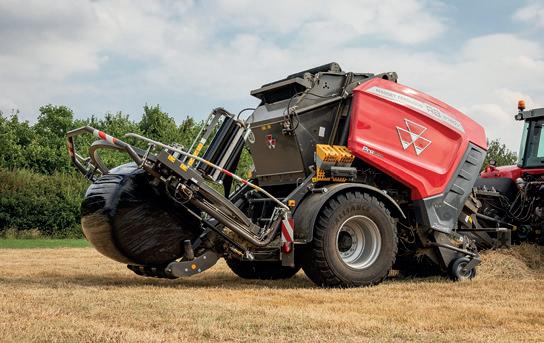
HayBoss moisture meter, are three popular features that can now be ordered individually
on new machines, without the requirement to select a full specification package.
Film binding added to MF RB
variable chamber Protec models
Massey Ferguson has updated its RB round baler series for model year 2024 to feature a quicker tailgate, film binding on its variable chamber Protec balers, and new options for loading net or film rolls onto the baler.
The new high-speed tailgate can offer users up to 6% higher
output due to the increase in tailgate speed, allowing up to an extra four bales per hour to be produced. The new tailgate is included as standard on all Xtra and Protec models, improving overall performance of the baler.
MF’s RB V Protec balers can now be fitted with film binding,
which follows the fixed chamber Protec models getting this feature last year. As part of this, machines with film binding are fitted as standard with the Rapid Reload system. This allows three rolls to be positioned on a rotating frame near the binding area. When one roll is finished, the operator rotates
www.farmingscotlandmagazine.com 28
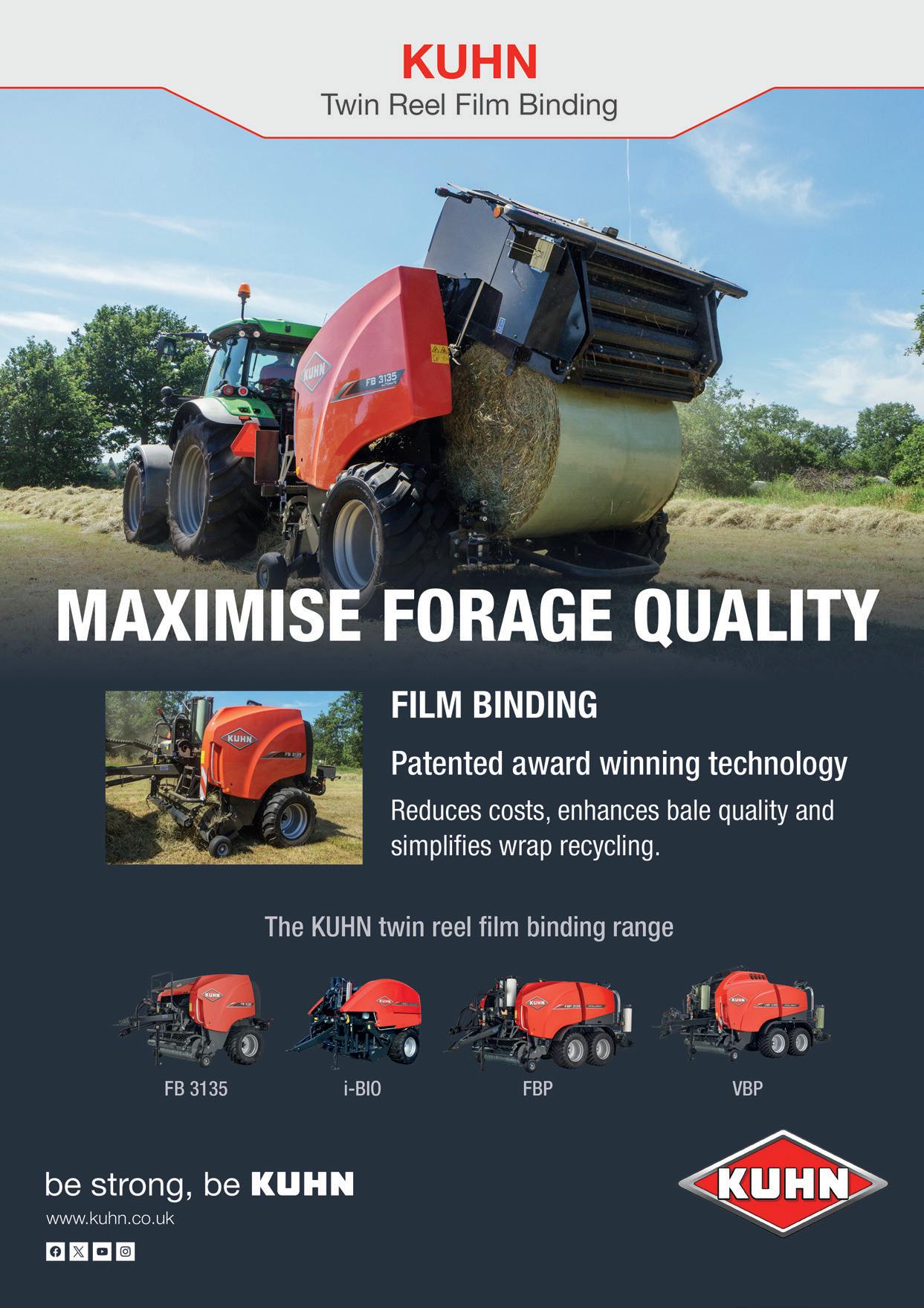
BALERS
the frame to the next full roll without any lifting. This means that changeovers can take minutes, helping to increase baler output, with three rolls providing most users with a full day of baling. Contractors using the Rapid Reload system can store two film rolls and one net roll in the rotator, depending on their customer’s requirement.
MF’s Easy Load System (net tying), Comfort Load and new
Eco Load are options for loading rolls onto the baler. Comfort Load uses a sliding tray to lift rolls and present them to the Rapid Reload system at the correct angle, which also helps prevent damage. Eco Load allows users to manually lift rolls up to the binding area without the use of the tray.
For 2024, the auto tailgate function, integrated bale weighing system, and The HayBoss moisture meter, are three popular
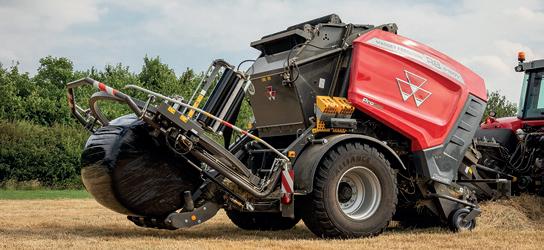
features that can now be ordered individually on new machines,
without the requirement to select a full specification package.
McHale Fusion Vario Plus
The McHale Fusion Vario Plus is a fully automatic variable chamber baler wrapper which can apply film or net wrap to the barrel of the bale, delivering optimum bale shape and bale density. The Vario Plus can provide high quality fodder through the use of the film binding system, resulting in better quality silage and a bale that is easier feed out.
The new Fusion Vario Plus has received a more modern progressive look with its specially designed twin skin panels and features enhanced throughput, increased bale density and faster wrapping speeds. A focus has also been placed on operator comfort whilst still ensuring the reliability and heavy-duty build quality that McHale is renowned for remains.
Film Binding Advantages
The McHale Fusion Vario Plus is a machine which can apply plastic to the barrel of the bale instead of twine or net wrap. Should an operator wish to use net wrap for hay or straw, this can be done with a simple changeover.
ISOBUS Compatibility
In designing the Fusion Vario Plus, operator comfort and friendliness were at the forefront of the machine’s development. The Vario Plus is ISOBUS compatible to allow the operator to experience the highest level of customisation and performance.
Profi-Flo Pick-Up with Adaptive Intake
The new Profi-Flo pick-up has been designed to increase crop
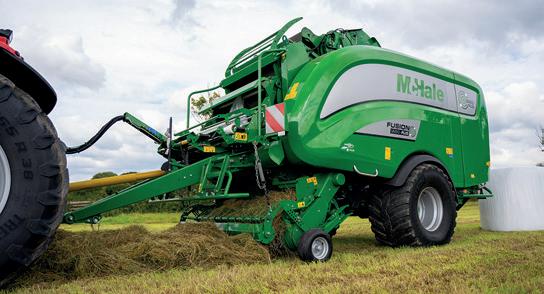
intake through more efficient crop flow. The new tapered feed channel encourages the crop to flow from the pickup, towards the rotor and into the bale chamber, maximising throughput.
The new Fusion Vario features a Quicker Bale Transfer & Faster Wrapping Speeds. An improved transfer with a
smoother sequence reduces the transfer delay while the wrapping speeds have increased to match the new machine intake.
Other new features on the Vario Plus include: Active Density, Control, IntelliChamber, Bale Shape Assist Indicators, Individual Grease & Oil Pumps and a larger Net/Film Brake.
Bigger, Better Baling with the New Holland
Pro-Belt Baler
The all-new New Holland, ProBelt™ premium round baler range delivers the performance and reliability that professionals and contractors can rely on. From the heaviest wet silage crops to bulky straw windrows, the ProBelt 165 and 190 deliver solid and square shouldered round bales with impressive capacity from either the renowned SuperFeed™ or new 25 knife CropCutter™ large diameter rotor feeding systems.
Durability by design ProBelt round balers have been
proven the world over with over 150,000 bales produced. The all-new heavy-duty drivelines, a more robust frame, and the re-imaged bale chamber deliver professional grade uptime and bales with high density.
The latest precision farming solutions including ISOBUS electronics offers a simple user interface to track all baler functions and quickly adjust on-the-go, track individual bale moisture, and average bale moisture then make smart real time agronomic decisions.

Completed with New Holland next generation styling the stylish side shields, flowing lines
are more than good looking they are a visual representation of crop flow through the baler.
30
www.farmingscotlandmagazine.com
Vicon balers gain automation and technology
Following the introduction of its Plus series variable chamber balers and the fixed chamber FixBale 500, Vicon’s round balers can now be equipped with Tractor Implement Management (TIM) capability.
TIM is an ISOBUS solution that enables the implement to control certain tractor functions, when used with a TIM-ready tractor.
Through ISOBUS connectivity, TIM enables the implement to automatically control several of the tractor and baler’s key functions, to improve operational efficiency. These include a pre-programmed rate of tractor deceleration to pause baling and apply net, along with opening and closing the baler’s tailgate after the bale has been tied. A builtin inclinometer prevents unsafe bale ejection on steeper gradients.
From a further safety standpoint, the TIM process then needs to be re-activated by the operator to resume the baling process. This uses a preprogrammed rate of acceleration to automatically reach the desired forward speed for the crop being baled.
By automating many of the repetitive tasks associated with round baling, the combination of TIM technology is able to reduce operator fatigue, while contributing to an overall efficiency gain.
In addition to Tractor Implement Management, Vicon’s RV Plus balers can also be equipped with a Techno-Pack, which brings crop humidity measurement and bale weighing functionality to the range.
A sensor plate mounted in the lower part of the main bale
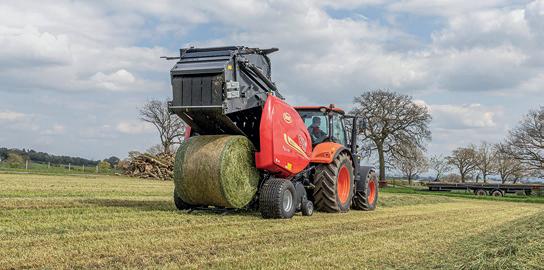
chamber is equipped with a pair of electrodes which pass an electric current through the incoming crop. This data is used to calculate the percentage of moisture in the bale, displaying the moisture content in real time, and is able to detect moisture levels up to around 50%.
The integrated bale weighing system uses two load cells in the wheel hubs of the baler, plus an additional third reference cell in
the chassis. The two weigh cells continuously measure the load on the axle, while the reference cell provides compensation for the effect of working on slopes, plus compensation for machine movement.
This allows total and individual tonnages per field or per customer to be recorded, instead of an arbitrary total number of bales for a given area.

Vicon
41028600
Vicon
Super
Focus 3
61028830
Vicon
Focus 3
Brakes
61028901List
61028829
www.farmingscotlandmagazine.com 31 BALERS
VICON SPECIALS
fixable 500
cut 15
Super
List £51,137 Sell £37,900
RV5216
Supercut 14
net
150
£56,029 Sell £39,990
RV5216
cut
14
List
£38,800
V fast bale Non-stop bale Wrapper Net
£52,210 Sell
Vicon
only
List £140,525 Sell £89,950

Ffermio Cymru

£5 miliwn o gyllid i fynd i’r afael â heriau sy’n
wynebu cymunedau gwledig Cymru
Mae partneriaeth a arweinir gan Brifysgol Aberystwyth wedi derbyn dros
£5 miliwn o gyllid i ymchwilio ac archwilio atebion i heriau gwledig.
Mae ‘Cymru Wledig LPIP Rural Wales’ yn cysylltu ymchwilwyr, cymunedau, a llunwyr polisi i gefnogi datblygiad cynhwysol, cynaliadwy.
Bydd ymchwilwyr a llunwyr polisi yn gweithio gyda chymunedau o bob rhan o Gymru wledig i ystyried atebion arloesol i amrywiaeth o heriau mawr a wynebir gan gymunedau gwledig, fel materion fel y “premiwm gwledig” ar dlodi.
Wedi’i hariannu gan UKRI, nod y bartneriaeth ymchwil yw llenwi bylchau tystiolaeth, ystyried atebion arloesol, a gwella’r defnydd o ymchwil i gefnogi polisïau effeithiol i feithrin ‘economi lles’.
Bydd yn canolbwyntio ar yr heriau o adeiladu economi adfywiol, cefnogi’r cyfnod pontio sero net, gwella iechyd, llesiant a mynediad at wasanaethau, a grymuso cymunedau a diwylliant, gan gynnwys adfywio’r Gymraeg.
Dywedodd Cyfarwyddwr Partneriaeth Polisi ac Arloesi Lleol Cymru Wledig, yr Athro Michael Woods:
“Mae Cymru wledig yn wynebu heriau sylweddol wrth dyfu ei heconomi, darparu swyddi a thai da i bobl leol, a chynnal gwasanaethau i sicrhau lles cymunedau. Mae hwn yn gyfle cyffrous i ddod ag arbenigedd o brifysgolion, busnesau, y sector cyhoeddus a chymunedau ynghyd i weithio tuag at ddyfodol cynhwysol, cynaliadwy i’r rhanbarth.”
Bydd y rhaglen waith tair blynedd yn cynnwys amrywiaeth o bobl mewn labordai arloesi i ddatblygu a phrofi ymyriadau, prosiectau ymchwil a arweinir gan
y gymuned sy’n canolbwyntio ar bryderon lleol, a deialogau i drafod materion hollbwysig fel defnydd tir a sero net. Bydd hefyd yn casglu data newydd trwy arolygon ac astudiaethau byr, a chreu Canolfan Tystiolaeth Integredig Ar-lein ar gyfer Cymru wledig.
Ychwanegodd yr Athro Angela Hatton, Dirprwy Is-Ganghellor ar gyfer Ymchwil, Cyfnewid Gwybodaeth ac Arloesedd ym Mhrifysgol Aberystwyth:
“Mae cymunedau gwledig a’u dyfodol yn naturiol yn agos iawn at galonnau pawb yma yn Aberystwyth, a bydd y prosiect pwysig hwn yn ein helpu i ddyfnhau ein dealltwriaeth o’r heriau sy’n wynebu’r ardaloedd hyn. Mae arweinyddiaeth yr Athro Wood o’r bartneriaeth ymchwil newydd hon yn tanlinellu unwaith eto pa mor ffodus ydym ni i gael arbenigwyr blaenllaw yn eu meysydd yn gweithio yma. Mae arbenigedd o’r radd flaenaf yn amlwg o werth mawr i’n myfyrwyr, ond mae hefyd yn gwneud cyfraniad hanfodol i gymdeithas yn gyffredinol yn lleol ac yn rhyngwladol.”
Mae’r bartneriaeth yn cynnwys ymchwilwyr o Brifysgol Aberystwyth, Prifysgol Bangor, Prifysgol Caerdydd a Phrifysgol Swydd Gaerloyw, ynghyd â phartneriaid yn cynnwys Antur Cymru, Y Ganolfan Dechnoleg Amgen, Datblygiadau Egni Gwledig, Represent Us Rural, Iechyd a Gofal Gwledig Cymru, Gyda’n Gilydd dros Newid, a’r partner diwydiant Sgema. Fe’i lluniwyd o dan fframwaith Sefydliad Ymchwil Cymdeithasol ac Economaidd a Data Cymru (WISERD).
Dywedodd yr Athro Alison Park, Pennaeth thema creu cyfleoedd, gwella canlyniadau UKRI: “Mae Partneriaethau Polisi ac Arloesi Lleol yn dangos ymrwymiad UKRI i ddod ag ystod amrywiol o bartneriaid ynghyd, o lywodraeth leol a datganoledig, cymunedau a busnesau. Drwy’r cydweithrediadau hirdymor hyn, byddwn yn cyflymu’r defnydd o ymchwil ac arloesi i leihau anghydraddoldebau rhanbarthol
a sbarduno twf cynaliadwy, cynhwysol.”
Mae Partneriaeth Polisi ac Arloesi Lleol Cymru Wledig yn un o bedair Partneriaeth Polisi ac Arloesi Lleol a ariennir gan yr ESRC, gydag eraill yn Lloegr, yr Alban a Gogledd Iwerddon. Cefnogir y gwaith ymchwil gan gyllid Ymchwil ac Arloesi yn y DU (UKRI) fel rhan o’i waith i greu cyfleoedd a gwella canlyniadau yn lleol.
Plans to omit designated sites from SFS branded as ‘illogical’ by NFU Cymru Rural Affairs Board
NFU Cymru’s Rural Affairs Board has branded Welsh Government’s plans to omit designated sites, such as SSSIs, from the Sustainable Farming Scheme Universal Baseline Payment as illogical.
At their recent board meeting, Welsh Government’s ‘Sustainable Farming Scheme – Keeping Farmers Farming’ consultation was considered. This sets out how the Basic Payment Scheme is to be fully phased out by 2029 and replaced by the Sustainable Farming Scheme from 2025, with farmers who wish to participate receiving a Universal Baseline Payment in return for delivering 17 Universal Actions and two scheme rules.
Under Welsh Government’s proposals, farmland designated as SSSI will be excluded from the habitat maintenance element of the Universal Baseline Payment. Welsh Government say that support for these sites will be prioritised for inclusion in the Scheme’s Optional Action Layer, but this will be subject to the development of a Management Plan with Natural Resources Wales (NRW) and the Optional Action Layer of the scheme is to be introduced later and subject to further engagement and budget availability.
Commenting after the meeting, NFU Cymru Rural Affairs Board Chair, Hedd Pugh said: “Farmers will be perplexed by the latest Welsh Government
www.farmingscotlandmagazine.com 32
 Ffermio Cymru
Ffermio Cymru
Sustainable Farming Scheme (SFS) proposals which will see protected sites such as SSSI’s ineligible for the maintenance component of the Universal Baseline Payment.
“Given that there are some 1,070 SSSIs in Wales currently, many of which are located on farms, it is incomprehensible that these sites are to be excluded from the Universal Layer of the SFS, particularly when we know that it is going to take time to get the Management Plans with NRW in place and a lot more work is going to be needed to get the Optional Action Layer of the scheme operational.
“Some farms support extensive SSSI designations and Welsh Government’s proposals will feel especially punitive to these farmers. These sites are supposed to be the best examples of our natural environment reflecting positive management practices by farmers over generations.
“Current proposals are even more surprising given that Welsh Government’s own biodiversity ‘deep dive’ undertaken in 2022 recommended that the Sustainable Farming Scheme was designed to ensure that farmers were rewarded for providing appropriate management of protected sites.
Mr Pugh added: “The central focus of the deep dive was the socalled 30 x 30 target – this refers to protecting and effectively managing at least 30% of Welsh land, freshwater and sea for nature by 2030. It is deeply concerning that Welsh Government wants to extend the area of land under some form of designation but can’t even provide the most basic support for the existing sites.
“NFU Cymru has long argued that future agricultural policy must fairly reward farmers for the environmental/public goods they already deliver and will continue to deliver in the future. You would hope that there will be widespread agreement that Welsh Government’s current policy position in relation to SSSIs is untenable.”
Vets and farmers working together on animal health pilot scheme
Milfeddygon a ffermwyr yn cydweithio ar gynllun peilot iechyd anifeiliaid
A pilot project funded by the Welsh Government to trial and assess how closer working between farmers and vets can improve animal health and improve a farm’s productivity is underway.
The project will be testing a key proposed element of the Sustainable Farming Scheme, which is the Animal Health Improvement Cycle (AHIC).
As part of the project a small group of farm animal vets will deliver regular preventative medicine veterinary visits to achieve improvements in the health and productivity of livestock on farms.
An induction day for the first cohort of vets to deliver the pilot will take place later this week.
Each vet will work closely with a small number of farms to identify areas where livestock performance can be improved, and actions agreed. These actions will be reviewed to see where improvements have taken place.
Twenty-two vets have signed up to the pilot, with each one aiming to recruit three farms in the project.
Rural Affairs Minister Lesley Griffiths said: “The proposed Sustainable Farming Scheme allows us to design support for farmers which can make a real difference. Closer working with vets can improve animal health by promoting preventative action, which as well as improving animal


welfare will improve a farm’s productivity. The results of this pilot project will be very valuable as we move towards the Sustainable Farming scheme in 2025.”
The Chief Veterinary Officer for Wales, Richard Irvine said: “I’m really pleased to see this pilot is now underway. This is an exciting project in the field of livestock veterinary medicine. Vets have been involved in the design of the project which provides real potential to improve animal health and welfare. The AHIC also has the potential to promote sustainability in the livestock sector through partnership working between local veterinarians and farmers, driving a reduced carbon footprint and further strengthening antimicrobial stewardship.”
The project is managed by Welsh Lamb and Beef Producers (WLBP) and
includes a project team with a number of vets and scientists with wide ranging expertise in animal health.
Project Director Don Thomas from WLBP said: ‘We are delighted to be delivering this crucial project, which will help farmers in Wales drive animal health, welfare and productivity on their farms. The pilot project will ensure the AHIC scheme is deliverable and can be scaled up for rollout nationally from 2025 delivering the expected benefits.”
Lessons from the pilot project will be captured to inform training to be made available to all livestock vets in Wales.



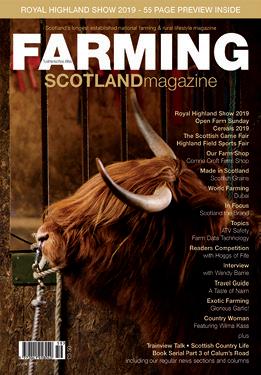
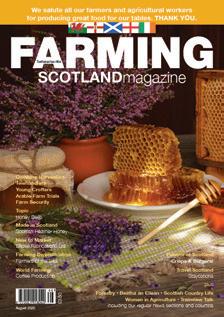

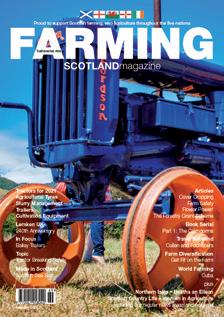
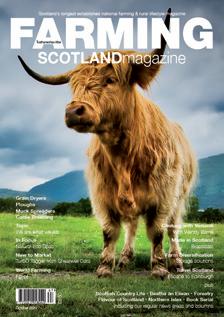

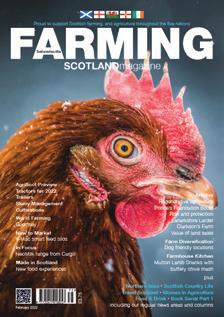

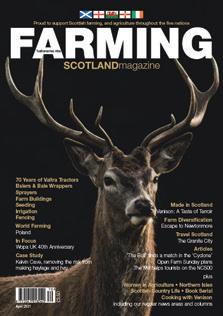





Proud to support Scottish farming, and agriculture throughout the five nations Your ‘collectable’ magazine Keep each issue build your ‘annual set’ and... RELEASE THE LION! Build your own ‘reference’ library of FARMING SCOTLAND MAGAZINE with our new ‘collectable library’ editions To subscribe please call us directly on 01738 639747 or visit: www.farmingscotlandmagazine.com SUBSCRIBE NOW Get your very own copy delivered to your door. Also makes an ideal gift. Only £28.50 a year FARMING SCOTLAND MAGAZINE

Blenheim Estate announces groundbreaking project to create circular economy from its organic waste

Blenheim Estate has announced a groundbreaking partnership with visionary environmental consultants Tumblebug, on a sixmonth pilot project to transform all of their organic waste into a self-sustaining circular ecosystem.
The Country Estate Carbon Demonstrator Project, the first of its kind in the UK, will see Blenheim Estate adopt pioneering practices which will unlock the value of its organic waste (food, coffee, compostable packaging, card, manure, green horticultural waste, forestry waste and sheep wool) using Ecobot machines and Tumblebug’s patented biochar filter process.
Blenheim Estate will trial two Ecobots, which will transform all of its organic waste into dry, sanitised, odourfree and nutrient-rich material, which can be used directly as a soil conditioner, an additive for compost, or as an ingredient for organic fertiliser production.
The project, which is being funded by Innovate UK, part of UK Research and Innovation (UKRI), is seen as a potential
blueprint which the UK’s 6,000 other landed estates could adopt to achieve their own sustainability targets.
Roy Cox, Managing Director – Estates at Blenheim Palace, commented: “To become a net zero business by 2027* means we must look at every part of our operations and reduce our emissions, and we see this project as a major step towards achieving that as well as creating circular businesses from our waste. It is vital that we work with partners like Tumblebug, and together we will find the best mix, or model, that is transferrable to other businesses who face similar challenges.”
The Blenheim/Tumblebug project will also see the creation of an organic mushroom farm on the Blenheim Estate, as well as the trialling of pyrolysis carbon removal technology, which will turn organic waste from the estate into carbon-rich biochar and heat and power and which has a myriad of uses including as a core ingredient in Tumblebug’s peat-free carbon negative growing medium; as a cover or mixer in manure management
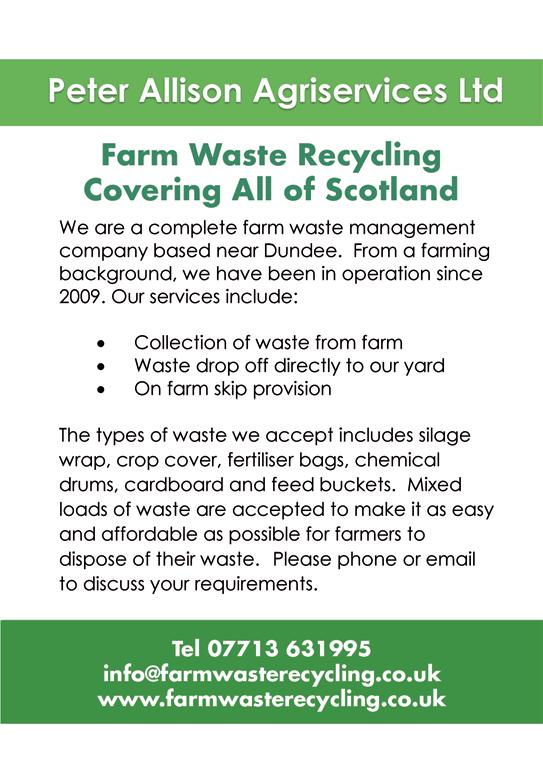
www.farmingscotlandmagazine.com 37
environment

to reduce ammonia emissions and to reduce nitrogen and phosphorus run off into surface water.
If successful, the pilot Country Estate Carbon Demonstrator Project will be further developed and adopted to accelerate Blenheim Estate’s Net Zero pledge.
Tumblebig Founder and CEO, Sylvie Verinder remarked: “Tumblebug was founded to demonstrate to the World
that we must, and can, go beyond sustainability to create a regenerative economy. We are honoured to be given the opportunity to demonstrate our Recover - Rotate - Regenerate circular economy model at this prestigious UNESCO World Heritage site. We look forward to building the human-centred design project and delivering the carbon data evidence of its impact with the incredible Blenheim Team.”
Study shows UK offshores emissions through used vehicle exports
A new study by researchers at the Leverhulme Centre for Demographic Science reveals that used vehicles sent from Great Britain to lowerincome countries fail British roadworthiness standards, are more polluting and less fuel efficient than those sent to be scrapped.
Published today in Nature Climate Change, the study found that exported used vehicles generate at least 13-53% more emissions per mile than those that are scrapped or on the road in Great Britain. The researchers used mandatory annual vehicle inspections – known as MOT tests – of all 65 million used vehicles on British roads between 2005 and 2021 to compare the pollution and emissions intensity of vehicles exported to those scrapped, destroyed, or driven in Great Britain.
The data revealed substantially higher rates of carbon dioxide and pollution generation in exported vehicles. Amongst the seven million vehicles legally exported from Great Britain, exported used cars generated at least 13% more
carbon dioxide per kilometre than scrapped cars, and 17% more than used vehicles on British roads. Exported vehicles were also 3.3 miles per gallon worse on fuel efficiency than those sent to the scrapyard.
Lead author Dr Saul Newman, Research Associate at the Leverhulme Centre for Demographic Science and Demographic Science Unit at Oxford Population Health said ‘Our study reveals that the UK, a leading global exporter of used vehicles with high vehicle emissions standards inside its own borders, offshores vehicle emissions to lower-income countries who are already suffering the most from climate change.’
Over half of all vehicle exports to low and middleincome countries originate from the EU and UK, with virtually all remaining trade coming from Japan and the United States. Whilst these countries maintain high emission standards domestically, almost all countries that receive their vehicle exports have no emission standards of their own.

Getting protein right for ewes pre-lambing
Lorna Shaw, Ruminant Nutritionist, SAC Consulting
To meet the demands of ewe maintenance, growth of her unborn lambs, udder development and colostrum production a ewe’s demand for protein increases by almost 50% in the final 6 weeks up to lambing. This also coincides with a large increase in energy demand. Meeting these demands are essential to ensure the success of lambing but also the continued growth and development of her unborn lambs. However, this can also be a source of inefficiency if the ration is not correctly balanced, resulting in potential costs to ewe production efficiency and also potential increases in nitrogen excretion.
Ruminants are unique in their ability to utilise poorer quality protein sources such as forage that other species cannot effectively digest and synthesise it to high quality protein in the form of microbial crude protein (MCP). However, for this process to be efficient it is reliant on a balance of both rumen available energy and protein in the diet with MCP production only as effective as the first limiting factor.
• If rumen available protein is less than rumen available energy -> protein is limited. This results in reduced dry matter intakes and digestion decreasing the effective utilisation of the ration.
• If rumen available energy is less than rumen available protein -> energy is limiting.


This results in the excess protein being converted to ammonia in blood with surplus excreted in urine. This will also come at an energy cost to the ewe.
The first step to effectively balancing the ration and to reduce inefficiencies is to first assess the supply from the baseline forage. From there, we can then correct any imbalances through correctly balancing any deficiencies to try and optimise the available protein and in turn energy from the ration. Getting the balance right can be the difference of a successful lambing but also an efficient flock making the most of the diet offered.
For more information on the groups findings and other Farming for a Better Climate activities, visit: www. farmingforabetterclimate. org/ or find us on Facebook and Twitter @ SACFarm4Climate.
38 environment
www.farmingscotlandmagazine.com
Farming for a Better Climate is funded by the Scottish Government
New study reveals soil health benefits of regenerative agriculture
A STUDY being conducted at the University of Leeds Farm is shedding light on the benefits of regenerative cultivation techniques.
The study compares soil health, crop production, greenhouse gas emissions, and profit of different farming systems across seven 12m x 40m plots.
Some of the plots were ploughed and power harrowed, while others underwent minimal cultivation using non-inversion, shallow cultivation.
Cover cropping, living mulches, manures, livestock integration, and herbal leys have also been utilised as part of the trial.
Data were collected by stateof-the-art soil stations created by Estonian ag-tech company Paul-Tech, which take real-time readings of nutrient availability, soil water levels and soil temperature at depths of 8cm and 20cm.
Each plot received three treatments of nitrogen throughout the trial, with nutrient and water availability measured at both depths after each application.
The stations revealed that the trial plots which had minimal cultivation held more nutrients and water around the root zone for longer than plots that had been ploughed.
As a result, the minimal cultivated plots recorded a significantly larger nutrient release after fertilisation and higher nutrient availability at the 8cm mark compared to the ploughed plots, and nutrients were held around the rootzone for longer.
By contrast, water quickly drained through the ploughed soil, leading to a significantly smaller nutrient release at fertilisation and considerably
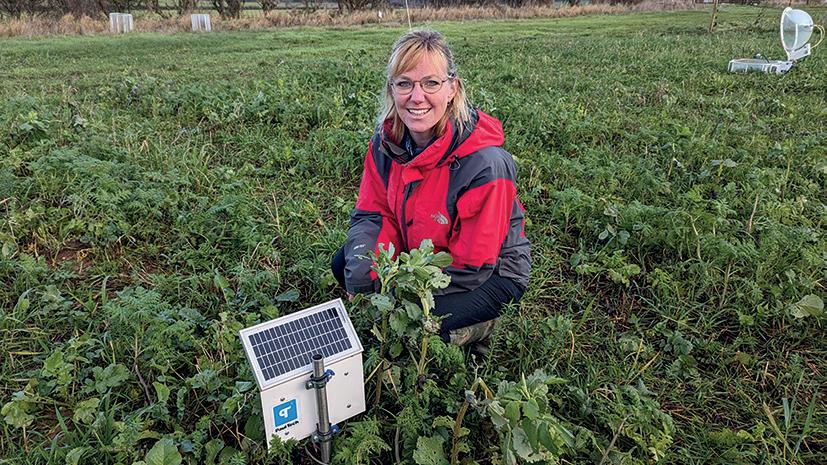
less nutrients available to the plants at 8cm.
Soil temperature was also impacted by the cultivation method with the ploughed soil experiencing much larger temperature changes over the course of the trial.
The ploughed soil froze when air temperatures dipped below zero, whereas those sown under a minimal cultivation system maintained a much more stable temperature throughout and did not freeze.
Commenting on the study findings, Paul-Tech Chief Executive Mikk Plakk, described them as ‘fascinating’.
The study is ongoing and will look at the impacts of other regenerative techniques on soil health over a longer period.
Mr Plakk said: “The data from our soil stations clearly shows soil nutrient availability and temperature differences between plots with different cultivation methods.
“For example, the soil in the conventional ploughed plot froze at root level and
showed significant temperature differences while the minimal cultivated plots didn’t freeze and temperatures were relatively consistent in the root zone.
“Also, in the minimal cultivated plots, the soil was much more effective at holding water, which meant far more nutrients were available at 8cm than was the case in the ploughed plots.
“The findings have a significant bearing on how farmers should be treating soil. They strongly suggest cultivation methods have the potential to significantly improve soil and plant health while reducing the amount of inputs they need to apply.”
Paul Tech’s soil station combines real-time proprietary sensor data with weather and satellite data to produce agronomic recommendations for farmers and growers, which are reported via an online dashboard.
This empowers them to make more informed decisions about crop inputs and irrigation, leading to better soil health, plant health, yield and cost savings.
The system is in place on commercial farming operations in Scandinavia and Eastern Europe and is being launched in the UK this month.
“Getting access to real-time, high frequency data from the soil station was vital for this study and will be equally valuable for farmers,” Mr Plakk added
“This level of insight would not be available without the ability to measure water and nutrient movement throughout the soil, which our system has been specifically designed to do.
“As the study continues, we expect to discover further insights into how different cultivation techniques impact on soil health, the environment, and the farmer’s bottom line.”
The trial is being led by Dr Ruth Wade, Research Fellow at the University of Leeds.
Dr Wade said: “The results coming from this regenerative agriculture plot trial will provide important data on the impacts of different farming systems both on the environment but also for the farm business.”
39
www.farmingscotlandmagazine.com
ARTICLE

Nowhere is the need for grid capacity more acute than Scotland’, UK Minister tells Grid and Networks Conference
UK Minister of State for Energy Security and Net-Zero addresses Scottish Renewables’ Grid and Networks Conference
More than 200 guests attend trade body event to explore the urgent action needed to transform Scotland’s electricity network
Scottish Renewables recently hosted its Grid and Networks Conference in Glasgow where Graham Stuart, UK Minister of State for Energy Security and Net Zero, told delegates that transforming the electricity
network is essential if Scotland is to achieve its ambitions for a cleaner, greener future.
The Minister also stated that reforming the electricity network will reduce consumer bills, bring local jobs, support economic growth across the country, and that planning and grid reforms are estimated to accelerate around £90 billion of additional business investment over the next 10 years.
Scotland is braced for an era of strategic planning to secure the future of its electricity network

with a major shift in grid and network policy from both the UK and Scottish Governments. Grid and network experts at today’ conference explored how the renewable energy industry can work with National Grid Electricity System Operator (ESO), transmission network operators and Ofgem to deliver the fast, reliable and secure electricity network infrastructure needed to meet Scotland’s netzero targets.
More than 200 visitors attended the event to hear from grid and network specialists including Harriet Harmon and Tessa Hall both from Ofgem, Paul Wakeley and David Wildash, both from National Grid ESO.
Speaking at the conference, Graham Stuart, UK Minister of State for Energy Security and Net Zero, said: “Nowhere is the need for grid capacity more acute than in Scotland.
“Scotland is synonymous with renewable energy but there can be no transition without transmission, and our plan to rewire the network will allow us to unlock all of that potential and bring enormous benefits back to Scotland.
“Through an unprecedented package of measures designed to transform our electricity network – as announced in the Autumn Statement - we will reduce consumer bills, drive local jobs, support economic growth across the country, and bring forward £90bn of investment over the next 10 years.”
Claire Mack, Chief Executive of Scottish Renewables, said: “Scottish Renewables’ Grid and Networks Conference comes at a crucial time for Scotland’s electricity network where

strategic network planning will play a key role in enabling our renewable energy ambitions. “Grid infrastructure is essential to the achievement of net-zero and we need pro-active strategic planning to deliver the energy transition as well as a considered conversation with the people of Scotland and the UK on the necessity and urgency of the task.
“The future of our electricity network is a key priority for the renewable energy industry and from speaking to our key stakeholders today we must take firm action at pace in order to deliver the grid and network infrastructure demanded by netzero.”
Following the conference, the Minister travelled to Edinburgh to visit StorTera, a long duration battery specialist and member of Scottish Renewables, for a tour of its facility.
The Minster was also shown StorTera’s plans to develop a long-lasting megawatt scale battery that can operate for up to eight hours which has been supported with £5 million funding from the UK Government’s ‘Net-Zero Innovation Portfolio’.
renewable
energy
www.farmingscotlandmagazine.com 40
Sprayers …spreading it around!
Continued innovation from Amazone for persistent precision
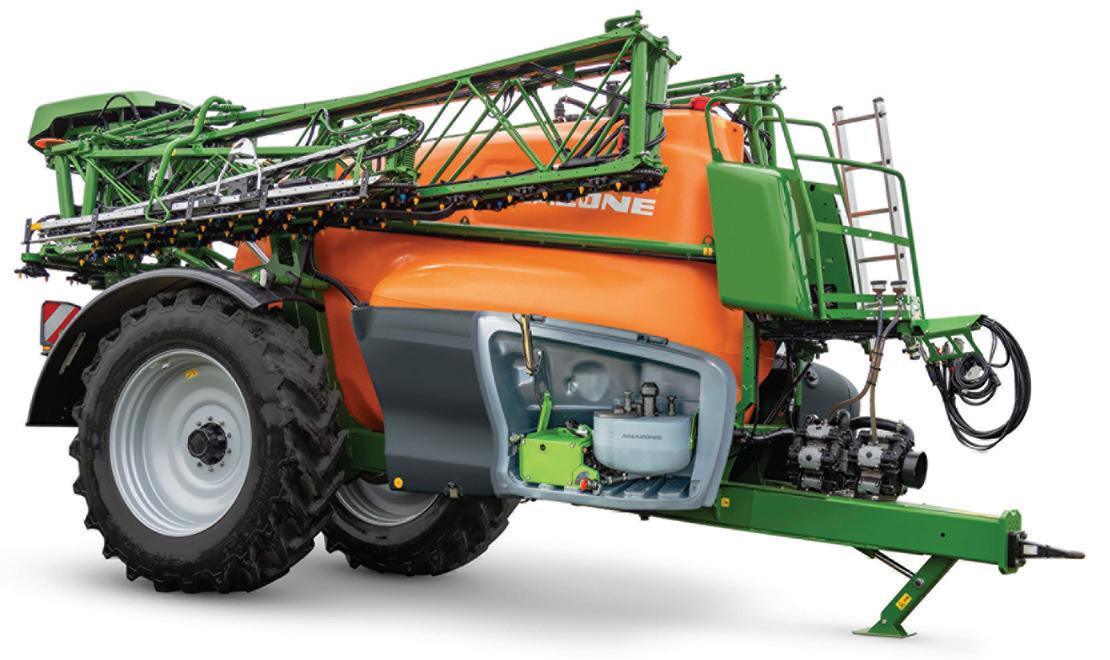
Precise and accurate agrochemical application is key to maximising chemical efficacy whilst minimising costs. The DirectInject system available for AMAZONE trailed and self-propelled sprayers is an exciting new addition to the AMAZONE arsenal, helping growers reduce costs whilst increasing output. DirectInject is a 50 litre neat chemical direct feed system, providing quick metering of additional plant protection agents on demand. As the flexibility of agrochemical selection becomes of increasing concern, DirectInject enables a quick response to changing
field conditions where a specific agrochemical may be required to be added or removed from the chemical mix. At the push of a button or through variable rate maps, a neat chemical is injected and mixed into the secondary circuit. Valuable for when a certain pest is only present in a specific field area, enabling reduced overall chemical usage or where a chemical is restricted due to protected field areas, such as near watercourses. DirectInject sets itself apart through a fast reaction time of only 30 metres.
DirectInject is available on UX Super range of trailed
sprayers which now includes tank capacities from 4,600 to 9,000 litres as well as a tandem axle 12,000 litre capacity machine. The well proven L3 boom has now been extended with the newly released 48 metre wide boom, including newly developed SwingStopPlus as standard on all booms over 39 metres. Utilising gyroscopic sensors on the boom tip, SwingStopPlus counteracts and
dampens any boom oscillation on both sides independently. This results in the elimination of under and over spraying on boom tips, typically a considerable concern for larger boom widths. Across the range, AmaSelect smart individual nozzle switching enables even further precision with curve compensation for even dose rates across the boom even while turning as well as row spraying and spot spraying.

41 SPRAYERS
www.farmingscotlandmagazine.com
Chafer Unveils Upgrades to Trailed Sprayers

Chafer has revolutionised its 2024 trailed sprayer lineup, unveiling significant enhancements to the Guardian and Sentry models. Central to these updates is the introduction of the ePlumbing RinsePro system, an evolution of the existing setup, now integrating a 120l/m piston diaphragm pump alongside the proven 1,100l/m centrifugal pump. This innovative system provides precise control over rinse water, minimising contamination risks and enabling concurrent filling of main and rinse tanks.
Moreover, the induction hopper receives a continuous supply of clean water during operation, streamlining spray can cleaning and ensuring operator safety. The addition of a secondary pump, discreetly placed at the rear to reduce noise, facilitates optimal priming of the main spray pump, ensuring seamless functionality even
when the machine is fully drained.
Chafer has also upgraded its eControl system, now fully compatible with ISObus terminals, eliminating the need for a separate touch screen and reducing in-cab clutter. Furthermore, new trailed sprayers will offer Hypro
Prostop-E Individual Nozzle Control across all boom sizes, in single and twin line setups. These systems promise rapid on/ off times, ISObus compatibility, and enhanced auto line switching. Additional enhancements include increased compressed air volume to optimise features
like AirPurge and Central Tyre
Inflation. The redesigned front bulkhead creates more space around the tractor, simplifying tractor mudguard installation. Overall layout changes aim to enhance diagnostic and maintenance access, aiding the dealer network in supporting Chafer’s trailed sprayers.
Fendt Rogator updates for 2024
Fendt has updated its selfpropelled Rogator sprayer for 2024 with improved boom stability, electro-pneumatic nozzle bodies and a revised liquid system to reduce cleaning times. The new features will be available on all Rogator models – 645, 655 and 665 – with boom widths from 24-39m.
A redesigned plumbing system features an additional clean water
pump to enable continuous internal cleaning of the application tank. The ContiRinse system works on two adjustable thresholds, with the first initiating cleaning when the liquid volume in the main tank drops below a set value. Water is pumped into the non-applicant lines and pipes, displacing chemical residues, without diluting the tank mixture. The second threshold is closer to the end of the
www.farmingscotlandmagazine.com
tank and activates the full cleaning process.
The system is designed to reduce the downtime spent cleaning and rinsing the plumbing system after spraying. The additional clean water pump allows the pre-rinse cycle to begin whilst spraying and there is now an auto pump shutoff, which switches off the main 785l/min pump after cleaning to prevent it running dry.
42 SPRAYERS
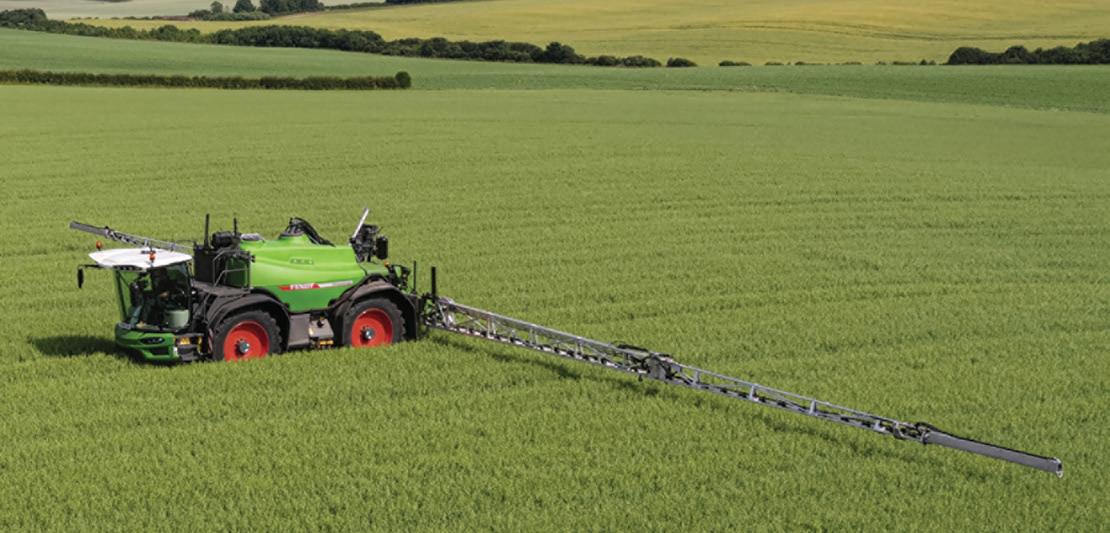
There is also a new cleaning kit at the rear to increase the working comfort of wider booms.
All Rogator models are now fitted with electro-pneumatic nozzle
bodies as standard, which replace the electric versions, and have a lower power requirement. The changes will increase longevity and reliability of the machines as the new nozzle
bodies don’t have diaphragms and feature no dead volume areas for liquid or chemical residues.
Coupled to this, Fendt has added new nozzle option. These
are compatible with Fendt’s OptiNozzle automatic nozzle selection system and are supplied by Lechler to meet requirements for drift control.

SPRAYERS
New self-propelled sprayer: Horsch Leeb VT meets customer requirements

The range of the well-proven HORSCH Leeb self-propelled sprayers is extended with another model: the HORSCH Leeb VT.
The market demanded a compact self-propelled sprayer and a variable track adjustment combined with the well-known performance of a Leeb selfpropelled sprayer. The size of the HORSCH Leeb VT is new and so is the option of a flexible track adjustment. This allows for
reacting flexibly to different row widths of different crops. Due to this flexibility, the Leeb VT is ideal for mixed crop farms and contractors. The track width can be adapted and thus allows for creating only a few tramlines and for keeping them as narrow as possible to waste as little surface and yield as possible.
The tank is available with a capacity of 5 000 l or 6 000 l. The track width can be adjusted
flexibly from 1.80 m to 2.40 m for example on slopes. In hilly terrain, this is advantageous with regard to stability. The clearance amounts to approx. 1.30 m. From a technical point of view, the Leeb VT is based on the modular system of the wellknown and well-proven Leeb PT. Two options of the 6.7 l motor are available: with 230 hp and 300 hp in level V and with 210 hp and 280 hp in level III. In addition to the well-proven drive concepts, there
now also is a smaller drive concept adapted to the size of the machine. In this respect, the new OptiGear excels due to the efficient use of the compact components.
For utmost driving comfort, with the option of a track adjustment, HORSCH benefits from the longtime experiences gathered with the well-proven Leeb PT and Leeb VN. A new axle concept was developed on this basis.

44 SPRAYERS
www.farmingscotlandmagazine.com
Bigger tank and more booms from Kverneland

Kverneland’s iXtrack T4 trailed sprayer series is now available with a larger tank spray capacity,
for those seeking more output and productivity. It sees the range extended with the arrival
of 5,300-litre model that sits above the previous rangetopping 4,600-litre T4.
The larger tank also fills a gap, moving the T4 models closer to the smallest capacity
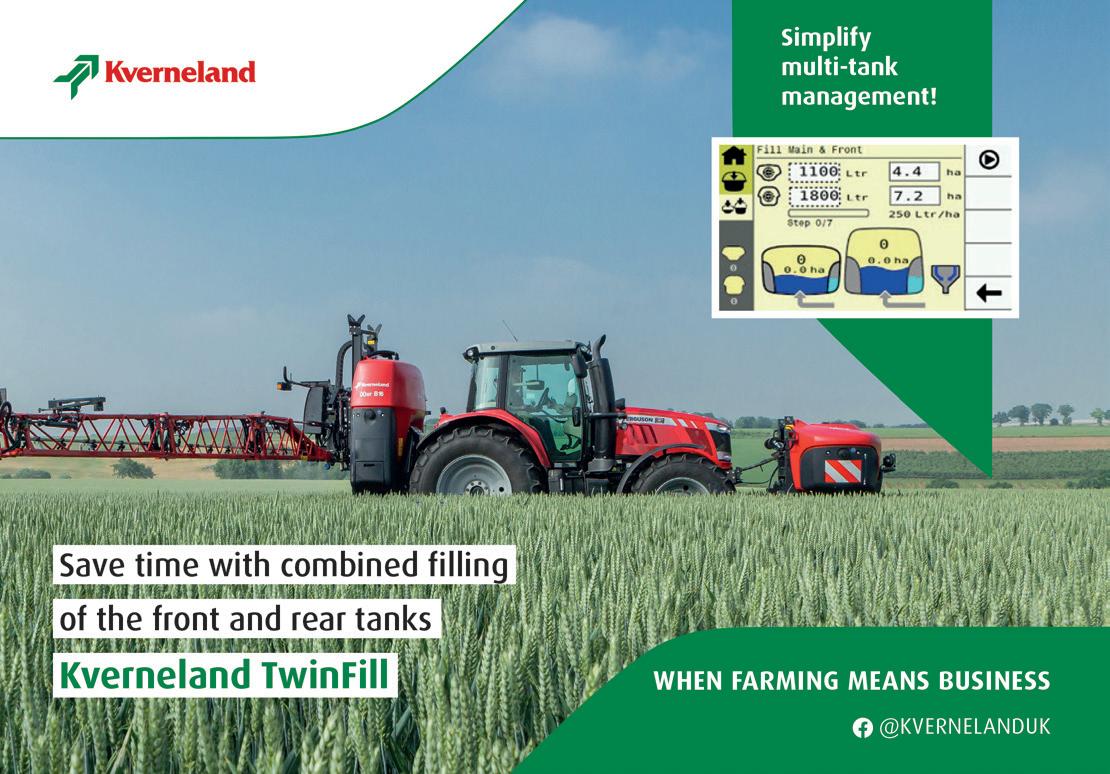
www.farmingscotlandmagazine.com 45 SPRAYERS
T6 version, which comes with a 6,400-litre tank.
In addition, iXtrack T4 series can be specified with Kverneland’s innovative HC vertical folding boom, which is available in working widths up to 30m. The HC boom offers single-side spraying, and asymmetric and symmetric folding of three, four or five boom sections.
It is a mechanism that suits those with narrow headlands or
no headland at all – for example with vegetable production.
The vertical folding HC boom is available from 18-30m, and can be equipped with five, seven, nine or 11 boom sections, or it can be equipped with iXflow-E boom line recirculation and individual electric nozzle control.
Technology continues to evolve with the introduction of Twin Fill software to simplify multi-tank management with
mounted combinations such as the iXter B used with the iXtra front tank.
With up to 2,900-litres of total spray volume available through the front and rear tank combination, Kverneland says some current multi-tank systems require operators to measure pesticides twice for each tank’s known quantities - or fill both tanks simultaneously with an extended and often unknown mixing time.
In either circumstance, there is a risk of incorrect concentrations says the firm, along with the downtime of what could be considered a timeconsuming process.
With the development of Twin Fill software for those models equipped with iXflow-E, Kverneland reckons to have simplified this process. Twin Fill ensures that the correct volumes of liquid in the correct concentrations for each tank, are correctly mixed, split and transferred accordingly.
Kuhn Aero 32.1 mounted applicator increases fertiliser precision
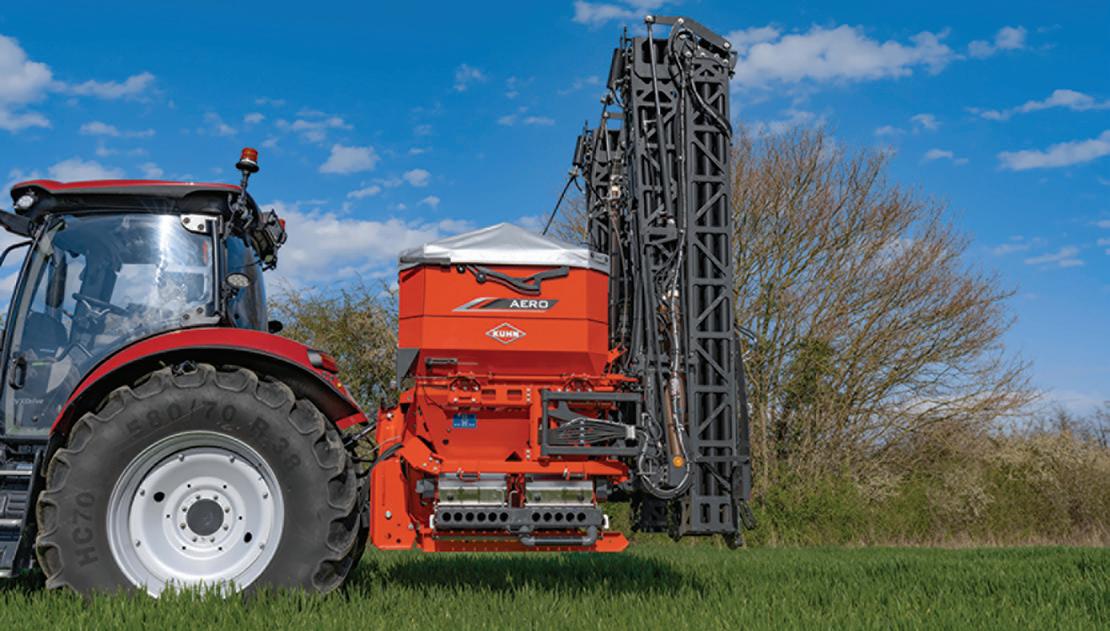
KUHN’s Aero 32.1 mounted boom fertiliser applicator lengthens the application window even in less-than-ideal weather and the fixed boom places fertiliser in the optimum area for the crop, helping to maximise fertiliser efficiency and reduce wastage.
The Aero 32.1 model is available in 24m, 27m, 28m or 30m widths with four sections and a 1,900-litre hopper capacity, although there is an optional 1,300-litre extension taking total capacity to 3,200-litres.
It features four metering units, one for each section of the boom. Each of these is connected to six diffusers, with individual adjustment possible to alter the spread pattern. This means the Aero can operate four individual application rates and shut off sections as required, and a maximum flow rate of 360kg/min is possible. Two onboard weigh cells monitor the tank contents and can adjust application rate by altering the speed of the metering units.
There is no requirement to change the spreader settings for different fertiliser types and a wide range of products can be applied, such as Avadex, which can save contracting charges or additional machinery purchases. Growers also have the option to choose different fertiliser types or nutrients, such as light or natural fertilisers that aren’t a uniformed shape and widen spreading windows.
Compared with a twin disc spreader, the Aero 32.1 and larger
www.farmingscotlandmagazine.com
Aero 60.1 AGT offer accurate border spreading which helps to protect the environment and increase the precision of fertiliser application. By achieving a complete coverage at the desired application rate to the field edge, up to 4% yield increase can be achieved in certain conditions.
Boom height control through two ultrasonic sensors is an option, along with a choice of rollers to apply slug pellets, Avadex, microgranules and small seeds for broadcasting cover crops.
46 SPRAYERS
McConnel launches the all-new Agribuggy V300
McConnel has launched its’ Agribuggy V300 with variable transmission and new Comfort Cab. Redesigned from the ground up, the all-new Agribuggy features a redesigned cab, a 50km/h variable transmission, a Cummins engine, heavy-duty drivetrain, and a 3000-litres capacity spray tank for enhanced performance, durability, and output.
With an unloaded weight of just 6,400kg, the new Agribuggy V300 remains the marketleading light-footed sprayer that allows growers to spray crops in challenging ground conditions and tough terrain, enabling safe and productive working earlier and later in the year.
The new variable transmission ensures perfect speed control
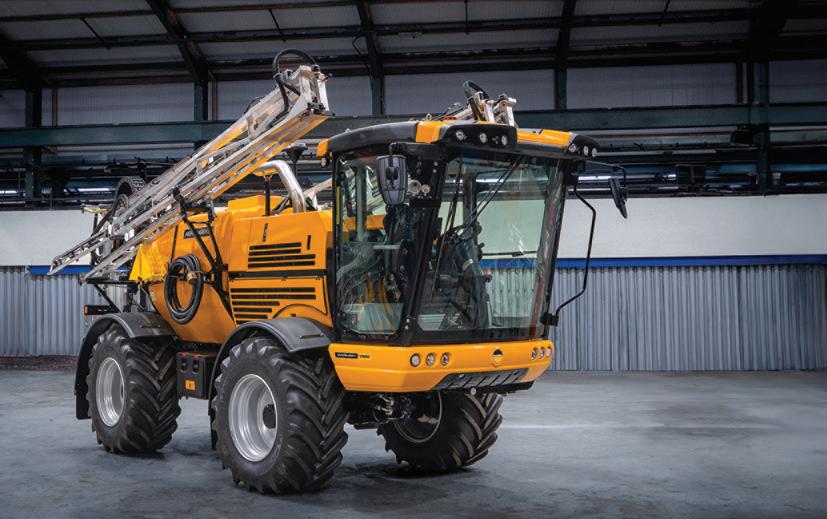

www.farmingscotlandmagazine.com 47 SPRAYERS
for optimal spraying output, and OMSI drive axles with locking differential provide improved traction and handling with a generous 750mm ground clearance when fitted with largediameter row-crop wheels.
Designed for all-day comfort, the all-new Agribuggy Comfort Cab offers outstanding 360-degree visibility and an ergonomic layout. Featuring 10 LED work lights,
electrically adjustable mirrors, an air-suspended high-back seat, and a floating control console, it creates the perfect environment for extended working hours.
Powered by a highperformance Cummins 3.8L 148HP turbocharged diesel engine, the power plant is Stage V compliant with Euro emissions standards. Delivering 600Nm of torque at lower revs and utilising
an intelligent engine braking system, the new power plant provides responsive power and performance both on the road and in the field.
The redesigned engine bay now comes with a wideopening access panel, providing quick and convenient access for maintenance and servicing, including fuel, AdBlue, and engine oil fill points.
The V300 comes equipped with a 3,000-litre sprayer demount that has been internally baffled for extra strength and to prevent surges. A new electronic sight gauge with LED display for tank contents and remote PTO control has been added for greater convenience and accuracy. 12/24m aluminium Pommier booms with a pressure recirculation system remain a standard feature.
The Leader 4 Sprayer proves popular for Team Sprayers

Launched in 2020, the Leader 4 from Team Sprayers has quickly become one of their most popular trailed sprayer models. The Leader 4 incorporates a low-folding boom and its profiled tank ensures a low centre of gravity, thereby maximising machine stability with boom widths up to 36M and tank up to 5000L.
Not only can the Leader 4 meet the rigorous demands of any
agricultural environment, you can be assured of excellent sales support from Team. Personal set up is guaranteed with every GPS section controlled sprayer they sell in the UK, as is a fast and responsive after sales service and parts delivery.
East Lothian farmer Willie Robertson recently bought a Team Leader 4 sprayer and said the after sales service was one of the key reasons he went with
Team. Mr Robertson said: “I was keen to buy a British sprayer as we had experienced difficulties getting parts for our previous machine which was European. Our Agricultural Engineer recommended Team and I’ve been really impressed with the machine and the service, they were great at coming back to us with any queries and Phil even came up to commission it for us. We opted for
www.farmingscotlandmagazine.com
the 32m boom and a 4000litre tank and it’s got everything we need such as GPS and variable boom geometry, but it’s simple to use and easy to get to the parts, which are all off the shelf. I’m really pleased with it and wouldn’t hesitate to recommend Team Sprayers”
For more information about the range of agricultural sprayers offered by Team visit teamsprayers.com.
48 SPRAYERS
There’s a future for palm oil in the dairy supply chain, but sustainable sourcing matters
If not palm, then what?
Understanding the complex story of sustainable palm and the vital role it plays in supporting global conservation efforts, local economies and the dairy supply chain.
From ice cream to livestock feed rations, palm oil is a common ingredient found throughout all stages of the dairy supply chain. Valued for its unique melting point, mixability and low odour, it has become one of the top global edible oils by consumption since the palm oil boom of the early 1990s, says Catherine Barton, Policy Lead on Deforestation-Free Commodities and Regenerative Agriculture for Chester Zoo.
“Palm is incredibly versatile and allows for manufacturing methods, product properties and extended shelf life that otherwise would not be possible if replaced with a different ingredient,” explains Ms Barton.
In on-farm dairy production this goes a step further, with palm oil fractions used in the manufacture of many types of rumen-protected fat supplements as highly energy-dense ingredients with unique fatty acid profiles. These supplements are targeted to improve various aspects of dairy production including milk yield, milk fat production and cow fertility, says Dr Richard Kirkland, Global Technical Manager and nutritionist for Volac Wilmar Feed Ingredients (VWFI).
These rumen-protected feed fat supplements deliver an energy concentration around 2.5-times that of cereals without disrupting rumen function as is the risk with liquid oil sources. Recent research has demonstrated contrasting
nutritional effects of palmitic (C16:0) and oleic (C18:1), the two major fatty acids in palm oil, when supplemented to dairy rations.
“Palm-based fat supplements help to optimise rumen conditions for improved digestion and utilisation of the entire ration. They also boost milk production outputs, allowing farmers to improve feed efficiency of their herds,” explains Dr Kirkland. “While energy supply can be increased with non-rumenprotected vegetable oils or cereals, these ingredients can be incredibly disruptive to rumen function with consequences to animal health and productivity.”
The improved production efficiency achieved on dairy farms translates into a similar picture of why sustainability discussions around palm oil aren’t so black and white, says Ms Barton. Compared to other vegetable oil crops, the amount of oil produced on 1 hectare of land growing palm would require up to 8 hectares of land from a different vegetable oil crop such as soya or rapeseed oil.
“When looking at what makes one commodity more sustainable than another, it must be both economically and environmentally feasible. When grown sustainably, palm checks those boxes,” explains Ms Barton. “From an environmental point of view, we need less land to produce the greater volumes of oil that are required for global consumption. The high yield also hits business targets for increased efficiency.”
The creation of a sustainable palm industry
Since the early 2000s, huge strides have been made through

collaborative efforts by palm industry stakeholders and NGOs to implement stricter production policies and to invest in palm production efficiencies to reset the industry with improved environmental and human rights practices, says Ms Barton.
Chester Zoo is one of several independent organisations collaborating on on-the-ground conservation efforts in Indonesia and Malaysia to safeguard
www.farmingscotlandmagazine.com
wildlife populations and prevent deforestation while working with local communities to create sustainable palm production systems and improve working conditions.
“Growing sustainable palm requires taking an entire ecosystem approach, and the only way to achieve this is by working at a community level to drive cohesive practices,” explains Ms Barton.
49
ARTICLE
IAAS congratulates newly qualified young auctioneers
Five young Scottish auctioneers have graduated with a respected career qualification from Harper Adams University.
Jenna Ballantyne, Amy Haddow and Nick Woodmass of Lawrie & Symington and James Scott and Andrew Weir of United Auctions completed their Certificate of Higher Education in Livestock Market Operations and Management as part of their professional training from the Institute of Auctioneers and Appraisers in Scotland (IAAS).
“These graduates have certainly earned their stripes as the four-year course was interrupted by Covid and turned into a five-year adventure,” said IAAS Executive Director Neil Wilson who attended the graduation with IAAS President Alan Hutcheon. “They have
had to show an extra level of dedication and adaptability and should be proud of their achievement. We thoroughly enjoyed the graduation and are really pleased to see this new cohort join the ranks of over 100 IAAS’ qualified auctioneers.”
Each of the graduates has been awarded Fellowship of the Institute in recognition of completing the qualification. This entitles them to use the post-nominal FIA (Scot) with their signature to demonstrate their professional merits.
Jenna Ballantyne was named top Scottish student, winning the coveted M J Thomson Award presented by IAAS and the Thomson family of C&D Marts.
The Certificate of Higher Education in Livestock Market Operations and Management

Course is offered by IAAS and delivered by the Harper Adams staff which include experienced professional auctioneers and valuers as well as others at the forefront of current mart operations. The course is designed to provide the bedrock
of knowledge and skills needed to be a competent livestock auctioneer, including health and safety, welfare, supply chain issues, people management, tax, law and valuation, and for graduates to build towards being mart managers and directors.
Students from surrey, harper and duchy triumph in farm health management awards
Students from Surrey University, Harper Adams University and Duchy College came out on top in this year’s RABDF’s Farm Health Management Awards, sponsored by Volac.
The awards aim to demonstrate an understanding of, and test students’ knowledge of, proactive farm health management – a vital element of the Agriculture Act.
The competition is split into three categories: students at agricultural colleges, agricultural universities and vet schools.
Rebecca Langford from the University of Surrey, Molly Mead from Harper Adams University and Clara Woodhead from Duchy College were announced as the winners for this year’s awards.
The runners-up were Charnia Rogers from the University of Surrey, Sam Ward from Harper
Adams University and Katie Kirkwood from Myerscough College.
Each candidate submitted a 1,500 word essay on proactive farm health management and explained how they thought it was integral in delivering health and welfare improvements on farm.
The awards were judged by RABDF Policy Director Tim Brigstocke and RABDF Trustee Sarah Tomlinson. Each category winner took home a £500 cash prize.
Sarah Tomlinson says it was a privilege, as a RABDF Trustee, to judge the Farm Health Planning essays.
“All of the entries were clearly passionate about the importance of proactive health planning on farm, many mentioning the government support available for farmers,
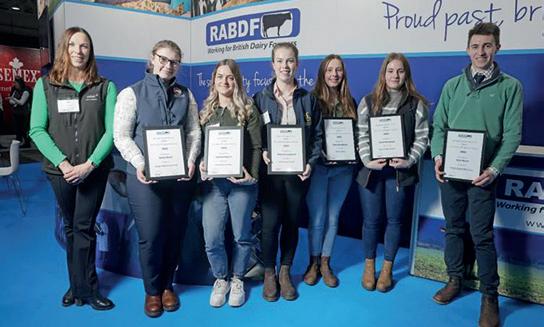
including the Animal Health and Welfare Pathway, the grant schemes and the Medicine Hub.
“The winners stood out as they really grasped the value of collaboration, not just within the farm team, but with external advisers like the private vet, nutritionists and other paraprofessionals. It was also clear to see they understood the
www.farmingscotlandmagazine.com
importance of monitoring data and the impact endemic disease can have on costs and long term financial and environmental sustainability of a business.”
The award winners were announced on the Dairy Hub at Dairy-Tech and were presented by Sarah Banks, Volac’s Head of Marketing and Sustainability, Animal Nutrition.
people
50
First Scotland-wide drugs and microplastics test of rivers launched
Environmental scientists at The James Hutton Institute have launched the first nation-wide drug and microplastics test on Scotland’s rivers to help shed light on the increasing mix of pharmaceuticals, chemicals and plastics entering our waters.
The Scottish Governmentfunded study is testing for a cocktail of chemicals, from pesticides to antidepressants, to help reveal areas of concern, such as rivers or specific contaminants, that need closer monitoring.
The study is initially focussing on the Rivers Dee and Ugie in Aberdeenshire, taking in urban and rural settings respectively, before spreading out across Scotland’s wider river catchments over two years.
Research scientist Dr Jessica Gomez-Banderas says, “There is concern about the increasing mix
of pharmaceuticals, household chemicals and microplastics going into our rivers and the impacts these could have, from impacting animal reproductive systems to spreading disease resistance in the environment.
“But we don’t know enough about how much of these contaminants are going into our rivers at a national and catchment scale. They come from a variety of sources, from us, through wastewater, farming and other activities, while climate change could exacerbate the effects they have.
“By creating a national baseline, we’ll have a valuable dataset helping point to the contaminants and rivers that might need more scrutiny and help predict the impact of things like climate or land use change. Ultimately, it could help to inform decisions around the
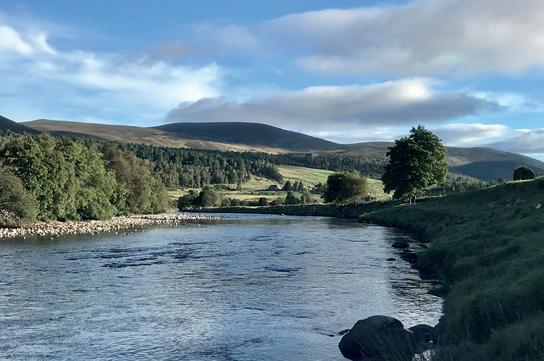
medicines and chemicals we use to help limit environmental impacts.”
The project will test for 42 of the more common pharmaceuticals (usually drugs that pass through humans into the sewage treatment process or from farm animals onto the land), 16 pesticides and six other
common household chemicals known to disrupt hormones.
The project was informed by and complement’s the ongoing Chemical Investigation Programme Scotland as part of work aiming to help Scottish rivers achieve “good status” under the Water Framework Directive.
Oral Vaccine Development Provides Sustainable Solution to Combat Salmon Lice in the Aquaculture Industry
A multidisciplinary team of scientists led by Moredun Research Institute has been awarded £1.5M from the Biotechnology and Biological Sciences Research Council (BBSRC) to combat salmon lice in farmed Atlantic salmon through the development of an oral vaccine. This represents a pivotal step towards a sustainable and effective solution to the pervasive challenges posed by sea lice in the aquaculture industry.
Many marine-farmed fish species are significantly affected by sea lice, impacting their health, welfare, and aquaculture productivity. The salmon louse, Lepeophtheirus salmonis, is an ectoparasite that feeds on the mucus, skin, underlying tissues, and blood of farmed Atlantic salmon, and there is no efficacious commercial vaccine. An increase in salmon louse prevalence and disease issues, largely as a result of
climate change, has an estimated annual economic impact on the industry of $1bn. Demand for salmon also continues to increase, making the need for the timely development of an effective vaccine, more pressing than ever.
There are major challenges associated with current control approaches against salmon lice that create a barrier against industry expansion, which is worth over £1bn annually to the UK economy. Development of a commercial salmon louse vaccine would provide a practical, safe, and ecofriendly approach to tackling the issue while also supporting the goal of the Scottish Government to double the value of Atlantic salmon production between 2016 and 2030.
Tests using traditional methods for administering salmon lice vaccines via injection have shown limited success. As an alternative,
a team of internationally renowned experts in the field of ecto-parasitology, molecular biology, bioinformatics, veterinary medicine, and fish immunology led by Moredun’s Dr Kim Thompson, are developing an oral vaccine that will generate an effective immune response within the skin of the salmon.
The oral vaccine will be designed to affect the biology of the salmon louse during its parasitic phase, impacting aspects such as attachment, development and/or maturation. The team will utilise state-of-the-art techniques, including reverse vaccinology (RV) and artificial intelligence (AI) via the EpitoPrediktTM platform from EpitogenX to quickly identify key biological targets within the salmon louse and predict which candidate antigens are able to stimulate the correct immune response in the fish. The
www.farmingscotlandmagazine.com
relevant candidates will then be fused together and expressed as a mosaic antigen through the EpitoGen® scaffold technology. The mosaic antigen will form the basis of a suitable vaccine.
Dr Kim Thompson from Moredun Research Institute said: “The development of an innovative salmon louse vaccine represents a groundbreaking approach in the aquaculture industry. By harnessing the power of reverse vaccinology and artificial intelligence, our interdisciplinary team is poised to deliver a practical, safe, and environmentally friendly solution for combating the problem of salmon lice. This vaccine, designed to enhance both systemic and mucosal immune responses in Atlantic salmon, promises not only to bolster the health and welfare of the fish but also to support the sustainable expansion of the Atlantic salmon industry.”
51
Aquaculture


NORTHERN ISLES News


Sheep-dip disposal dilemma
Vet highlights the need for, and the problems associated with, an Orkney-wide sheep dipping programme
By Tom Groat
SHEEP SCAB is Orkney’s “biggest current animal welfare concern,” according to an island vet.
A central facility for the disposal of used sheep dip must also be established — without which, it may be impossible to halt the spread of the infectious disease, according to Leona Leslie, a veterinary surgeon at Northvet.
Ms Leslie was speaking after The Orcadian published a plea from South Ronaldsay shepherdess Ruth Millar, who fears the infection may be becoming endemic in Orkney, and news that an Orkney sheep scab action group has begun to investigate potential solutions.
Last week, Dr Stewart Burgess, an expert with experience of mass sheep-dipping schemes, told The Orcadian that it was entirely possible that Orkney could become sheep-scab free.
“I think it is a huge issue and it needs to be addressed,” said Ms Leslie, a vet of 16 years.
She advocated for a mass dipping programme similar to one run last year in Lewis and Harris, but added that there was one major obstacle that had to be tackled.
“We need to solve the problem of disposing of the dip before we can get there.”
Scab, which is caused by micro- scopic mites, triggers severe agitation and wool loss, and can lead to death.
The situation in Orkney has grown much worse in just the last decade, according to Ms Leslie.
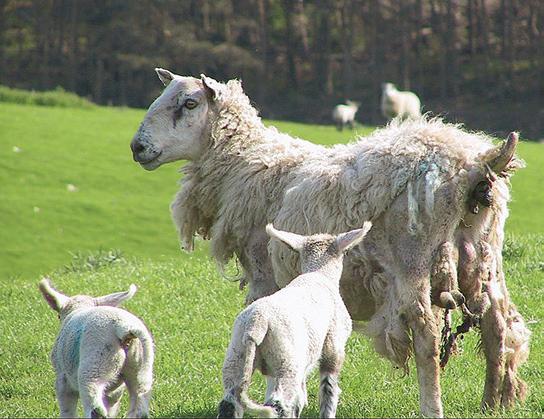
“We were very close to being scab free,” the vet said. “Today, if someone phones up and says ‘I’ve got itchy sheep,’ I say ‘you’ve probably got scab’.”
There are only two main treatment methods for scab, injectables and dipping.
Ms Leslie’s preference is dipping. Injectables treat internal parasites as well as the mites that cause scab, she explained, and heavy use means parasites may soon become resistant to the products.
But dipping also presents a problem, namely the disposal of the used chemicals.
“The huge hurdle is the disposal of the spent dip,” said Ms Leslie.
Sheep scab has become Orkney’s largest animal welfare concern, according to Leona Leslie at Northvet.
“If we can somehow solve that conundrum we would be in a position where far more sheep can be dipped.” Licences for disposal can be obtained from SEPA and the envi- are several sites in Orkney currently licensed.
But the cost of applying for a licence is prohibitive for a lot of farmers, costing close to £800, and the sites are governed by strict regulations.
Ms Leslie explained: “For a lot of farmers, particularly smaller units, this might not be feasible, and if you only have 30 ewes, it is not economically viable.”
A mass dipping programme took place in the Western Isles last year, but Ms Leslie is unsure if this would be possible in Orkney.
“They [the Western Isles] have access to a lot more barren ground compared to what we have.
“My ideal would be some form of central disposal facility.
“If the council were willing to help us with that, I think we would get a much greater uptake on dipping and then we would be in a position to consider a mass dipping programme.
“I would like to see us move towards that.”
If licences for disposal cannot be obtained another option could be transporting the dip south, but that also could come at great expense.
“There are chemical treatment plants south that will take spent dip and dispose of it,” said Ms Leslie, but the storing and transportation of dip is also heavily regulated.
An Orkney-wide dipping pro- gramme, making an impact on the spread of sheep scab in the islands, would obviously create a lot of spent dip.
“It might be that we would need a combination of things, that some dip went south and that some was spread on land, that could be looked at.”
Until a larger scheme is in place, Ms Leslie advised serology testing sheep scab.
Blood testing, available from vets in Orkney, can establish if an animal has scab before clinical signs, such as
“If you blood test a representative, it can give reassurance to the farmer,” said Ms Leslie, adding that there are grants available for this.
www.farmingscotlandmagazine.com 52
A welcome hike in crofting numbers – with 50 new entrants in a single year – has been described as a “shot in the arm” for rural island communities.
Figures released by the Crofting Commission show an encouraging increase in folk coming into the sector.
A Shetland crofting leader says a rise in online applications has helped streamline the application process, making it easier for more people to go through the process of starting their own croft.
The figures show 50 new crofting entrants in Shetland from April 2022 to March last year, and at least half of those were female.
That compares with two in Orkney over the same period, although there were 215 new entrants in the Western Isles.
Thirty-six of those new Shetland entrants were aged 41 and over, while the remaining 14 were under 41.
The crofting regions as a whole saw over 500 people enter into the crofting sector.
Of the 510 coming into crofting, almost half – 45 per cent – are women.
The figures mark a five year high and highlights the growing interest in the unique land tenure system, particularly among younger generations.
Shetland commissioner Duncan Gray said he was delighted to see the new figures come forward.
“The latest figures showing an increase in new entrants to

Crofting numbers grow
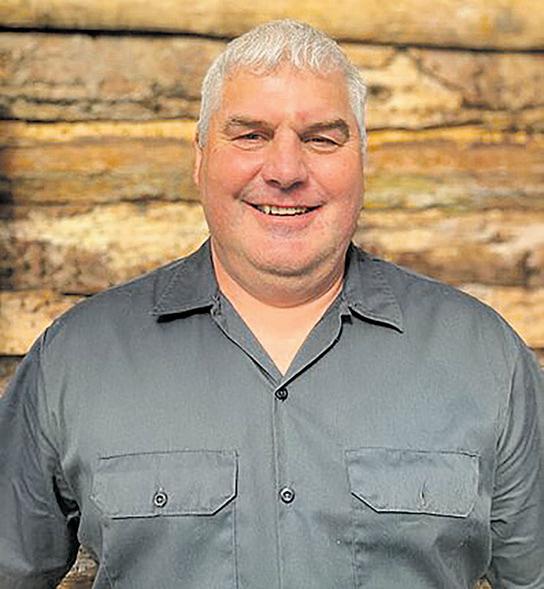
crofting are very encouraging,” he said.
“A lot of effort has gone into modernising the application processes, and 510 new entrants in total with 50 of these in Shetland is a sign that things are improving.
“All crofting applications can now be done online, this is helping staff process simple applications much faster.”
Mr Gray, who has previously spoken about his desire to see more young people come into crofting, said succession planning was something the commission was keen to “encourage”.

“There are plenty of young people working on crofts in Shetland, they just don’t have a croft in their name – yet.”
The news comes ahead of a planned trip to Shetland by the new Crofting Commission chief executive, Gary Campbell, and convener Malcolm Mathieson – who are both due to visit Shetland next month.
Mr Mathieson said: “These figures are not just encouraging, they represent a shot in the arm for rural communities facing depopulation challenges.
“It’s clear that crofting continues to offer exciting
opportunities for people seeking a rewarding and sustainable lifestyle.”
Working across the crofting counties, the Crofting Commission regulates over 21,000 crofts, and offers support to new entrants through development and grazing teams.
There are also over 800 common grazings covering 750,000 hectare in the crofting counties – representing 10 per cent of Scotland’s land mass.
Minister for energy and the environment, Gillian Martin MSP, praised the latest figures.
“I am delighted to see, yet again, that the Crofting Commission is reporting a healthy number of new entrants into crofting.
“Attracting and providing opportunities for new crofters is critical to its future. It is pleasing to note that 46 per cent of new entrants are women and 29 per cent are aged under 41.
“It is encouraging to see such a healthy number of new people embracing crofting.
“This is testament to the vibrancy and potential of this sector, and I am particularly pleased to see more women and young people getting involved.
“The Scottish government is committed to supporting crofting and its role in rural communities.
“We will continue to work closely with the Crofting Commission to create opportunities for new entrants.”

www.farmingscotlandmagazine.com 53 www.shetlandtimes.co.uk Tel: 01595 742000 In association with www.orcadian.co.uk Tel: 01856 879000
Duncan Gray

Beatha an eilean Draghan mu pàirc nàiseanta an Eilein Sgitheanaich
Le Murray MacLeòid
Tha Caidreachas Croitearachd na h-Alba air draghan a thogail mun mholadh gum bu chòir pàirc nàiseanta a’ stèidheachadh anns an Eilean Sgitheanach.
Tha Riaghaltas na h-Alba airson pàirc nàiseanta ùr a chur air chois ann an Alba ro 2026 agus ‘s e Eilean a’ Cheò aon dhe na sgìrean air a bheil iad a’ beachdachadh, an dèidh dha tagradh oifigeal thighinn bhuapa.
An dràsta tha dhà aca ann an Alba - a’ Mhonaidh Ruaidh agus Loch Laomoin - ‘s tha molaidhean air nochdadh bho grunn àitichean air feadh Alba airson an treas pàirc nàiseanta a’ stèidheachadh.
Ach, tha grunn san Eilean Sgitheanach nach eil idir toilichte leis agus aig coinneimh pholachd ann an ceann-a-tuath an eilein nochd grunn chroitearan a-mach son cur na aghaidh.
Agus a-nis tha Caidreachas Croitearan na h-Alba air na draghan aca fhèin a sgaoileadh agus iad ag ràdh gu feum croitearan a bhith aig cridhe na cùise.
Thuirt an cathraiche aca Ionatan Hedges: “Ged a dh’fhaodas iomadach buannachd a bhith an cois a bhith stèidheachadh pàirc nàiseanta ann an sgìre, faodaidh tòrr duilgheadasan a bhith ann cuideachd dha croitearan is croitearachd a rèir ‘s de na bacaidhean a theid an cur an sàs.
“Tha e riatanach gun tig còmhradh mionaideach a dhèanamh air gach moladh. Mar dhaoine a tha coimhead as dèidh an fhearainn, feumaidh

croitearan a bhith an sàs anns a’ cho-dhùnadh air am bu chòir pàirc nàiseanta a stèidheachadh.”
Thuirt e, mas e ‘s gun tig e air adhart, gu feum e a bhith mu dheidhinn croitearachd a leasachadh ‘s a chuideachadh agus dòighean obrachd fearann maireanach a bhrosnachadh an cois nàdar.
“Feumaidh seo a bhith mu dheidhinn croitean ùra a chruthachadh, taigheadas agus obraichean dha daoine òga,” thuirt Ionatan.
An dràsta tha croitearan is tuathanaich gu math mìthoilichte leis na tha tachairt ann am Pàirc Nàiseanta a’ Mhonaidh Ruaidh an dèidh dhaibh bìobhairean a thoirt a-staigh.
Tha tuathanaich is croitearan ag ràdh nach deach fiù ‘s bruidhinn riutha mu dheidhinn mus deach a’ cho-dhùnadh a dhèanamh.
“Tha sinne a’ cur taic ri croitearan ann am Pàirc Nàiseanta a’ Mhonaidh Ruaidh agus iad ag iarraidh cùisean a stiùireadh ann an dòigh a tha ciallach,” thuirt Ionatan.
Agus chan e na croitearan a-mhàin a tha togail teagamh mu dheidhinn pàirc nàiseanta an Eilein Sgitheanaich.
Dh’iarr Stèisean Rèidio an eilein beachdan an t-sluaigh agus a-mach à 100 freagairt bha cha mhòr a h-uile duine na aghaidh.
Thuirt preseantair na stèisein, Adhaimh Gòrdon, gu bheil e follaiseach gu bheil daoine

teagmhach mu bhith cruthachadh ìre eile de dh’ùghdarras agus de bhiurocrasaidh.
An dràsta tha sreath de thachartasan poblachd a’ dol air adhart son a’ chùis a dheasbad agus a shoilleireachadh.
Thuirt Ruairidh Moireach, a tha fuireachd ann an Tarsgabhaig ann an ceann-a-deas an eilein: “Chan eil mi na aghaidh ann am prionnsabal. Nam biodh airgead gu leòr ann son rathaidean, còmhdhail, cùram, foghlam, is obair sòisealta ‘s dòcha gur e rud math a bhiodh ann am pàirc nàiseanta.
“Ach, mar a tha cùisean an dràsta saoilidh nach e am prìomhachas cheart.”
Tha Aonadh nan Tuathanach ag iarraidh rannsachadh foirmeil a dhèanamh air dè bhuaidh a th’aig pàircean nàiseanta air àiteachas is fearann.
Thuirt iar cheann-suidhe na buidhne, Aladair Mac an Aba: “Tha tuathanas is àrach bidhe air leth cudromach do dh’eaconamaigh na h-Alba air an tuath agus ‘s e sin a tha cumail coimhearsnachdan beò agus a’ coimhead às dèidh na h-àrainneachd, rud a tha cruthachadh cothroman eile.
“Feumar beachdachadh air an seo gu faicealach nuair a thathar a’ bruidhinn mu dheidhinn a bhith stèidheachadh pàircean nàiseanta ùr.
“Feumaidh a’ coimhearsnachd ionadail a bhith aig meadhan a’ chùis bhon toiseach agus aig gach ìre, ach chan e seo a tha tachairt anns na sgirean ùr a thathar a’ moladh.”
www.farmingscotlandmagazine.com 54
www.stornowaygazette.co.uk
Millions of metres of hedgerow and extensive soil testing demonstrates the commitment of UK farmers to improving biodiversity
A recent survey conducted as part of a combined ABP and ASDA initiative, highlights the beneficial work that British farmers are accomplishing to boost farmland biodiversity.
In total, 250 farmers from a wide geographical spread and farm size responded to the voluntary survey which found that the combined length of hedgerow managed by respondents totals 1.92 million metres, which is the equivalent distance (as the crow flies) from John O’Groats to Lands’ End, and back.
One farmer reported having more than 50 miles (80,500 metres) of hedgerow on his farm, with the average farm supporting 8,003 metres of this important habitat. More than 50 percent of those surveyed had recently planted an average of 869 metres of hedgerow each.
Forty-one percent of the farmers said they carry out wildlife surveys to monitor populations and species of birds, bees, news, bats, butterflies, and others.
Liz Ford, Agricultural Projects Manager at ABP says:
“The joint venture was designed to gain a topline understanding of how farmers are managing and improving biodiversity. The results illustrate well that farmers are acutely aware of the importance of balanced soil nutrients and livestock farmers are embracing opportunities for grassland soil testing, to understand the nutrient balance within their soil, including organic matter content and soil carbon indices.”

Nearly 90 percent of respondents undertake some form of soil assessment, with 78 percent of those using three or more methods and six percent using six or more methods. The most popular soil testing was conducted to quantify phosphate, potassium, magnesium, and pH, but over 17 per cent of the respondents said they test for organic matter, 16 percent undertake visual evaluation of soil structure (VESS) assessments, eight percent conduct earthworm counts and six percent measure soil carbon.
Liz added:
“Looking after soil correctly can minimise nutrient input requirements and extend the
grazing season by improving the pasture’s resilience to drought and reducing flood risk. Earthworm populations are indicative of soil health and can be monitored by digging small field pits and counting the species of worms at different depths, we are pleased to see that some farmers are already doing this.”
Chris Brown, Senior Director Farming at ASDA says:
“These results are a great demonstration of how British farmers are supporting the environment while producing nutritious, healthy food. The farmers’ data in the survey highlights their enthusiasm to demonstrate their environmental
achievements, their attitude to biodiversity and its value to their farms. The important connection of food production and the environment is very clear, as these survey results show.”
Farmers were also asked to rate the importance of biodiversity to their farm using a score of one to ten, with one not important and ten very important. The average score was 7.63, with nearly 20 percent of farmers scoring it a 10. Opportunities for farmers to engage further in biodiversity improvements are available through new environmental schemes, supporting farm businesses as area subsidies are phased down.
ARTICLE www.farmingscotlandmagazine.com 55
Scotland’s beef producers call for urgent clarity on new scheme rules
NFU Scotland is calling on the Scottish Government to urgently bring forward details on its proposed reform of the Scottish Suckler Beef Support Scheme (SSBSS) which supports beef suckler herds.
Members had hoped to hear further details at the NFU Scotland’s AGM and Conference, but no additional information was provided. However, in his address to the conference, the First Minister Humza Yousaf stated his ambition to see agricultural production in Scotland grow and the SSBSS is an essential element for beef.
The proposals announced at the Royal Highland Show in June 2023 stated that Scottish Government intends to bring scheme conditionality into place so that any calf born after 2 December 2024 will fall under new calving interval conditionality rules. With the annual Spring bull sales underway and many beef producers about to introduce bulls into their herds, it means calves conceived from this spring onwards will need to meet new eligibility criteria to qualify for payment under new proposals.
NFU Scotland believes the value of this scheme to Scotland’s iconic red meat sector cannot be underestimated as it ensures producers around the country are encouraged to keep producing beef calves to underpin the production of quality Scotch Beef. After successful lobbying by NFU Scotland, Scottish Government has confirmed that the scheme will be a feature of future support arrangements in Scotland and that the scheme budget will be retained with the inclusion of an island uplift.
The scheme budget of £40 million is split with £34 million for calves born on the mainland and £6 million for calves born on the islands. The payment rates are determined by the number
of eligible calves claimed. Last year, payment rates were £101.42 for mainland calves and £144.47 for island calves.
NFU Scotland Livestock
Chair Hugh Fraser said: “This scheme continues to be a vital element of support to maintain the beef suckler herd in Scotland.
“The iconic Scotch Beef brand continues to be the cornerstone of our red meat sector and contributes 24 per cent to the total Scottish agricultural output.
“That means the importance of the calf scheme cannot be underestimated. While trade has recently been strong, this does not negate the years of turbulent market returns, and the industry remains fragile.
“We need clarity in the next few weeks on what the reform will look like to provide some form of stability for the suckler herd.
Given that bulls are being put in with cows now, it is unreasonable for Scottish Government to introduce conditionality on next year’s calves without giving industry the necessary information and details.
“We have been clear that any new conditionality must be proportional and pragmatic. While Scottish Government’s commitment to retain the existing £40 million budget with an island uplift and commitment to continuing this vital scheme beyond 2025 is welcomed, the finer detail is required.
“It is recognised that this reform is necessary to protect the future of Voluntary Coupled Support (VCS) schemes such as this. We continue to stress the importance of a decision being communicated quickly with the industry so that farmers and

crofters have as much time as possible to make the necessary management decisions.”
‘Simply too big a price to pay’ for Canadian hormone-treated beef
The Country Land and Business Association has welcomed the UK government’s decision to suspend talks on a new trade deal with Canada over Canadian hormone-treated beef.
CLA president Victoria Vyvyan said imports of Canadian hormone-treated beef would be “simply too big a price to pay” for the UK.
“The UK government is right to reject the Canadian demand for the UK to allow imports of hormone-treated beef – it is simply too big a price to pay,” she said.
“British farmers rear cattle to the very highest animal welfare and environmental standards.
“It would be an unfair market for British farmers if they have to compete with imported meat
produced to lower and cheaper standards than would be legal here.
“Free trade deals represent an opportunity for the UK food sector, but only if our world-class standards are protected in the process.”
‘Unwelcome news’
On the other hand, the British Chambers of Commerce (BCC) has said the suspension of trade talks with Canada is “unwelcome news”.
Head of trade policy at BCC, William Bain, said: “The suspension of trade talks with Canada is unwelcome news for UK business and the cause of deeper and freer trade.
“We had hoped at the beginning of these negotiations to secure a win-win deal for more
extensive transatlantic trade in goods and services – in the interests of both sides.
“The continuity deal agreed as a response to Brexit is still in force. If both sides ratify the UK’s accession to CPTPP tariff preferences, then market access for UK goods and services is available from that trading agreement.
“But for our dairy exporters and parts of our manufacturing industry the loss of key trade preferences puts them in a worse position than before 2020. Government must help these sectors through difficult times and open up new markets for our goods and services.”
Bain said trade negotiations are tough and that countries fight hard for their own national interests.
www.farmingscotlandmagazine.com 56
beef
NFU Scotland Livestock Chair Hugh Fraser
Significant Milestone for Pedigree Livestock Trading
Leading UK and Republic of Ireland Auctioneers Announce Major Collaboration to Benefit Both Nations
One of the UK’s largest and most innovative livestock auctioneers, Harrison & Hetherington (H&H) is delighted to announce a pioneering collaboration with the Republic of Ireland’s Denis Barrett Auctions. The launch of this unique association will revolutionise the scale and reach of pedigree livestock sales in both countries and throughout Europe.
The collaborative arrangement with H&H and the awardwinning Denis Barrett Auctions brings together the complementary strengths and expertise of both organisations to create larger market opportunities for both buyers and sellers, and deliver greater value, choice, and simplicity for customers.
H&H Managing Director Scott Donaldson, believes this is the first Anglo Irish agreement of its kind in the industry, and has the potential to offer livestock breeders and buyers a dramatically improved experience.
“Our aim is to create a larger and more dynamic marketplace for pedigree livestock and maximise the impact of our world class sales including Dispersal and Invitational Sales.
Denis Barrett Auctions are noted and highly respected livestock auctioneers, and this partnership brings together the proven strengths and specialised knowledge of both organisations, and it offers customers an unparalleled range of services and solutions. Together, we will aim to leverage our collective experience to drive even greater innovation and accelerate ease and value of trade for both buyers and sellers all over Europe and worldwide.”
The arrangement with H&H is a major landmark

in the Auction Group’s 25year success story for Denis Barrett. “We are incredibly excited about the possibilities this collaborative arrangement
holds and the transformative impact it will have on our customers. By joining forces with Harrison & Hetherington we will both be able to offer
www.farmingscotlandmagazine.com
better service and achieve greater value for our customers, and I am confident that the benefits will exceed even our own high expectations.”
57 livestock
Colostrum guidelines at calving for short and long-term payoffs
Emily Hall, livestock farmer and product manager for Nettex discusses key colostrum targets and what to look for in a colostrum powder when supplementation is needed.
Full of protein, fat and antibodies, colostrum delivers newborn calves with a supershot of energy and immunity support that carry both short and long-term benefits, says Emily Hall, livestock farmer and product manager for Nettex.
“The thick, creamy consistency of colostrum is from its high fat content. This provides calves with a rich energy source which allows them to maintain their body temperature and bodily functions,” she says.
Antibodies from the dam’s immune system uplift a calf’s immune response in the first weeks of life as its own immune system starts to develop. Known as passive transfer, this requires colostrum to contain an adequate level of IgG antibodies that are
fed quickly after birth and in the right quantities.
“For successful passive transfer of IgG antibodies, colostrum quality needs to be a minimum of 50g/l IgG, which equates to 22 Brix when measured with a refractometer,” explains Ms Hall.
Multiple colostrum feedings within the first 12 hours of life are critical to ensure IgG molecules are absorbed by the small intestine and delivered to the blood supply. Per industry guidelines, calves should receive a minimum of 3 litres within the first two hours of life and additional 3 to 4 litres within six to 12 hours of birth –for a total of 6 to 7 litres of high quality colostrum within its first 12 hours of life.“To fully capture the immune response benefits, the right amount of high quality colostrum must be fed as soon as possible post-birth,” says Ms Hall.
“Doing so will not only boost the immune response in those critical first weeks of life, but it will also
set calves up to have a healthier lifetime.”
What to look for in a colostrum powder when supplementation is required
When a dam’s colostrum is low in quality or low in quantity, supplementation is required. To best support calves with protective antibodies from the farm where it was born, Ms Hall recommends maternal dam colostrum from a cow on the same farm.
When it is not available or is going to take too long to thaw out for the first feed, she recommends supplementing with a high quality, full fat colostrum powder like Nettex’s Calf Colostrum Gold. Sourced exclusively from TB and EBL free herds in the UK, the production process for Calf Colostrum Gold makes it a close substitute for maternal dam colostrum.
“Raw colostrum collected from high health status farms in the UK is frozen at the source and
then dried using a unique process preserving all of the components of natural colostrum. This produces a unique, high quality colostrum product high in protein, colostral fat and growth factors as well as being tested for both safety and efficacy,” explains Ms Hall.
This process also results in a colostrum powder that is consistent, easy to mix and easy to use.
“Easy to mix, Calf Colostrum
Gold has a similar consistency and colour to maternal dam colostrum,” adds Ms Hall. “This is the next best option to maternal dam colostrum and is a great tool to have on hand for when supplementation is required.”
Opportunities for improved colostrum management
According to Ms Hall, there is a huge opportunity for both dairy and beef farmers to improve the short and long-term health and performance of their herds with better colostrum management.
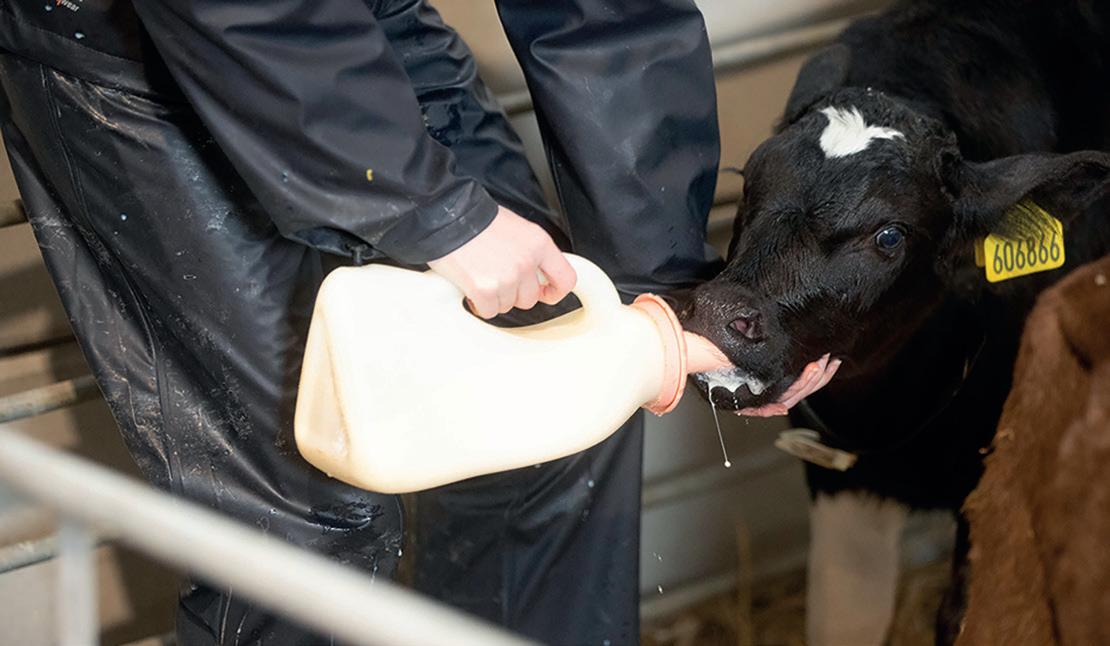
www.farmingscotlandmagazine.com
livestock
58

Often overlooked bull fertility test key to maximising suckler margins
Routine testing of bull fertility is an essential but often overlooked aspect of suckler herd profitability. Yet with funding available, Beef Specialist, Sarah Balfour, is urging beef farmers to be on the front foot this season.
Suckler herd performance relies on optimal fertility, and managing and improving herd fertility is one key route to improve cow margins while also reducing the impact of beef production on the environment, says Sarah, who is based at the Elgin office of SAC Consulting, part of Scotland’s Rural College (SRUC):
“Many farmers have taken advantage of the attractive cull cow price over the past 18 months, opting to cull poor


livestock www.farmingscotlandmagazine.com 60
and underperforming animals to improve efficiency, but how many farmers have semen tested stock bulls to identify underperforming and sub fertile bulls? Often semen testing is reactive, when a problem is suspected with a bull, but there is significant advantage to testing bulls at the start of the breeding season so you can make management decisions and get the maximum returns from that bull.”
Productive herds also have less environmental impact, which helps Scotland’s beef industry meet sustainability goals. SAC Consulting delivers Farming for a Better Climate (FFBC), an initiative funded by Scottish Government, to support farmers to introduce pragmatic practices on farm to both reduce environmental impact and enhance productivity.
Managing and improving suckler herd fertility strongly correlates with reduced production and environmental costs per kilogram of beef sold, says Sarah.
“To achieve industry performance targets for suckler herds, 65% of cows should be calving within the first three weeks of the calving season starting and 90% within nine weeks.
“Maintaining a compact calving period makes it easier to manage calves at a similar age and stage. It reduces the risk of disease spread from older calves to younger vulnerable calves and makes feed rationing easier. Earlier born heifer calves are also likely to be suitable weight and age for bulling to calve at two rather than three years of age, reducing the costs of production for replacements as well as improving their lifetime productivity. Equally, the more cows in calf and the greater number of healthy calves, the better for the environment.”
Using SAC Consulting data, it was shown that achieving 5% greater calf numbers - reducing barren cows and calf mortality by 5 in 100 cows bred - could improve finisher cattle sales by over 3t liveweight per 100 cows and reduce greenhouse gas emissions by 10% per kg carcase weight.
A three-year trial run by SRUC Vet, Iain McCormick, found that, on average, one in five bulls fail a fertility test, irrespective of age or breed, with young bulls failing as much as older stock bulls. With there being no guarantee that a bull will retain fertility from one breeding season to the next, it is vital you know bulls are capable of getting cows in calf, advises Sarah.
Computer tomography (CT) scanning enhances terminal sire selection and flock performance

Technology for managing flock performance is continually evolving and Quality Meat Scotland (QMS), in conjunction with Scotland’s Rural College (SRUC), is offering Scottish sheep breeders an opportunity to increase genetic gain and improve the productivity and sustainability of their flocks.
The use of computer tomography (CT), alongside ultrasound scanning of sheep, is being increasingly used to understand the genetic potential of performance recorded pedigree terminal sires. A CT scanning machine mimics a carcase grader, measuring the diameter of muscles at fixed points around the animal, calculating muscle dimensions, muscle volume, bone density, internal fat, spine length and pelvic dimensions. The resulting measurements are recorded
as Estimated Breeding Values (EBVs) and offer the key performance traits of terminal breeding sires, informing ram purchasing decisions. Selecting genetically superior rams can support faster genetic progress in important commercial traits like Eye Muscle Area.
SRUC Edinburgh offers CT scanning of rams for sheep breeders based in Scotland with QMS covering 50% of the cost per ram. Rams must be at least 40kg and recorded pedigree terminal sire breeds. A minimum of five and maximum of 15 ram lambs are permitted per flock or business. Mobile sites can be booked for a minimum of two days at each session, with 50 lambs per day booked in for scanning. Please check the Signet Breeding Services website for more information.
Dates offered for scanning at SRUC Edinburgh are:
April 17-18, May 13-1, June 10- 12, July 8- 10, August 5– 7, September 18-19, September 30 - October 3. Other dates may be available if required. For more information or to book please contact: QMS Industry Development Co-ordinator, Lesley Mitchell: lmitchell@qmscotland.co.uk T:07741150964
www.farmingscotlandmagazine.com 75 livestock 62
Details can be found at www.qmscotland.co.uk
61
FARMING SCOTLAND MAGAZINE Next issue out May 2024 Subscription page 36
Stronger Delaval brush designed for cattle

DeLaval has extended its range of swinging cow brushes with the new reinforced Swinging Beef Brush (SBB) which has been specifically designed for beef cattle, especially those with horns and longer hair.
Over five million DeLaval cow brushes are used in more than 80 countries. However, the majority are frequented by dairy cows, which has led to the development of the SBB for beef cattle. The new model features reinforced cable protection and more details in stainless steel to help it stand up to more boisterous use.
Lisa Harris, DeLaval Aftermarket Solution Manager
for the UK & Ireland, explains:
“The new SBB is specially designed to be used by beef cattle with horns or long hair. Beef cattle are often larger and exhibit different behaviour to dairy cows. It is also common for beef cattle to exert significantly more force on the brush.
Therefore, the SBB has much greater tolerances, making it our toughest and most robust brush ever.”
The new brush also reflects growing demand to improve animal health and welfare.
Access to grooming helps cattle to remove dirt, parasites and other contaminants from skin and hair which is thought to
positively influence the animal’s affective state. “Research shows that cows show as much desire to be groomed as to be fed*. DeLaval’s focus is always on animal health and welfare whether that be when designing a milking parlour or a piece of equipment like the SBB, because we believe that happy livestock will be more productive,” says Harris.
Cattle choose when to visit the brush which starts to rotate when contact is made. It swings freely in all directions, and the bristles length and hardness has been calibrated to stimulate blood circulation. Each visit also helps cattle to stay clean and calm.
www.farmingscotlandmagazine.com
“The SBB also has specially designed flaps in the cylinder to help prevent hair from getting stuck which will reduce maintenance for customers,” adds Harris.
During the development phase the SBB underwent testing in countries with varying climates over several years. The majority of the farmers testified that the brush provided cleaner and shinier fur, reduced parasites, and calmer animals.
“By extending the range of cow brushes, DeLaval can now offer stationary and swinging cow brushes for calves, goats, young stock, dairy cows, and beef cattle,” she concludes.
livestock
62
Nutrition and breeding management are essential for cows and replacement heifers to hit reproduction KPIs
Replacement heifers and postcalving cows are under a lot of pressure to hit breeding KPIs. The benefits of Maxx Cattle Booster Plus new formulation will help achieve this.
A new formulation of Maxx Cattle Booster Plus will help support herd fertility when fed to replacement heifers and bulling cows in the run up to, and during, breeding.
According to Dr Alison Bond, nutritionist for Rumenco, Maxx Cattle Booster Plus contains Celmanax, a yeast fermentation culture, Availa performance minerals, high protein levels
and easily accessible sugars. This combination of ingredients promotes rumen health, feed digestion, liveweight gain, body condition, milk production and overall performance.
These are all fundamental components to creating a sustainable and economically efficient breeding cattle system by accelerating the age at which a replacement heifer calves down and the speed at which cows gets back into calf post-calving.
“Age at first calving will have a major effect on the lifetime production of a breeding cow whether in the beef or dairy herd.
The current target for age at first calving is around 24 months of age, resulting in one more calf during their time in the herd compared to a heifer not calving down until three years,” explains Dr Bond. “Not only does this allow producers to accelerate genetic progress by making retainment decisions much more quickly, but it also maximises forage availability. Industry data from Grange Beef Centre shows that calving at three years instead of two results in a 50% lower net margin per hectare for spring calving grass-based systems.”
In the cow herd, the challenge is to have cows back in calf within
80 days of calving to maintain a 365-day calving interval. Ideally, cows will get bred around 60 days post-calving at first oestrus. Data shows that accelerating the rate it takes cows to get back into calf for tighter calving blocks has significant economic benefits.
Reducing the calving period from 18 to 9 weeks can increase average calf weaning weight by 47kg, with anything extending beyond 12 weeks costing £3.55 per cow per day.
“For both replacement heifers and cows, the sustainability of resource utilisation and economic impact of delayed pregnancy
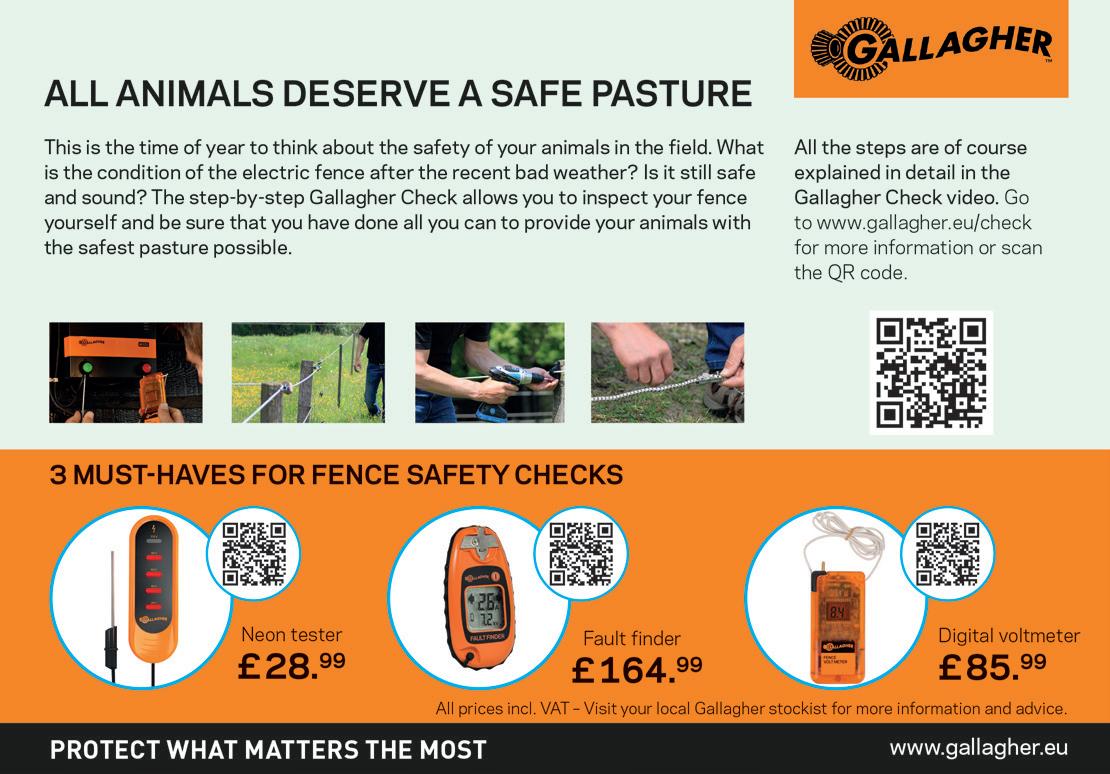
livestock www.farmingscotlandmagazine.com 63
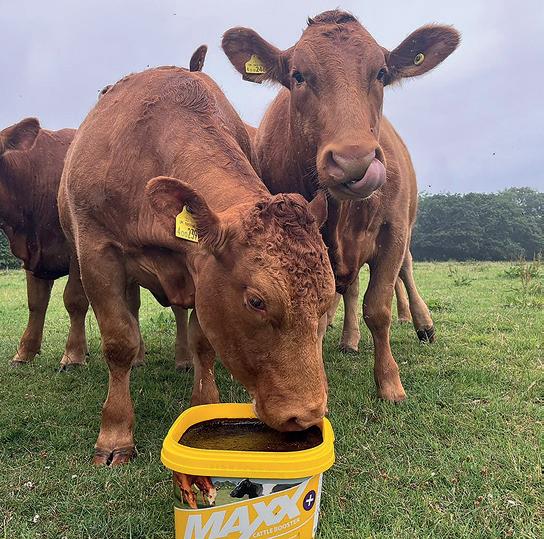
is significant,” says Dr Bond. “However, current figures for the UK indicate the average calving interval to be 440 days with approximately 88 calves being
born for every 100 cows or heifers. AHDB’s target is 94 calves born per 100 cows or heifers put to the bull – meaning, there’s room for improvement.”
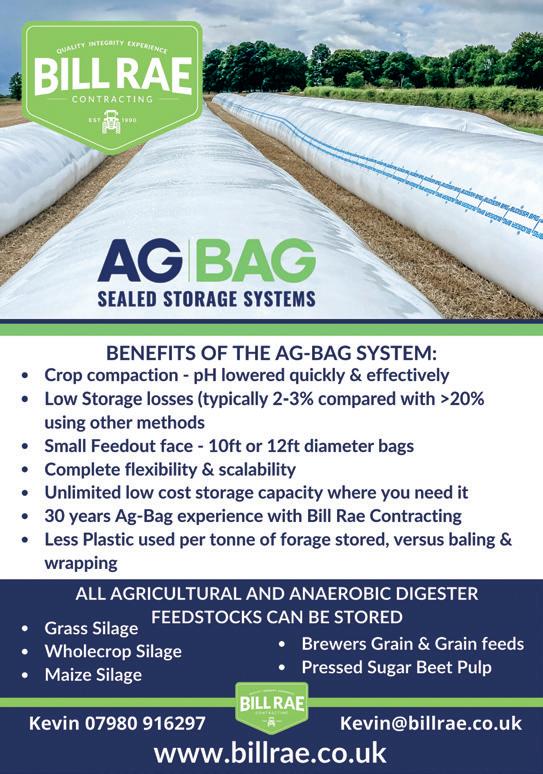
Additional mart data to be published on QMS website
Following the changes at the start of the year in the reporting and publishing of auction market livestock prices across Great Britain, the Institute of Auctioneers and Appraisers in Scotland (IAAS) is pleased to announce that it has extended its relationship with ScotEID and Quality Meat Scotland (QMS) to allow more Scottish pricing data to be published on QMS’ Market Prices website page.
From the start of 2024, a change in contractual arrangements in England and Wales meant that AHDB is no longer publishing liveweight mart data from around GB on its website.
Executive Director of IAAS, Neil Wilson, said:
“We are aware how important the latest price information is to business-making decisions on livestock farms across the country and have been in discussions for several months on how we, as an industry, can
continue to provide access to useful and independent market data.
“As a first step, IAAS is working with QMS and ScotEID to enhance what QMS currently publishes and some of that information is now available. We will continue to look at different options for making more comprehensive data available depending on what livestock farmers feel they need for their businesses, and we would like producers to feed back to us on this.”
QMS currently publishes auction market data for finished/ prime and cull stock sold at Scottish auction markets. The updated arrangement will include information from the Border Marts as well as store stock data. QMS Chief Executive Sarah Millar said:
The live market pricing data can be found here
https://qmscotland.co.uk/ markets-prices/market-prices.
Bovigen Scour –Scour protection that last
Virbac is excited to announce changes to the SPC of one of their best-selling livestock brands Bovigen Scour.
Bovigen Scour is a one shot vaccine for the immunisation of pregnant cows and heifers to raise antibodies against E.coli F5 (K99), rotavirus and coronavirus. Passive immunity is achieved through feeding calves with sufficient colostrum from vaccinated cows during the
www.farmingscotlandmagazine.com
first week of life. The antibodies reduce the severity of diarrhoea and reduce the shedding of virus by calves infected with bovine rotavirus or bovine coronavirus.
Bovigen Scour has been granted a 10 day shelf life from first puncture of the vial. The broached bottle must be kept refrigerated between 20C and 80C until the next use. Whilst this may not seem a huge change, this significantly increases the cost
livestock
64

effectiveness and convenience of use to cattle farmers. Bovigen Scour is available in 5 and 30 dose bottles. The SPC changes mean that:
- Administration is more convenient as cows do not have to be handled all at the same time or treated on the same day.
- Protection from calf scours is more cost effective as the larger 30 dose bottles can be used. The vial does not have to be thrown away after the first broach so there is less wastage.
- Bovigen Scour is a one shot vaccine with a wide vaccination window. It is to be given 12-3 weeks before calving, so there is more opportunity for farmers to vaccinate more of their dams, reducing the effects of neonatal calf diarrhoea and providing increased peace of mind.
For more information on how you can use Bovigen Scour to reduce the impact of scours in your calves, please speak to your vet.
Bovigen®Scour emulsion for injection for cattle contains inactivated antigens: Bovine rotavirus strain TM-91, serotype G6P1; Bovine coronavirus strain C-197; Escheria coli strain EC/17 (F5/K99 antigens.) POM-VPS
Advice on the use of this medicine must be sought from your veterinary surgeon. Further information available from the package leaflet, SPC or from Virbac Ltd. Woolpit Business Park, Windmill Avenue, Woolpit, Bury St. Edmunds, Suffolk IP30 9UP. Tel: +44 (0) 1359 243243
Email enquiries@virbac.co.uk
https://uk.virbac.com
Use medicines responsibly. www.noah.co.uk/responsible
The VET Mastitis Been Bothering Ewe?
 By Balfour Hay Northvet Veterinary Group
By Balfour Hay Northvet Veterinary Group
Much of our attention at lambing time is placed on keeping those new arrivals healthy, but we must not forget about the dam! Mastitis is a particularly common ailment of the ewe which is costly for many reasons –poor lamb growth, lamb & ewe mortalities, increased culling rates, and treatment costs.
Mastitis occurs when bacteria gain entry through the teat to infect the udder. Several factors may contribute to this:
• Nutritional Status – poor nutrition, suboptimal body condition, and underlying diseases (e.g. fluke) can lead to low milk production. This results in hungry lambs repeatedly trying to suckle and damaging the teats, allowing infection to enter. Hungry lambs may then spread infection by suckling other ewes. Ewes
in poor condition are also much more susceptible to infection in general.
• Teat Damage – other factors such as Orf outbreaks may also damage the teats and promote mastitis problems.
• Poor Hygiene – this allows bacteria to multiply, increasing the chance of infection and promoting spread.
• Others – cold exposure, udder conformation, weaning management, and MaediVisna may also contribute on some farms.
Acute cases of mastitis require prompt treatment with injectable antibiotics & antiinflammatories. Severe cases may be fatal. Many ewes go on to develop chronic mastitis, often detected pre-tupping as permanently damaged lumpy udders, necessitating culling.

What can we do to prevent mastitis?
√ Optimise pre-lambing nutrition (especially for ewes carrying multiples) – consider metabolic blood tests from your vet to assess adequacy
√ Perfect hygiene around lambing
√ Detect & cull all ewes with chronic mastitis pre-tupping
√ Control Orf & Maedi-Visna
√ Aim to breed ewes with good udder conformation
√ Provide shelter to avoid cold/wind exposure
√ Vaccination – aimed at reducing the impact of mastitis caused by Staphylococcus aureus specifically, the mastitis vaccine is suitable for some flocks with high incidences of this infection.
Discuss with your vet the best approach for tackling mastitis in your flock!

livestock www.farmingscotlandmagazine.com 65
Promoting fertility and milk fat production at turnout
Spring turnout creates many dietary challenges for dairy herds that can result in butterfat depression and fertility issues. However, negative effects can be reduced by balancing rumen function and energy supply, says Dr Richard Kirkland, ruminant nutritionist for Volac Wilmar Feed Ingredients.
“As cows transition from a controlled winter ration to grazed grass, the rumen has to adapt to the differing and more-variable forage source. The diet change alone can cause challenges to rumen function and milk production stability. Additionally, the low fibre and rapid fermentability of early, leafy grass growth can disturb the rumen’s pH balance and cause the grass to pass through the digestive system too quickly, increasing the risk of acidosis,” says Dr Kirkland. “While early grass growth is high in energy, variable spring grazing conditions make it harder for energy supply to be consistently maximised, with a drop in fertility and milk production key risks.”
During early lactation, cows cannot eat enough to meet the high energy demands of milk production, leading to a negative energy balance. This means they rely on body fat stores to support the genetic drive for milk production, resulting in a loss of body condition. Research from the University of Nottingham indicates that for each 0.5-unit loss in condition during this period, conception rates can fall by around 10%.
Cereals are commonly supplemented to increase energy supply, but there is a limit on how much can be used in order to reduce the risk of the rapidly-fermentable starch pushing down rumen pH and with it increasing the risk of acidosis and low milk fat.
“Digestible fibre sources such as soya hulls, citrus and
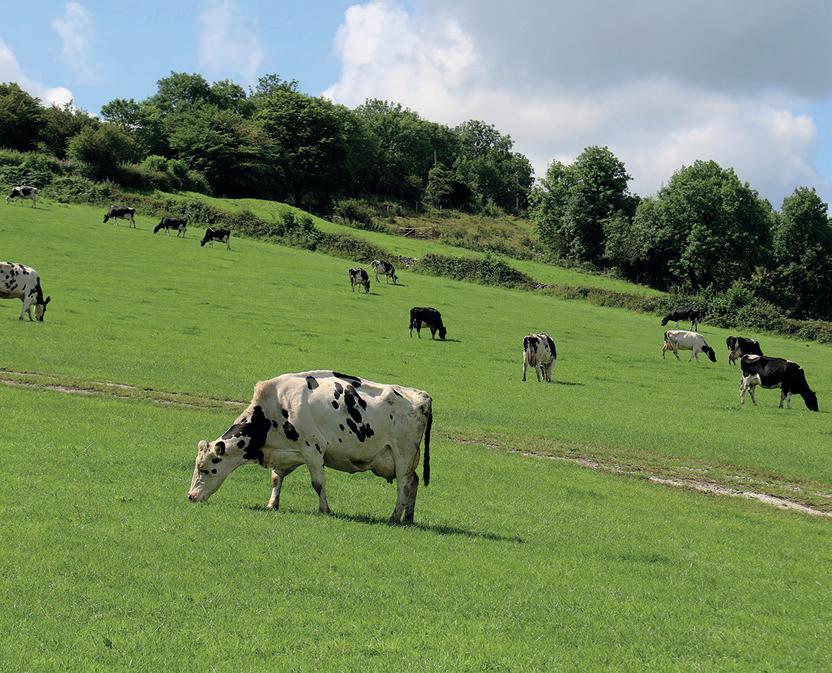
sugarbeet pulp will help balance the starchy energy sources and aid rumen function and milk fat, though offer less of the rumen ‘tickle’ factor than higher-fibre forages. With lower energy concentration than cereals, the greater bulk of forage sources will limit the potential to deliver those vital additional megajoules,” explains Dr Kirkland.
According to him, using a combination of digestible fibre sources and rumen-protected fat supplements in buffer rations will help drive milk production and support fertility in early lactation.
“In contrast to other ingredients, rumen-protected fats are not fermented in the rumen and contain around 2.5-times the energy content of cereals. This makes them an ideal choice to sustain energy supply at grass where conditions
can be unpredictable on a daily basis,” says Dr Kirkland.
Selecting the right fat supplement
When selecting a fat supplement to feed in turnout buffer rations, Dr Kirkland says producers need to remember that fat is more than just an energy dense ingredient, with the blend of fatty acids having a primary impact on performance response. Therefore, fatty acid blends should reflect what the farm is trying to achieve and milk contract requirements.
“During the early lactation period, C18:1 (oleic acid) is a key fatty acid, increasing partitioning of energy and nutrients to improve body condition as well as improving development of fertilised eggs. However, given the challenges of early spring grass, products containing higher levels of C16:0 (palmitic acid)
can be considered as effective ingredients to increase milk fat production,” explains Dr Kirkland.
To take advantage of the so-called ‘high-C16’ milk fat benefits while protecting fertility, Dr Kirkland recommends feeding a balanced supplement such as Mega-Fat 70. This will provide a higher level of C16:0 than the standard calcium salts but still supplies that important rumen-protected source of C18:1.
“By understanding the impact individual fatty acids have on production response throughout the lactation cycle, rumen-protected fat supplements become multi-purpose and allow producers the opportunity to balance rumen function and energy supply, while also targeting specific milk contract and herd performance goals,” concludes Dr Kirkland.
dairy
www.farmingscotlandmagazine.com 66
Harper Adams victorious once again in this year’s dairy student award
Jon Witter, a student at Harper Adams University, has beaten off five other finalists in a closely fought contest to win this year’s RABDF Dairy Student Award, sponsored by ForFarmers.
The award, which has been running for over a decade, is open to entrants studying at universities and colleges, and is highly regarded throughout the whole sector. Taking the form of 1,500 word essay in response to a case study prepared by Kite Consulting and delivering a presentation to a panel of judges at the Farmer’s Club in London.
The winner was announced at Dairy-Tech, the RABDF’s flagship event, on Wednesday 7 February. The presentation saw Jon take home a cheque for £750. Teddy Moore from Reading University was named the runner up.
The competition, run by the Royal Association of British
Dairy Farmers (RABDF), is designed to reflect real-life challenges seen on dairy farms and broader policy issues and identify some of the sector’s rising stars and new entrants.
This year’s judging panel consisted of RABDF Chairman Robert Craig, who was joined by Alison Ewing from ForFarmers and Kaia Hillsmith from Kite Consulting.
Commenting on the winner, Mr Craig said: “The standard of this year’s students was incredibly high, making the final decision almost impossible.
“Jon gave an excellent presentation which highlighted his knowledge of dairy farming both at home and on a wider level concerning the industry as a whole.”
“This is the first year ForFarmers have sponsored the award, something we are proud to be associated with,”

explains ForFarmers Technical Development Manager, Alison Ewing.
She said: “I thoroughly enjoyed the judging process and meeting the finalists; their passion for the dairy industry was infectious, once nerves were overcome.
“Congratulations to all and especially to Jon and Teddy, as
winner and runner-up. I hope they start their dairy careers with good support and mentors to harness their enthusiasm and knowledge.”
The award winners were announced on the Dairy Hub at Dairy-Tech and were presented by RABDF Chairman Robert Craig.
Assess semen quality quickly and easily
Artificial insemination (AI) is an important tool for the majority of dairy farmers, but the quality and viability of the semen used can make or break a breeding season. One semen analyser tool – Dynescan - aims to provide confidence with one simple, quick test.
The Dynescan is a portable semen analyser which measures semen lifetime and quality, and provides insights into how long semen mobility can be sustained.
One vet who has been using the Dynescan is Dave Gilbert, founder of Horizon Dairy Vets. “I’ve been in practice for the best part of 20 years, and have worked with a lot of block calving herds. Semen quality is important to all dairy farmers but block calvers have always been more aware of it,” he explains.
“If there is a bad batch of semen used on an all-year-round
calving herd they notice when the cows start returning, but it has a limited impact because they’ve probably only served 5-10% of the herd. But on a block-calving herd, they’re intending to serve nearly every cow in the first three weeks, before they can even realise they have a problem, so it can have some quite profound impacts on the block and fertility.”
Analysing semen quality is not new to Mr Gilbert. “I have been asked for around 15 years now if I could look at batches of semen and get them tested.”
And semen quality can vary, particularly after it has left the bull stud. “There are a number of reasons why semen quality may vary, and I have a lot of experience of frozen semen –while a tremendous tool it is quite a fragile commodity. It’s

not as simple as semen being dead or alive, there are variations between batches in terms of performance and so forth,” he adds.
“I do a lot of AI audits for handling semen, and there are several people that will handle the semen on its journey from the bull stud to the dairy. All of those are opportunities for
mistakes, errors and problems to occur. Often if it’s mishandled the semen will initially be okay but die off quite quickly.”
It is possible to look at semen on-farm through a microscope, but this has its limitations, says Mr Gilbert. “It’s pretty limited; it’s by no means as good an assessment as they would do at the bull stud. But those are large, complicated and
dairy www.farmingscotlandmagazine.com 67
expensive pieces of equipment, so there has been a need and a gap in the market for something in between.”
This is where the Dynescan comes in. “We tested out the
Dynescan with our block calvers, and I liked the system because I had a greater degree of confidence in the measurement. It ruled out the degree of subjectivity of doing things by
eye, and produced something that would be repeatable.
“Our clients liked the system and its insights, which gave them confidence in the service. I think it’s a valuable tool for farmers to assess
how they’re handling the semen, and for the industry.” he notes. “I believe the semen companies would far rather find out they have a problem with a batch before it has gone into 100 cows.”
New UK silage trial shows inoculant increased FCM milk yields by 1.9kg/day
Malvern, United Kingdom – A new UK-based trial undertaken at Reading University indicates that using an inoculant on grass silage can improve clamp stability, increase feedable dry matter by 29% and improve fatcorrected milk yields by 1.9 kg/ day.
Lee Gresham, UK and Ireland country manager at Lallemand Animal Nutrition, explains the trial shows how the use of a crop- and conditionspecific inoculant on UK grass silage can offer massive benefits on farm.
Mr Gresham explains the trial used 28% DM grass harvested in April, with half the crop treated with Magniva Platinum Grass Dry and the other half left untreated. The trial looked at how the inoculant impacted the grass’ fermentation, locking in nutrients, and how this translated into cow performance when feeding the silage.
“There were significantly higher dry matter losses in the control clamp than the treated clamp, which means there was less silage available for the cows,” he says.
“Due to the dry matter losses, the untreated clamp shrunk considerably more than the treated clamp, equating to 29% more feedable dry matter,” explains Mr Gresham.
The fermentation results from the two clamps showed that the treated silage had superior lactic, acetic and propane diol acid profiles and it had 10 times less butyric acid.

“The lower butyric acid in the treated silage indicates that clostridia, the bacteria that break down protein and cause foulsmelling silage, were effectively inhibited. This resulted in a more palatable silage, which was evident in the increased dry matter intake seen in the group of cows receiving treated silage in their ration,” he says.
Aerobic stability was also improved in the treated silage. This resulted in less heating in the clamp, reducing the energy lost to the environment as heat instead of being turned into milk by the cows. This energy loss is caused by aerobic spoilage that occurs when air gets into the
clamp and activates spoilage microbes, including yeasts and moulds.
“The control clamp temperatures peaked at 34.6oC, whereas the treated silage reached only 26.7oC – a significant difference in energy terms.”
“This extra 8oC of heating in the control group is the equivalent of losing 28MJ of energy for every tonne of silage fresh weight that is unstable. This equates to 5.4kg of milk lost,” he says.
Mr Gresham says significant improvements were also seen in cow performance when cows were fed the treated silage.
“The well preserved and stable treated silage resulted in a significant increase in dry matter intake by 1.5 kg/day compared to the control. This correlated with an increase in fat-corrected milk of 1.9kg/day,” he explains.
“A 0.1% improvement in protein and 0.19% increase in fat was seen in the milk constituents when comparing treatment and control group cows.
“The trial shows that with the increased feedable dry matter and energy available in the treated forage, as well as improved dry matter intakes and milk yields, producers will see a good return on investment if they use an inoculant when making grass silage.”
dairy
www.farmingscotlandmagazine.com 68

Major industry-wide mobility initiative kicks off
A major new industry-wide initiative committed to helping dairy farmers reduce the consequences of compromised mobility in their herds and improve productivity and reduce losses has been launched. The first activity being undertaken is a ground-breaking national mobility survey.
“Lameness continues to be a major cattle health and welfare challenge facing UK producers. It impacts herd fertility, productivity, profitability and sustainability, and lameness losses contribute to the environmental impact of livestock farming,” comments Matt Dobbs from HerdVision, one of the partners in Stride – the UK dairy mobility initiative.
“Despite this, there is no national picture of lameness in dairy cows. The aim of Stride is to rectify this position and by so doing help signpost the industry to practical solutions that will help improve mobility in the national herd.”
Representing a broad range of companies involved in helping farmers improve foot health and mobility, the partners in the Stride initiative are Ceva, HerdVision, IVC Farm Vets, Neogen and Zinpro. In addition, a number of industry organisations are supporting the initiative.
“Our aim, based around the national survey, is to identify current producers’ views on lameness, its impact on herd


crofting
Much still to discuss on the future of subsidy payments
health and welfare, and their businesses’ bottom line,” Mr Dobbs continues. “The outcomes will be used to inform the wider industry, communicate clear actions to help producers take steps to reduce lameness in their herds and so mitigate the costs and consequences of lameness to their businesses. We will be running a series of onfarm events focussed on mobility improvement over the summer and highlighting the importance of reducing cow lameness to industry stakeholders and government.
“We hope farmers will be prepared to spend a few minutes completing the online survey which is the start of our activities so we can build a comprehensive picture of UK dairy cow mobility and develop meaningful actions to raise mobility levels across the national herd,” Mr Dobbs continues.
All completed surveys will be entered into a draw to win a range of prizes donated by the sponsors. To complete the survey, scan the QR code below. www.farmingscotlandmagazine.com
 By Donna Smith
By Donna Smith
Well, my goodness, what a start to 2024 we’ve had with the weather! Floods, blizzards and stormy winds have presented many challenges and we can only hope that is not a sign for the year to come when there is so much at stake for the future of agriculture.
Early January saw the first Cross Party Group on Crofting take place where the main topic was on current proposals for future subsidies around improving cattle herd efficiencies through the introduction of new conditionality on calving intervals. The presentation from Scottish Government’s Head of Livestock Production Policy, John Armour, led to a fair bit of discussion and questions afterwards.
While crofters agree in principle that efficiency needs to be increased, and may be achievable in small herds, low-input systems and remote locations, it may be more labour intensive and we feel that conclusive is evidence lacking.
In a letter to John Armour following the meeting the SCF have requested that evidence be provided that these improved calving
efficiencies can be achieved for small herds in the Highlands and Islands region before any final decisions are made and also urged for a derogation from the calving intervals for small herds.
We also recently had a meeting with Gillian Martin MSP, Minister for Energy and the Environment recently where we took the opportunity to press for a much more holistic approach to the development of future policy.
Ms Martin stated that there is recognition that government should ensure that access to future payments is not too onerous for crofters and that they should be supported appropriately. She also made clear her view that government should look for opportunities to reward people for what they are doing on the land, not just for having the land itself, recognising that crofting is already delivering some of the key objectives.
A welcome statement but we now need to ensure that Government follow through with some positive action that demonstrates this commitment.

dairy
www.crofting.org
Good things come in threes
Increasing outputs key to triplet lambs being a blessing rather than a curse
Generations of shepherds have wondered how to best deal with triplet lambs and research from SAC Consulting, part of Scotland’s Rural College (SRUC), is taking the trial and error out of rearing them.
A healthy turnout from Scotland’s sheep farming community joined a live webinar entitled Increasing Flock Output, with the emphasis on triplet lambs and their mothers.
Professor Cathy Dwyer, head of SRUC’s animal behaviour and welfare research team, told the online audience: “It’s better for a triplet lamb to be reared by the ewe.
“Most ewes can rear three lambs, but to do so they need extra nutrition and support.”
Around 600 ewes and their lambs have been monitored by SRUC, over 30 different studies, showing survival rates for single lambs of 89.5%, twins 85.5% and only two-thirds, or 67.5%, of triplet lambs.
Whether or not to remove one of the triplet lambs - putting it either onto another ewe or rearing on the bottle - is an ageold dilemma for sheep farmers.
The expert conclusions are that unless the three lambs are very mis-matched in size or the offspring of a first-time mother or a ewe nearing the end of her breeding life in poorer condition keeping all lambs on their mother is always best; providing the pre lambing management and nutrition of the triplet bearing ewe is meeting all of her needs.
“Good nutrition provides the colostrum, that vital first milk, it also helps regulate body temperature and prevents hypothermia, speeds the maternal bond can be made and the closing up of the gut after birth which prevents infections,” explained Professor Dwyer, who added the first 24 hours are vital for triplet survival.
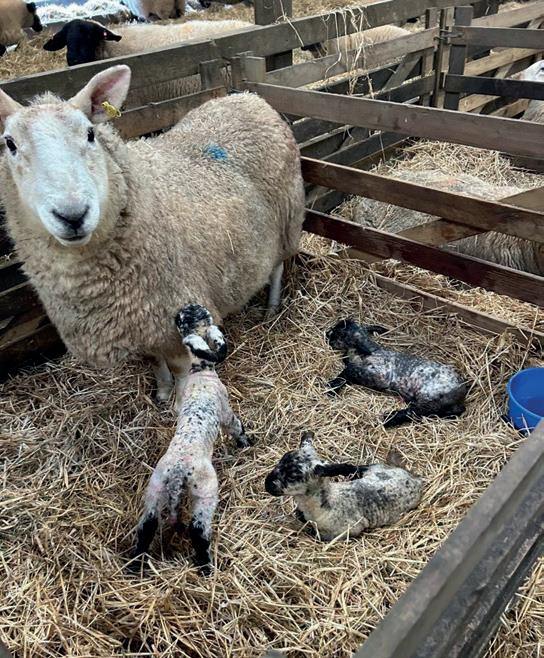
Foxes most likely responsible for lamb predation
New research investigating reports of badger predation on lambs on Scottish farms has found that foxes were responsible.
In response to growing concerns in the Scottish farming sector about the suspected role of badgers in killing and eating lambs, a study was carried out by Science & Advice for Scottish Agriculture (SASA) in partnership with NatureScot, National Farmers Union Scotland (NFUS) and Scottish Land & Estates (SLE).
As predation is rarely witnessed, 27 farms across Scotland volunteered to take
part in research to gather more evidence. The farmers came forward after a call for help to members of NFUS and SLE. At all the premises, farmers suspected they had previously lost lambs to badger predation.
In spring 2022 and 2023, postmortems were carried out on 29 carcasses from the participating farms to determine whether lambs had been killed and eaten (predated) or were fed on after death (scavenged). Predation was confirmed in 48% of lambs, 31% were scavenged after death and predation could not be ruled out for the remaining 21%.

DNA evidence from these 29 carcasses, plus 10 additional dead or injured lambs that were swabbed by farmers, was used to identify the species involved.
Fox DNA was present on 34 of the 39 lambs sampled (87%), including all the lambs that showed evidence of predation.
www.farmingscotlandmagazine.com 70 sheep
Give newborn lambs a nutritional boost with Lamb Shield
Newborn lambs will benefit from the nutritional boost provided by Lamb Shield, Nettex’s newest lamb energy and gut development supplement.
A highly concentrated energy source to help lambs thrive with body heat production, Lamb Shield has a multi-purpose formulation to support gut health and immune response.
The inclusion of egg proteins and selenised yeast supports healthy gut development with the availability of favourable bacteria. Paired with vitamins A, D and E, Lamb Shield also helps maintain the integrity and optimum function of reproductive, muscular, nervous and immune systems.
“Lamb Shield is a great product to have in your lambing toolkit to help uplift newborn lambs, especially those who need a nutrient boost to thrive,” says Emily Hall, livestock farmer andProduct Manager for Nettex. “The combination of energy, vitamins and gut support act as an insurance policy to get lambs off to a strong start.”

Lamb Shield is available in a 100ml pump bottle for quick and easy administration. Lambs requiring an energy boost should be administered 4ml orally.
To learn more about Lamb Shield and other Nettex products, visit net-tex.co.uk.
NSA Scotland recently held their hybrid Annual Regional Members Meeting (ARMM) in Selkirk and via Zoom at the start of February 2024. We are pleased to announce that Peter Myles, Edzell has been re-approved for his second year as NSA Scotland Chairman and will be supported in the role by Mary Dunlop, Biggar newly elected Vice Chair and Treasurer unopposed. We are also pleased welcome Debs Colley, Crawford to the role of Trustee alongside Pamela Nicol, Glenisla who was approved at the 2023 ARMM. Another new face for the NSA UK Policy and Technical Committee comes in the form of Clive Phillips, Glenbervie.
The NSA Scotland Committee is delighted to have new members and in particular four passionate individuals, all under the age of 30 join to represent the next generation of sheep farmers and crofters. This will not only open the door to be involved with policy and NSA Scotland activities it is also an opportunity for young people have a voice in their industry.
Despite lambing already underway in other parts of Great Britain, the increasing threat of Schmallenberg and Bluetongue outbreaks in England and Wales
leaves Scottish shepherds continuing to worry about what lies ahead in 2024. With no current vaccination or answer, overall health and welfare continues to be a priority. Predation is also another threat on the near horizon which poses significant threat to flock viability. Whilst not completely isolated to this time of year, the sheep industry continues to remain vigilant to ensure the health of the national flock whilst delivering the highest standard of sustainable food production in conjunction with many other faceted outcomes.
Another priority for the NSA Scotland is the new Agriculture and Rural Communities (Scotland) Bill which has started making its way through Holyrood. With the assurance from the First Minister that 70% of the Agricultural budget will be delivered in Tiers 1 and 2 with Less Favoured Area payments on top, it is the other legislative commitments currently being debated in Parliament that remain unclear.
Make sure to save the date! NSA Scotsheep 2024, Wednesday 5th June by kind permission of the Hamilton Family, Aikengall, Innerwick, Dunbar, EH42 1SG.
For further information, please visit https://www.nationalsheep.org.uk/webinars/
www.farmingscotlandmagazine.com
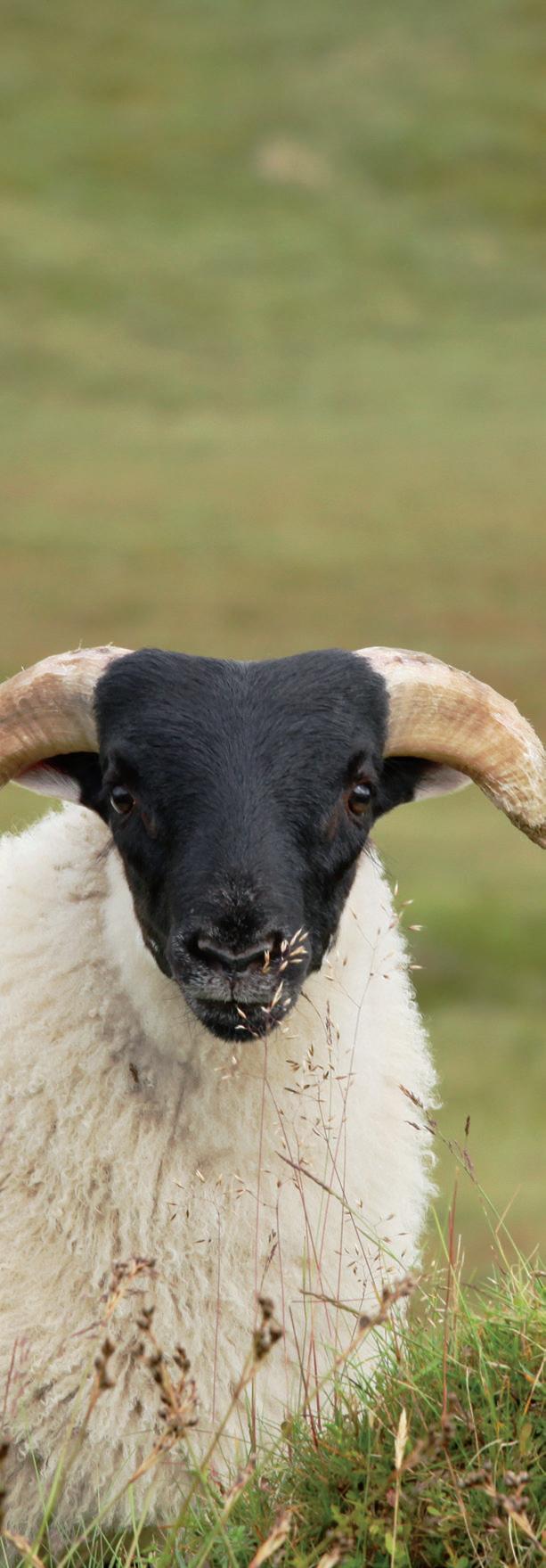

sheep
FARMING SCOTLAND MAGAZINE Next issue out May 2024 Subscription page 36
sheep Take care when formulating in-lamb ewe diets this spring
With 2023 forage analysis showing varying results, farmers need to take extra care when formulating in-lamb ewe diets, particularly where they have a lot of multiples.
Bryn Hughes, national sheep and beef specialist at Wynnstay, says they have collated the results of over 200 big bale samples produced by sheep farmers. The average results show energy levels of 10.2 ME/ kg DM, protein levels of 13% and a dry matter of 50%.
He says: “The average needs to be treated with caution as there is a big range within the samples, with some low energy and low quality, while some are high quality.
“There was a lot of silage made in September which is variable, but some surprisingly good forage was made in the autumn.”
Mr Hughes says ideally farmers should undertake forage analysis to understand the quality of their forage, so they
can formulate a ration specific to their situation. If this is not possible, he advises that farmers should assume forage is 10 ME or lower.
“When formulating rations for in-lamb ewes, it’s important to consider the ewes energy requirements depending on her size and the number of lambs she’s carrying. Once you know the value of the forage, you can make up the nutritional deficit with concentrates.
“When balancing the diet, there are several nutritional elements to consider. These include the energy, protein and mineral make-up of the diet,” says Mr Hughes. “Cake such as our Ewemaster Nuts are a good go to, as they have the optimum nutritional make-up,” he adds.
“The energy level of the cake should be at least 12.5 MJ to provide the starch and sugar required by ewes and contain a protein content of 18-19%, with at least 5% digestible

undegraded protein (DUP),” he says.
Mr Hughes says it is also important to look at the mineral
profile of the diet, as it needs to contain calcium, magnesium, phosphorus and at least 125mg vitamin E as well as cobalt and selenium.
Five steps to better surplus lamb growth
Sheep farmers with surplus lambs to rear over the 2024 lambing season are being encouraged to make the most of these newborns’ early life growth potential to boost flock returns.
Maximising the number of lambs sold per ewe put to the ram is one of the key benchmarks for a successful sheep farming enterprise. This will mean rearing some third lambs and orphans off the ewe, explains Dr Jessica Cooke from Volac Milk Replacers Limited.
“But with lamb prices currently trending 15% ahead of last year, rearing these surplus newborns quickly and efficiently yourself to potentially target an earlier premium market makes sound economic sense.
“And feeding a good quality, proven ewe milk replacer alongside good husbandry practices will help you capitalise on the lamb’s inherent early life, pre-weaning growth potential and be able to wean plenty of excellent extra lambs as soon as possible,” she says.
When it comes to rearing surplus lambs successfully, Dr Cooke advocates following five crucial steps for best results:
1. Don’t compromise with colostrum feeding
As with all newborn lambs, the first priority is to ensure every surplus lamb receives sufficient colostrum (50ml/kg liveweight per feed and a minimum of 210ml/kg liveweight within the first 24 hours). This feed
provides essential nutrition, as well as the important antibodies to help newborns fight off infections.
2. Choose the optimum rearing system
Surplus lambs can be reared on milk replacer via bottle, through ad lib bucket feeding or with automatic machine feeding. The method you choose will typically depend on the number of surplus lambs you have and the facilities that you have available.
If you are using a bucket or machine you will need to train lambs to suckle the teat. Be patient. If removing a surplus (e.g. third lamb) lamb from the ewe, take it away at 24 hours old, then leave it for a few hours to become hungry before gently introducing it to the
teat. Teats should be positioned 1215 inches from the ground.
3. Trust Lamlac for higher growth rates
Feeding trials with Lamlac ewe milk replacer at Harper Adams University College and Reaseheath College (2021) have demonstrated surplus lamb growth rates of over 300g per day. All lambs weighed at least 10kg at weaning at 35 days of age.
Additional work at Reeseheath College in 2023 showed lambs reared on Lamlac mixed and fed cold from about a week of age to weaning, drink as much and perform as well as lambs reared on warm milk. This highlights the opportunity to rear extra lambs off ewes on ad lib
www.farmingscotlandmagazine.com 72
Bryn Hughes, national sheep and beef specialist
cold milk where boiler heating capability may be non-existent or compromised.
4. Feed enough milk powder
A single lamb reared artificially to weaning (at an average of 35 days of age) will require a minimum of 9.5kg of Lamlac (equating to 47.5 litres of reconstituted ewe milk replacer).
5. Get your lamb husbandry right
Lambs reared artificially will also need constant access to fresh, clean water at all times. Top quality creep feed should also be readily available to lambs and be offered fresh at least once a day, with refusals being fed to older stock (e.g. ewes). Introduce clean, dry straw – preferably barley into racks. Don’t feed ad lib high quality roughage, for example hay, during milk feeding as this can depress concentrate intake and delay weaning.
For optimum rearing results, don’t keep more than 25 lambs
sheep
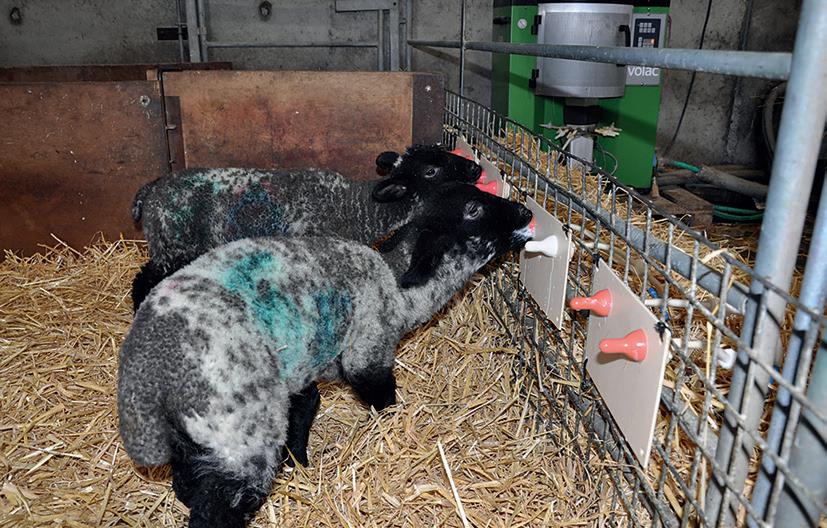
in a pen and keep similar ages and sizes together. Lambs must also have access to a clean, dry, straw-bedded lying area which is well ventilated but draught-
free. Check your lambs at least twice a day.Finally, maintain scrupulous hygiene protocols. For example, all feeding equipment should be thoroughly
cleaned each day and disinfected twice weekly.
For further information on successful surplus lamb rearing, visit: www.lamlac.co.uk

www.farmingscotlandmagazine.com 73
pigs Tackle the root cause of PWD with free diagnostic tests

Pig producers are being encouraged to reach out to their vets to perform free diagnostics if they are concerned about postweaning diarrhoea (PWD) on farm.
Elanco strategic account manager, Gillian Bryson explains that Elanco is funding veterinary testing for the F4 and F18 strains of E.coli which have shown to be present on 78% of farms and are a common causes of PWD.
Historically, zinc oxide has kept PWD at bay, but since its ban, Ms Bryson stresses the importance of understanding the root of the problem, as the use of zinc has masked a multitude of potential issues.
Producers can access fully funded diagnostic tests, such as rainbow kits and polymerase chain reaction (PCR) tests, free of charge through their vet.
“Rainbow test kits give an instant result and will confirm whether the herd is suffering from E.coli,” she explains.
“PCR tests don’t provide immediate results, but offer more detail, including identifying whether F4 and F18 strains are present on farm, even if E.coli is not directly affecting the herd.
“This is important because once these strains of E.coli are present, it is near on impossible to get rid of them, so preventative measures must be implemented to protect herds.”
Ms Bryson recommends producers work closely with their vets to put together a robust health management programme including the use of a vaccine to ensure effective protection against the most common strains of E.coli.
“Coliprotec™ is the only vaccine on the market to offer herds effective protection against F4 and F18 strains of E.coli. Piglets can be vaccinated from 18 days of age with onset of full immunity after seven days, providing early protection against the disease,” she says.
Piglets vaccinated with Coliprotec™ have shown increases in appetite resulting in slaughter weight gains of up
to 2kg[1], while also reaching market weights seven days earlier[2].
“If you have any concerns about PWD or E.coli, get in contact with your local vet to discuss how diagnostics can support the overall health of your herd,” she concludes.
Request your free diagnostic testing now:

74
www.farmingscotlandmagazine.com
Oregano oil and purple garlic prove perfect tonic for piglets
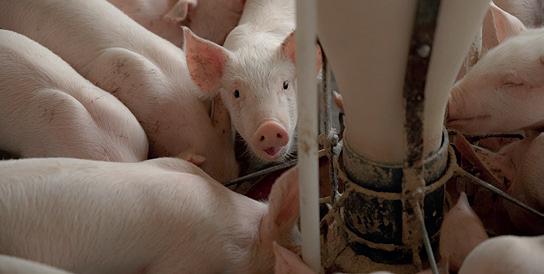
Researchers have been studying alternatives to zinc oxide in pig feed Oregano essential oil and purple garlic have been used by humans since ancient times for their health properties, including helping to boost immunity and improving gut health.
However, now scientists have found these ingredients could be used in pig feed as an alternative to zinc oxide, which is administered to weaning piglets to prevent and reduce digestive problems.
Zinc oxide, which is a pollutant for the environment and contributes to the development of antimicrobial resistance, is in the process of being banned in many countries.
The study, by researchers in Scotland and Spain, found oregano essential oil and purple garlic offer similar or superior results to zinc oxide when added to feed in terms of the effects on the structure of the intestine, bacterial species present in the intestine and resistance to antimicrobials of indicator bacteria.
Several groups of weaned piglets received different concentrations of oregano essential oil and purple garlic powder, zinc oxide or a combination of both. A control group, which received none of these compounds in the feed, was also present for comparison.
The researchers found the piglet groups which received the highest doses of oregano essential
oil and purple garlic powder had the best results for the measured parameters, and the results were similar or superior to those for the group that received zinc oxide.
The research was carried out in the Murcia region of Spain by scientists from Scotland’s Rural College (SRUC), the University of Murcia and the Institute for Agricultural and Environmental Development (IMIDA), in collaboration with the pig producing company Dalland Hybrid Espana S.A..
It was conducted on a commercial farm to replicate the conditions found in a typical farm in order to facilitate the direct application of the results.
Jorge Rivera Gomis, Research Associate at SRUC’s Centre for Epidemiology and Planetary Health in Inverness, said: “The weaning period is a critical step in pig production.
“This research on the use of oregano essential oil and purple garlic powder as alternatives to zinc oxide will help make pig production more resilient and sustainable by tackling current challenges such as antimicrobial resistance; reducing environmental contamination; meeting consumer demands of sustainably produced food; and adapting to new regulations and trends in animal production.”
Moving forward for Scottish farming
By Martin Kennedy, President NFU Scotland
The dust has settled on another fantastic NFUS AGM and conference, held in Glasgow at the start of February.
This national event is continuing to grow from strength to strength which really makes it a must-attend event in our farming calendar.
The focus on supply chain and profitability got us all thinking ahead, and it was absolutely tremendous for us to secure both the First Minister Humza Yousaf MSP and Cabinet Secretary Mairi Gougeon MSP, to speak to our members and take questions from the floor. It was really encouraging to hear the First Minister backing farming and stating his ambition to grow Scottish production for home and for export, and also to hear him recognise the strategic importance of food production in Scotland.
I cannot overstate the importance of the First Minister’s announcement that at least 70 per cent of future agricultural support will be allocated to Tiers 1 and 2 in Scotland’s future agricultural policy post 2027. These are the tiers that will reflect most closely the current direct payment regime that delivers schemes such as Basic Payment Scheme and Greening.
The First Minister also announced that, in addition, funding for the replacement for the Less Favoured Areas Support Scheme, currently worth £65 million, will be made available through Tier 2 once the replacement scheme has been decided.
We asked for the majority of funding to be allocated to Tier 1 and 2 for direct support. In addition, we also
asked for the retention of a disadvantaged area payment akin to LFASS and to retain the much-needed coupled payments. As a result of two years of tireless working on behalf of farmers and crofters these commitments have been met.
It has been a hard-fought battle in the face of formidable opposition by influential opponents. We will keep up our work on clarifying future support arrangements and pushing to ensure that Tiers 3 and 4 also deliver what the industry needs.
Scotland
Clarity on the funding split from Scottish Government is welcome; however, I cannot stress enough the importance that we need the UK Government to confirm what budget will be available. We will keep up the pressure on Westminster on the critical requirement for this ringfenced fund to continue to come to Scotland. Ahead of the forthcoming General Election this year, we are already preparing our own manifesto so that all parties are clear what Scottish agriculture needs to see from the next UK Government.
NFU Scotland is calling for all parties to include an increase of at least £1 billion in the UK Government’s annual commitment to UK farm funding from approximately £3.7 billion to £4.7 billion. This would equate to an additional sum of at least £170 million per year for Scotland and underpin the incredible work of Scotland’s farmers and crofters.
As I enter my final year as President, I will continue to fight on the behalf to secure the future that our iconic industry deserves.

www.nfus.org.uk
NFU
www.farmingscotlandmagazine.com 75 pigs
British Pig & Poultry Fair opens new doors

Pig, poultry and egg producers have the unique opportunity to come together this year to hear the latest ideas, gather advice and see new innovations at the biennial British Pig & Poultry Fair.
Attracting over 7,500 visitors and more than 330 exhibitors, the Fair – which has almost sold out of stand space - moves to a new venue in 2024; the National Exhibition Centre (NEC) in Birmingham. “The central location, excellent transport links and first rate facilities mean the Fair will be able to thrive both this year and in the future,” says event organiser Alice
Bell. “We are delighted to have secured a new home for what is such an important event for the industry.”
The Fair, which is partnered by ABN, will take place on Wednesday 15 and Thursday 16 May, and will feature dedicated forum theatres with high-profile expert speakers. Both the pig forum theatre; partnered by AHDB, and the poultry and egg forum theatre, will include muchanticipated sector outlooks, giving producers an insight into what the future holds for different parts of the supply chain.
“There will also be expert speakers covering technical
topics like nutrition, animal health and welfare, and business efficiencies,” says Danny Johnson, general manager at ABN. “As ever, there will be plenty of new innovations to explore, and a wide variety of supply businesses exhibiting. For pig and poultry producers, this is always the key event to attend to catch up with old friends and new suppliers, and to discuss the challenges and opportunities facing each sector.”
The event has long been renowned as the place for producers to find the latest ideas and solutions to take home and implement on their own farms.
www.farmingscotlandmagazine.com
Some 78% of visitors in 2022 planned to make changes to their business as a result of attending, and 93% rated their visit as good or excellent. “This year we have a new innovation theatre, which will be a chance to hear the latest thinking and to discover new products to help your business to thrive,” says Ms Bell. “There really is nowhere else to hear from so many experts, meet leading producers, see suppliers, and find out what is new, all in one day, under one roof.”
To find out more and to register for your FREE ticket visit www. pigandpoultry.org.uk
76 pigs
Shooting Scotland is back!
Stopped due to covid, we are slowly bringing our title back to life. Watch this space!
Scottish Grouse Bill
The latest developments
European Shooting Championships Award winning Scottish Gamekeeper to take part
Former grouse shoot for sale
78.04 acres of rural Aberdeenshire
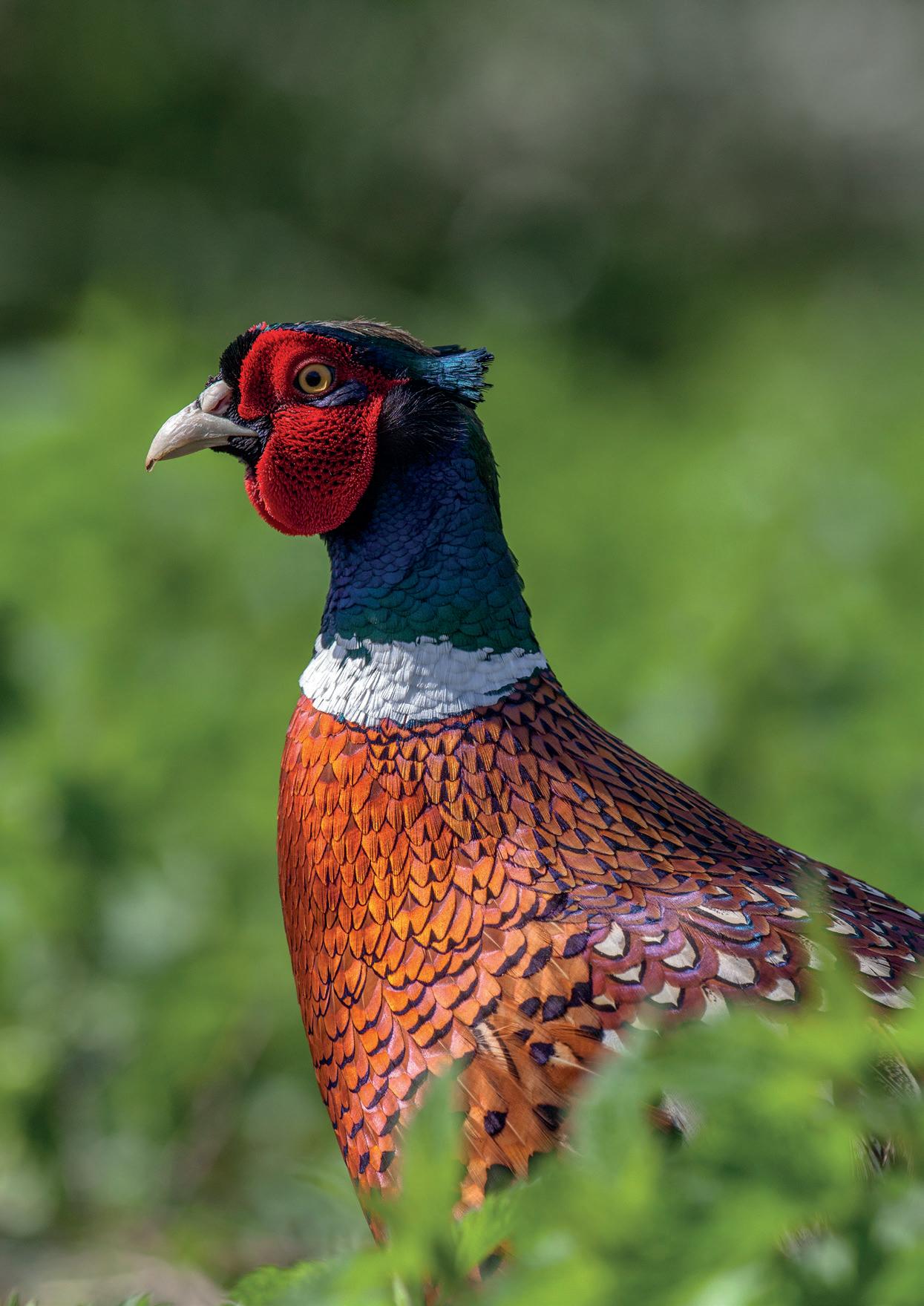
Scottish country Life With Jake Swindells, Scottish Countryside Alliance
Product news
New thermal spotter from Nightmaster
Rigby unveils the new Shikari rifle
Aimpoint announces new Acro S-2™ shotgun sight
Columns
Gamekeepers Welfare Trust
Scottish Land & Estates
Speyonline
& FISHING magazine

editor's bit
Hello and welcome to our ‘gentle re launch of our Shooting & Fishing Scotland title, now as part of our Farming Scotland Magazine.
It was with great sadness that after building up Shooting Scotland as an independent magazine to 76 pages and going from strength to strength, along came Covid and the closing down of all country sports hotels, shooting grounds and clubs etc, we had no choice but to cease publishing.
Today however, I am delighted to announce that the title is on the way back.
Christina and I have decided to take our time, and grow the title back again in a more gentle way – via Farming Scotland Magazine’s distribution.
We aren’t getting any younger (old man talk!), so bringing Shooting Scotland back as part of our farming magazine is less stressful for us than trying to launch another magazine from scratch - but who knows where we can take it from there.
The next Shooting Scotland will appear in our July – August issue, and I hope to have expanded it a little more by then.
Two magazines for the price of one can’t be a bad deal!
So, I look forward to receiving even more PR being emailed to me from now on, and I am delighted once again to represent the rural life of Scotland and further afield.
Best email to use: mail@ shootingscotlandmagzine.com
Slàinte, Athole.
Successful BASC amendments improve Scottish grouse Bill; but Bill still ‘unworkable’
BASC has claimed a significant victory in a crucial vote on the Wildlife Management and Muirburn (Scotland) Bill, which will ensure that grouse shooting continues unhampered.
MSPs in the Rural Affairs and Islands Committee recently entered the final day of voting on amendments to the Bill.
A previous session saw the Scottish Government amendment pass a ban on the use of snares, which BASC had opposed.
The Wildlife Management and Muirburn (Scotland) Bill seeks to introduce grouse shoot, muirburn and trapping licences. When first introduced, the bill did not provide the legal safeguards for licence holders in respect of grouse shoot licence suspension, a power which could have potentially contravened articles within the European Convention on Human Rights.
The vote removes disproportionate suspension powers, an issue BASC has lobbied MSPs and Ministers on over the past 12 months. Without its removal, grouse shoot, muirburn and trap licences could have been suspended or revoked for a disproportionately broad range of so- called “relevant offences”.
BASC has repeatedly said that it would be completely disproportionate and unreasonable for the initiation of an ‘official investigation’ to be the trigger for licence suspension.
The scale of financial loss for rural businesses could have been catastrophic, resulting in the loss of jobs and livelihoods,
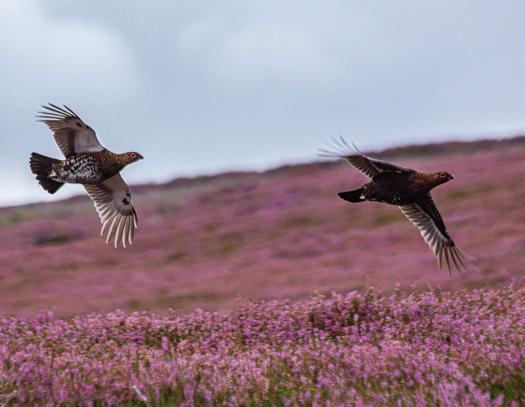
due to a vexatious allegation being made.
The extension of grouse shoot licences from one year to five years in duration is welcomed, however BASC made it clear that for sustainable grouse moor management, 10 years would be more appropriate for investment and planning. This amendment places the Bill in a more ‘workable’ position.
However, the Bill has ‘some way to go’ before being reasonable, particularly with regards to muirburn licensing, according to BASC Scotland director Peter Clark.
The organisation is looking to challenge the Bill, if key concerns on expansion of the SSPCA’s powers, the total ban on the use of snares without a licensing scheme, and the inclusion of more ‘relevant’ offences are not removed at Stage 3.
Mr Clark said: “It is evident that our lobbying and hard work engaging with MSPs and Ministers throughout this
Bill’s progress has removed a fundamental flaw in the Bill.
‘The power to suspend grouse shoot, muirburn and trap licences, even when NatureScot was not satisfied of any wrongdoing, was simply absurd, and we are glad our political pressure has seen this removal.
‘Inconsistent and disproportionate legislation could jeopardise the viability of moorland management, placing jobs, investments, and our capacity to safeguard upland biodiversity and carbon stores at risk.
‘While we may not fully endorse the necessity of implementing these licensing schemes, we acknowledge that their introduction stems from a political commitment.
‘Our amendments have been directed towards facilitating the development of legislation that is balanced, reasonable, effective, and practical.
‘BASC will be lobbying MSPs ahead of Stage 3, the final stage, to make further improvements.’
www.farmingscotlandmagazine.com 78 SHOOTING SCOTLAND
Award winning Scottish gamekeeper to shoot at euros
A Deeside youngster has achieved a boyhood ambition by being crowned Scotland’s best young gamekeeper, just weeks before representing his country in shooting’s European championships.
Finlay Shand (22) received the prestigious Young Gamekeeper of the Year Award 2023 from Alex Hogg, MBE, Chairman of organisers, The Scottish Gamekeepers Association (SGA), at GWCT Scottish Game Fair in the grounds of Scone Palace (Fri, 30th).
The award recognises externally nominated professionals in the early stages of a career on land or river who are adjudged to stand apart as ambassadors for gamekeeping, deer stalking or ghillie-ing.
Finlay, who works at Invermark Estate in Angus, impressed judges with his passion, maturity and management experience and his willingness to help educate others about the values of good stewardship of Scotland’s countryside.
His prowess on the clay shooting circuit, during his rare spare time away from grouse, deer and pheasants, was also commended by judges who praised his all-round commitment to his ‘calling’ and way of life.
By virtue of achieving qualification scores, Finlay will travel to Ireland next month to represent the Scots in the DTL discipline at the European and British championships as well as the Home Internationals.
Competing previously for the Scottish junior team, he secured a team Gold in the British Open and a 4th in the Euros as well as topping his previous highest scores.
Collecting the Young Gamekeeper of the Year accolade represented the culmination of a
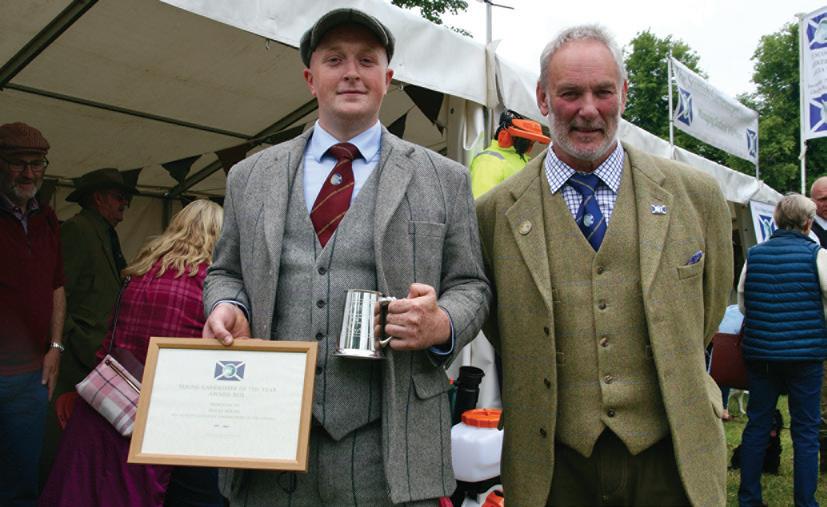
long-held wish for Finlay, who made it clear as a 12 year old at Aboyne Academy that he wanted to follow a family calling and find success in gamekeeping.
Father Allan ‘Hedge’ Shand is himself an award-winning Head gamekeeper at Finzean Estate in Aberdeenshire.
“My father actually encouraged me to learn a trade and said that I could always come back to gamekeeping, later. In all honesty, I was having none of it.
“Gamekeeping was always something I wanted to do. As soon as I was off the school bus, it was always a case of going straight back home to help dad,” said Finlay.
“Since then, I have learned so much from a lot of good people. I enjoy the great variety of the work, meeting sporting clients from all over the world and all walks of life.
“It is also good to get involved in the education side, helping people to learn more about what gamekeeping is and the benefits it creates in our landscape.”

www.farmingscotlandmagazine.com 79 SHOOTING SCOTLAND

The Gamekeepers’ Welfare Trust exists to support gamekeepers, stalkers, ghillies (river and deer) and anyone who has depended on the above for their living. This may have been for a short period of time or a whole career and does not mean we can’t assist those who have changed their job or those who are selfemployed.
Welfare suggests just health and financial assistance, but the Trust is proactive in the provision of training, job related queries, support in redundancy situations and so much more. Jamie’s Helpline is available for anything at all causing anxiety, difficulty or just to talk through things and provides information and/ or keeping in touch where required.
Health too, pertains to a wide range of support from financial help where long term and short-term difficulties cause shortfalls, to the Nurse Advice Clinic a helpline and online service which whilst run by professional nurses is not affiliated to the NHS and is completely confidential. Health Checks are available also to ensure that keepers and their families are in the best shape
to carry on an arduous and physically demanding job. Mental well-being is becoming better understood and recognised as just as important as physical health. GWT offer free counselling, mental health support and information as well as training through the STAG and HIND courses, developed by Ex-Marines and delivered specifically for the gamekeeping and stalking communities.
Living well means looking after ourselves and the Gamekeepers’ Welfare Trust is alongside the profession and all the family, whatever challenges are felt, both personally and in rural communities. Our roadshows this year reflect our focus on resilience and preparing for the unexpected, in good times and challenging times. In Scotland we are holding events in Borders College, Barony College, Boat of Garten, Couper Angus. Further details will be published on our website and social media. We hope gamekeepers, stalkers, ghillies and their partners will join us for a packed agenda including Housing, Firearms, Training, Health and Financial planning.
www.thegamekeeperswelfaretrust.com enquiries@thegamekeeperswelfaretrust.com
Tel: 01677 470180
Finlay was selected from a strong final short-list of 3 candidates, 12 months after reaching the short-list for the 2022 award.
He undertook a formal gamekeeping qualification at UHI North Highland in Thurso, continuing his education on estates in Donside and Angus.
“Every year, it is a real task for the judges to select only one
winner but that is to the credit of our young people and to the benefit of our future as a sector,” said SGA Chairman Alex Hogg, when presenting the prize.
“Finlay is one-of-a-kind and it is due to his dedication that he has gone out, as a young man, and gained such a depth of experience for his 22 years. He is thoroughly deserving of the 2023 award.”
PepsiCo FAB project: Gamebird feeder research by Rachael Hustler, Scottish Lowlands placement student
It’s been a busy start to the new year for the Scottish Lowlands research team. We’ve spent the last few weeks setting up gamebird feeders to carry out research into supplementary winter feeding for farmland birds. Myself and the other Scottish placement students have been out in the field building new tripod gamebird feeders, which will be monitored alongside standard gamebird feeders to compare any differences in species usage.
Supplementary winter feeding of gamebirds is a management tool used to provide additional food during the ‘hungry gap’. Reduced food availability in the winter has been linked with lower survival rates, and breeding success the following year and research shows supplementary feeding can help mitigate this.
This new gamebird feeder consists of a wooden tripod from which a metal bucket is attached to hang freely. Slots cut in the bottom of the bucket allow the birds to access the grain. This
differs from a traditional feeder which is a plastic barrel, with a spiral dispenser, securely attached to wooden legs. Both feeders have been filled with an enhanced gamebird mix. This is mostly wheat but also contains millet, sunflower and flax seeds. Although previously wheat has solely been used, we hope this added variety will provide additional supplementation for other farmland birds, that we know also benefit from gamebird feeders.
The aim of this research is to evaluate whether the features of this new design can improve the efficiency of supplementary winter bird feeding. To reduce the use of feeders by non-target species, such as rats and deer but also still be accessible for target species such as songbirds and grey partridges.
These feeders are being monitored on all six farms involved in the PepsiCo FAB project over the next couple of months. We look forward to sharing the results!
www.farmingscotlandmagazine.com 80
FARMING SCOTLAND MAGAZINE Subscription page 36
SHOOTING SCOTLAND
Former pheasant shoot for sale in rural Aberdeenshire
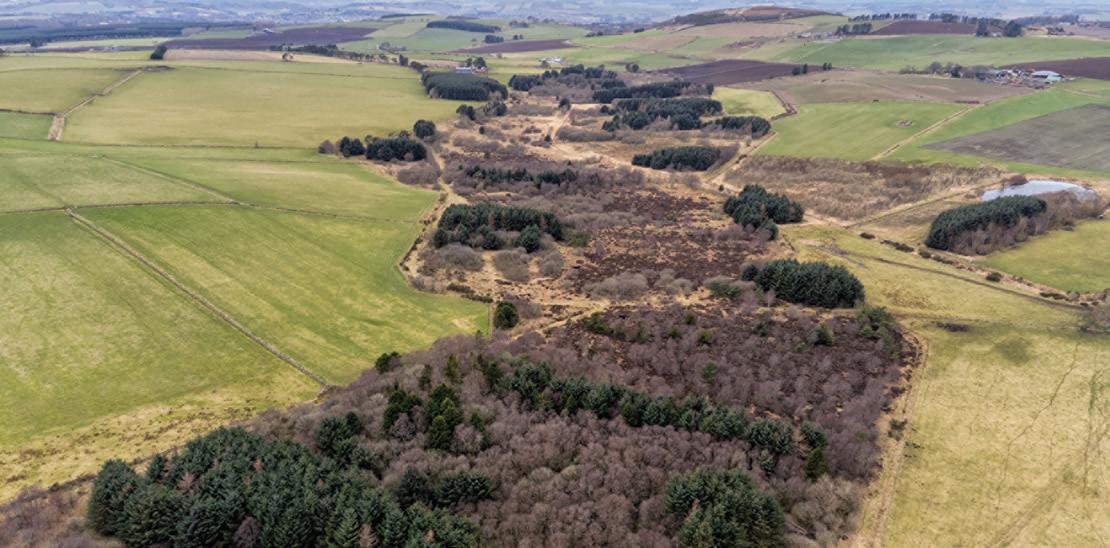
A sizable portion of land has come on the market through leading property consultants Galbraith in rural Aberdeenshire.
The block of bare land extends to some 78.04acres (31.58 hectares) and is suitable for a wide variety of sporting, agricultural, natural capital and amenity purposes.
Burreldale Moss consists of a contiguous block of land classified primarily as Grade 5(3) with areas of Grade 4(2) according to the James Hutton Institute.
Ian Armstrong, handling the sale for Galbraith, said: “The land at Burreldale Moss has historically been managed as a pheasant shoot and therefore benefits from well-connected internal and perimeter tracks. Pheasant pens which are located centrally, and the site has been strategically planted with strips of forestry to maximise the quality of sporting drives. A proportion of the land has historically been cultivated and planted in game crop.
“This is prime land for those with a keen sporting interest in a very convenient location. The pheasant shoot benefits from a range of drives previously operated by a local syndicate. Alternatively, this sale offers an interesting proposition for those keen to extend their current agricultural holding or for interested parties looking to explore natural capital opportunities.”
Burreldale Moss is conveniently situated 3.5 miles north west of Inverurie, 2.5 miles south east of Oldmeldrum and 13.5 miles from Aberdeen. The area is well resourced in terms of sporting, forestry and agricultural infrastructure and the land also benefits from nearby access from the public road network.
Burreldale Moss, Inverurie, Aberdeenshire, is for sale through Galbraith at offers over £235,000.

www.farmingscotlandmagazine.com 81 SHOOTING SCOTLAND
SCOTTISH COUNTRY LIFE
Getting regeneration right
By Jake Swindells
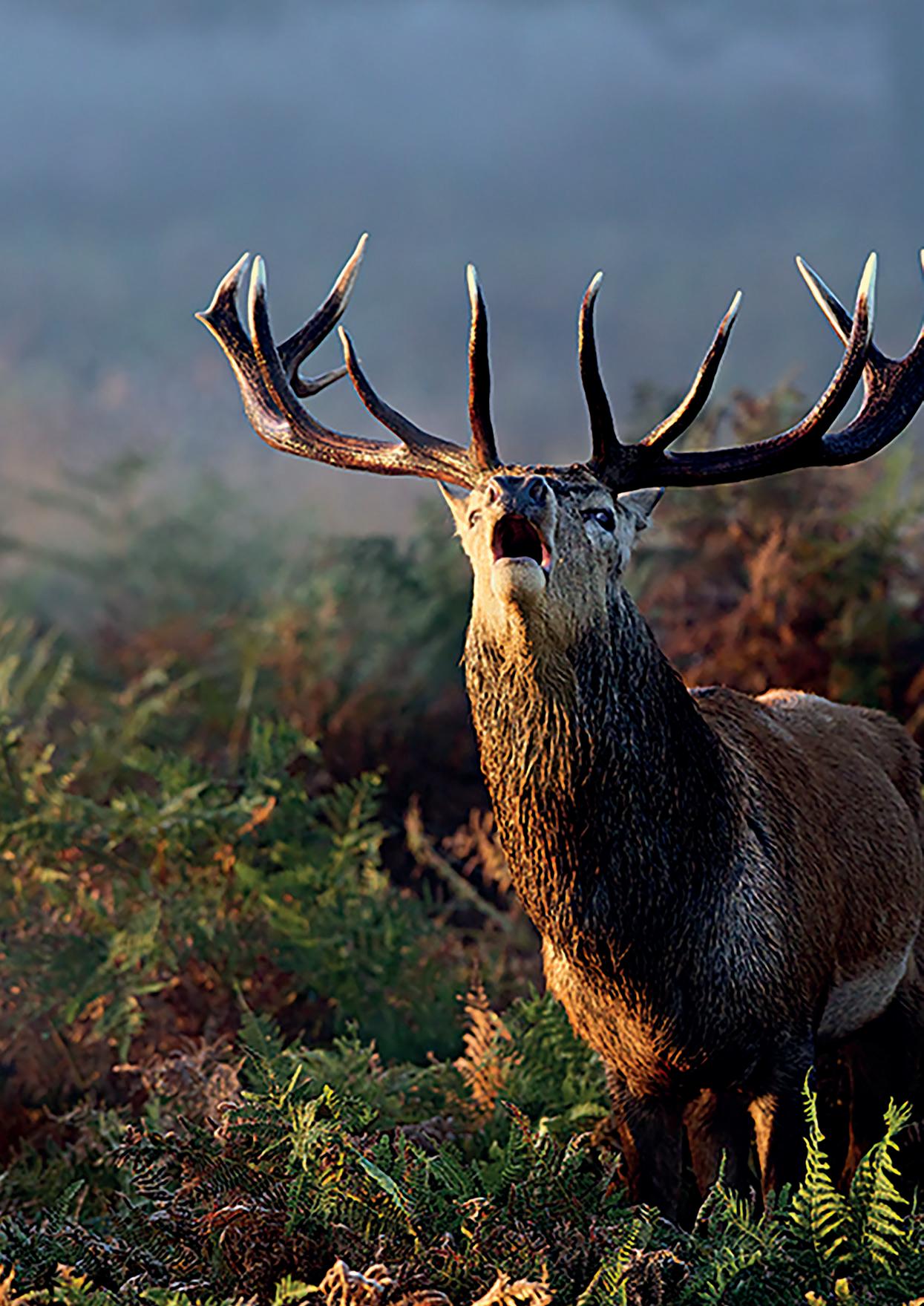
 Jake Swindells
Jake Swindells
Grouse moors are very much a misunderstood entity and are absolutely vital to the survival of certain species in the UK. Whilst there is some debate as to the proportion of heather moorland found in the UK (thought to be around 75% of the world’s total), and much of this is to be found in Scotland, it is safe to say that we have an extremely delicate and precious habitat that is clearly flourishing. It may not be obvious to the casual
observer who drives through the highlands, but if you spend any time with boots on the ground it becomes apparent how abundant and diverse the flora and fauna really is. This is down to the work that gamekeepers and land managers have committed to over hundreds of years. Knowledge passed down through the generations has ensured that Scotland in particular is known for its wild and rugged habitat and
if these land management practices were bad for this habitat, then we would have lost heather moors long ago. A number of drums are regularly beat by those who wish to see a significant change in land management practices. Whilst it is widely accepted that we need to plant more trees in the UK, most grouse moors are not the place to do it. Hillsides where heather may thrive doesn’t automatically mean that other
flora will. Areas of peat and soil are often not suitable for forestation, and access is often an issue. As it stands, quad bike tracks and single pony tracks can be utilised by walkers and mountain bikers to safely access areas that may otherwise seem inaccessible. If these areas were to be forested, then eye sores, such as tarmac or gravel roads would have to be laid to gain access to recover the wood harvest. Thousands
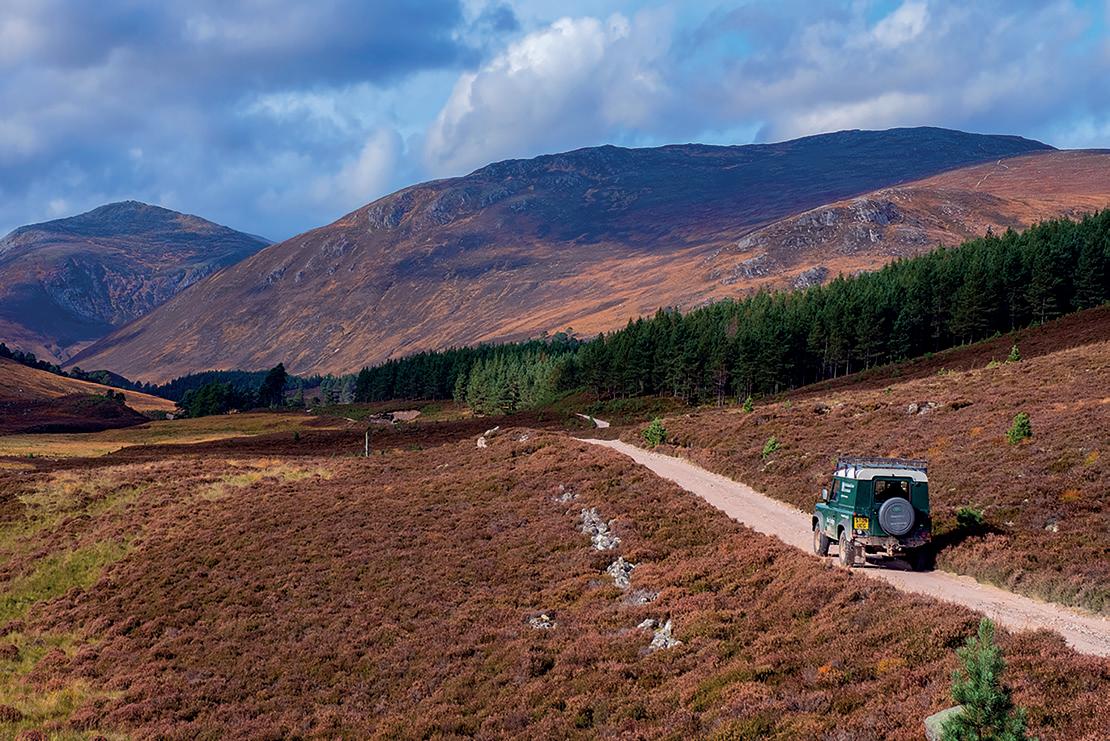
www.farmingscotlandmagazine.com 82
A typical sight
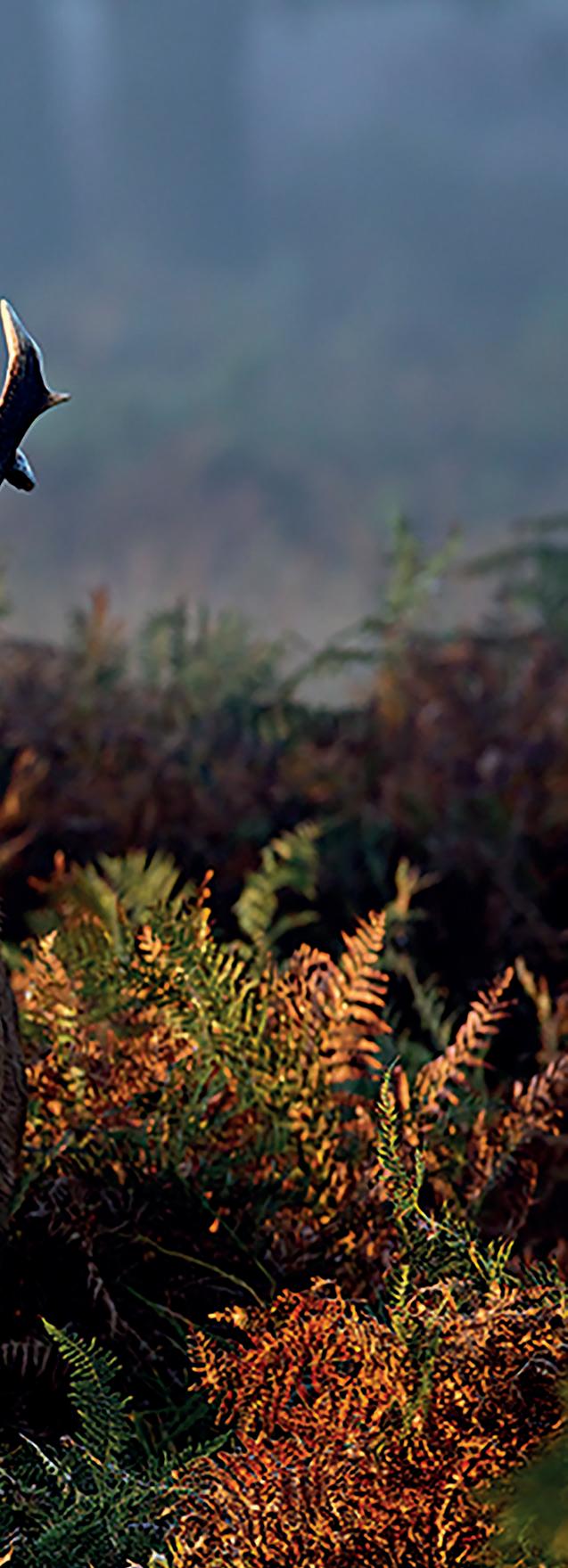
of miles of 2m high deer fencing would have to be installed to protect the trees and yet current practices are criticised for “scarring” the land.
The shooting of grouse is worth a massive 30 million pounds to Scotland’s rural economy every year. This is a vital income in colder months where tourism all but stops and families on lower incomes rely on the part-time work that grouse moors provide through the early winter months. This may not seem like a lot of money for some, but it means that the families living here can heat their homes, feed their children and remain in the area so that schools and shops can stay open.
Managing heather moorland as we do provides both food and shelter for grouse. The burning of heather (muirburn) is conducted by trained professionals, and not only does it remove rank vegetation that offers no benefit to grouse and other moorland nesting species, it also removes thousands of tonnes of natural tinder to reduce the risk of wildfires spreading, as we saw last year at Cannich. If muirburn had been utilised at this site, the fire would have been under control in a fraction of the time. Sadly, many species were wiped out before land managers and local fire crews extinguished the blaze. The enormous scale of this damage could have been avoided.
There is also a misconception that trees will fix the world’s carbon capture problems. In some cases, reforesting would be useful, but it has also been proven during an experiment on Scottish moorland where native trees were planted, that areas of untouched heather captured more carbon over several decades. Reforesting may create a small number of employment opportunities in the short term, but largely these will be national
contracting companies who will use their own staff. When the trees are planted there will be no work for over 3 decades until the forestry companies arrive with their national teams to remove the lumbar. Just one growth cycle could ensure that many more local families leave rural areas because of the lack of regular and predictable work. Further to this, if you plant trees, heather will die out, and so will our Red Grouse, Lapwing and Curlew. We already have a sanctuary for these species and to remove their habitat will only serve to reduce their already faltering numbers.
I once sat through a meeting that simulated the “ideal scenario” when it came to rewilding and regeneration. I was genuinely impressed when a presentation showed how a landscape could look with a bit of consideration, investment and planning. A mosaic of native woods, hill ground, soft woods, wetlands and meadows all in one picture. It looked idyllic. The reality, however, is that this scenario will only be possible in a few areas as most Scottish hillsides will not support such an amalgamation of habitats. As blissful as it seems, it’s just not that straight-forward and the mass planting of trees isn’t going to fix the issues we face.
All over the UK, prime agricultural land is being sold off so that more trees can be planted. For some, it makes financial sense as farming is increasingly under the cosh as we seem now to rely on importing goods as well as paying our farmers the absolute bare minimum for their produce. This land will never be recovered when it is planted, but what other options do farmers and landowners have? I don’t have all the answers, but if governments were to work with farmers, landowners, land managers and organisations, we could, surely, be a lot closer to a solution than we are at present.
Future policy design for Farmers and land managers
By Eleanor Kay, Senior Policy Adviser Agriculture & Climate Change at Scottish Land & Estates
Amid challenges such as biodiversity loss, climate change, and food security, Scottish Land & Estates has long argued for the Scottish Government to articulate its desired balance and outline strategies for delivering a resilient farming sector.
That took a small step forward when First Minister Humza Yousaf made a speech to farmers and announced that from 2027, at least 70% of overall agricultural funding will be allocated to tier 1 and 2 direct payments, with reworked funding for the Less Favoured Area Support Scheme (LFASS) also becoming available from 2027. He also committed to the gradual return of the missing £61 million convergence funding to the Scottish agricultural budget.
The announcements did at least provide a further degree of clarity to the sector - although we’re still at a very early stage in designing a future agricultural policy. The additional commitment of the First Minister to involve the sector in co-design of that policy was very welcome, as was continued support for sustainable livestock production in Scotland.
Climate adaptation is critical to the success of
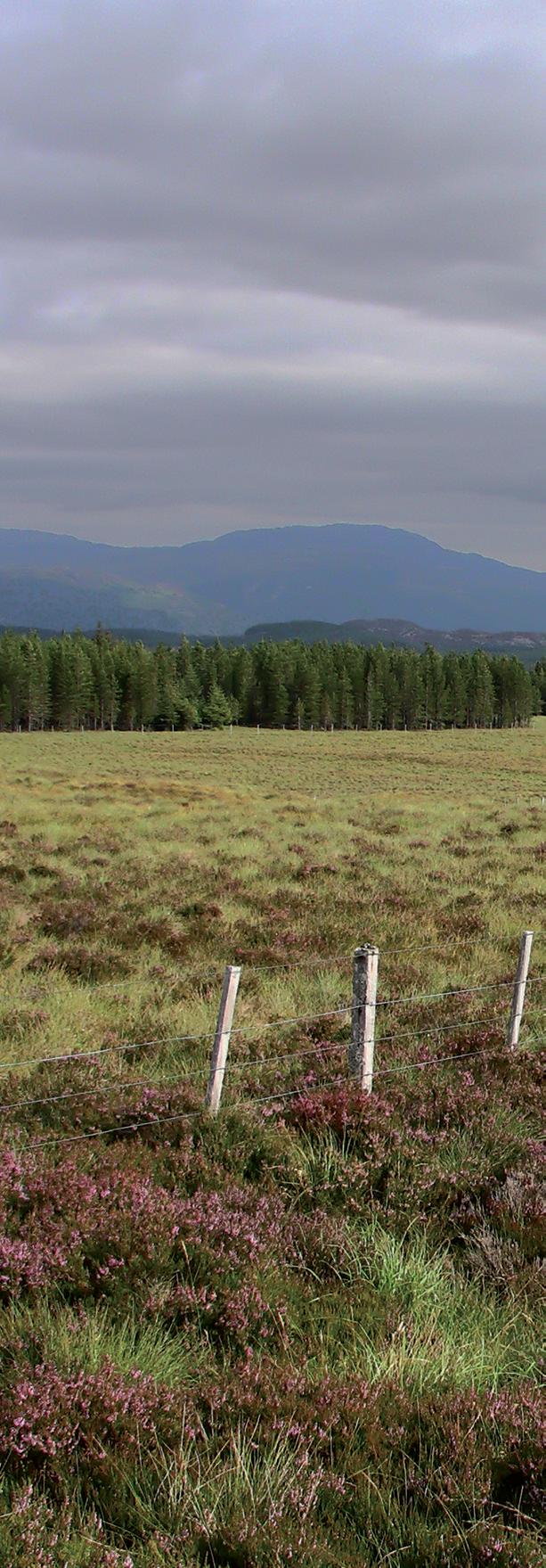
Scottish agriculture and future policy must focus on delivering this activity as a matter of priority. Making sure the whole farm plan element of Tier 1 can deliver a much-needed climate resilience assessment of a farming business –and provides workable recommendations - will ensure that the sector is fit for the future. The outcomes of the whole farm plan must be delivered in such a way that it benefits the decision-making process for the remaining tiers 3 and 4, and an integrated approach to skills development and knowledge exchange is hugely important.
One measure that government can take would be to allow Scottish farmers and land managers who are striving to deliver climate adaptation, mitigation and biodiversity work, to have access to other parts of the Scottish budget - not just through agricultural support. These are national targets and the efforts of farmers and land managers will benefit all of Scotland, not just within the realm of farming. That will be a positive case we will put forward when it comes to future policy design in the months ahead.
For more information www.scottishlandandestates.co.uk Telephone : 0131 653 5400
Turning up the heat with a new thermal spotter
The new Arc series of thermal imaging monoculars has been tested by the Night Master team… and they are impressed! Developed by Pixfra, a big name in security systems abroad, the Arc models are powerful, compact and lightweight; capable of detecting the smallest temperature difference at distances up to 1800m - making them perfect for covert longrange observation. By detecting
body heat and delivering excellent image clarity, the Arc will be useful for deerstalking, pest control and even farming; from checking stock to detecting thieves.
Each Arc device features a highly sensitive thermal sensor and powerful objective lens, offering excellent detection capabilities and presenting a crystal-clear thermal image onto a 1440x1080 display.
Starting at £999, the Arc series consists of six highperformance models. Each thermal monocular comes with two batteries (delivering up to 15 hours of runtime) and includes useful features, such as multiviewer screen sharing.
For more information visit www.nightmaster.co.uk or call the team on 01535 611688.
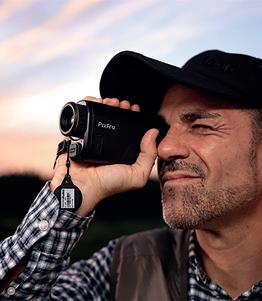
The return of a legend: Rigby unveils the new Shikari rifle
London gunmaker John Rigby & Co. is thrilled to announce the latest, long-awaited addition to its renowned line of sporting guns: the Shikari double rifle. This Best boxlock double rifle embodies the spirit of a bygone era, while exceeding the demands of the modern-day hunter.
The Shikari is a modern interpretation of a classic British double rifle introduced to the Rigby range in the late 1890s, which became a staple for colonial game wardens and Professional Hunters. Its resurgence pays homage to a rich heritage of hunting and opens
the door to experiencing the thrill of an African double rifle safari with a Rigby in-hand.
At the core of the rifle is a robust and durable Anson & Deeley action that marries proven design with modern functionality. Available in .450/400NE, .450NE, .470NE and .500NE calibres, the action and forend iron are both colour case hardened, with blued furniture.
For enquiries, detailed pricing, and further information on the Shikari rifle and Shikari Special Edition, please visit www. johnrigbyandco.com or contact Jérôme Lanoue, Rigby’s head
Aimpoint announces new Acro S-2™ Shotgun Sight
Aimpoint, the originator and worldwide leader in red dot sighting technology, announces the release of the new Aimpoint® Acro S-2™ sight for Shot Show and Industry Day at the range. Designed specifically for use on shotguns with a ventilated rib, the Acro S-2™ greatly enhances hit percentage for small games, bird hunting and on the sporting clays course. The sight provides a compact, low-profile optic for
shotgun hunters and sport shooters.
The integrated carbon fiber reinforced mounting system positions the Acro S-2™ on the lowest possible optical axis without adding unnecessary weight. The optic attaches directly to the ventilated rib and includes eight interchangeable adapter plates to accommodate most standard shotguns. The large 9 MOA red dot simplifies lead visualization, enhancing the

of sales by emailing: jerome@ johnrigbyandco.com
Prices start from: £38,000 excl. VAT.

automatic refinement of muzzle swing and positioning.
The Aimpoint® Acro S-2™ is sleek with no protruding features, providing a clear field of view with both eyes open. The low optical
axis of 15 mm allows for proper mounting of the gun to the cheek.
For more information on the Aimpoint® Acro S-2™ or other Aimpoint products, please visit our webpage at www.aimpoint.com
www.farmingscotlandmagazine.com 84 SHOOTING SCOTLAND
Rigby’s new ‘Bwabwata’ and ‘Luangwa’ knives offer the cutting-edge of craftsmanship
London gunmaker John Rigby & Co. proudly introduces two new knives to the Rigby Shikar Store – the Rigby ‘Bwabwata’ Knife and the Rigby Damascus ‘Luangwa’ Knife. Crafted in the UK by renowned custom knifemakers, Emberleaf, these knives offer the perfect blend of tradition, craftsmanship, and functionality.
Rigby ‘Bwabwata’ Knife
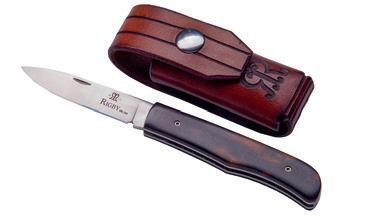
The Rigby ‘Bwabwata’ slip-joint knife features a three-inch blade forged from AEB-L grade steel with a fully hardened mechanism. The handle is crafted from exhibition-grade desert ironwood, delivering both strength and striking aesthetics and comes housed in a leather sheath. The Rigby ‘double R’ logo adorns both the blade and sheath, creating an unmistakable symbol of quality and heritage.
Retail: £699
To shop, visit: tinyurl.com/RSS-Bwabwata
Rigby Damascus ‘Luangwa’ Knife

The Rigby Damascus ‘Luangwa’ Knife features a secure lock-back folding mechanism with a three-inch Damascus steel blade, proudly carrying the iconic Rigby ‘double R’ logo. The fully hardened AEB-L mechanism ensures optimal performance. The handle is crafted from a fine blue maple and it all comes secure in a durable leather sheath, stamped with the Rigby logo.
Retail: £810
To shop, visit: tinyurl.com/RSS-Luangwa
Investing in the Rigby ‘Bwabwata’ and ‘Luangwa’ knives is not just about acquiring exquisite blades, but securing trusty companions for a lifetime of hunting adventures navigating the wild.
Please note that to maintain legal and safety standards, proof of age (18-years-old and over) will be required before shipping these items. The Rigby knives will be delivered via a specialised courier, ensuring secure and timely delivery.
For more information about John Rigby & Co., visit: www. johnrigbyandco.com
www.farmingscotlandmagazine.com

Follow up To Iceland and Hatcheries
By Ian gordon
Back in the UK where anglers have struggled most of the year to find a fish, could this method be used on rivers with, commercially, virtually no fish remaining?
The answer to this will very much be yes. In fact it has already been proved to be successful on both the Tyne and west coast Carron. The latter having a “proven” very successful hatchery programme running for some time now. In fact over the past 10 years, when every other river in Scotland has been in decline, this hatchery river has excelled showing a good increase in fish numbers, the only river in Scotland showing this level of increase. Whilst everyone involved knows the success can only be put down to the hatchery, almost all all our scientific community refused to believe this, putting the increase down to everything but the hatchery. It’s been clear to me for 30 years or more those advising fishery boards and government here in Scotland have failed the sector but not embracing this. When people ask be what is the biggest threat to salmon fishing as a business, my answer is always the same, scientists.
Their self centred interest has help back progress here for the past 30 years. However, due a succession of terrible years culminating in the worse year ever this year, their hand is now being forced and they are being forced to eat humble pie. I’m very hopeful The river Dee, and I’m sure others will soon have proper hatchery programmes in place that will actually make a difference and will help put Scotland back to its rightful place as a leader in the business of salmon fishing. Personally I’d have people with a track record in this business in charge of this. In any business it’s important to hire the right people with appropriate experience. This is no different. Whilst there are many problems associated with salmon it’s so important we don’t lose the
business of salmon fishing because without this this business salmon would lose all political support. This is now necessary here in Scotland, it has been for some time as it will help in the short term. Long term problems associated with salmon cannot and will not be helped by this generation.
So what’s the problems with rolling this out in appropriate places all over Scotland? Well, the main problem and hurdle are the advisors to the Scottish Government. Those people have held back progress in Scotland citing all sorts of reasons why we shouldn’t follow the example set by Iceland, Denmark and a few Scottish Rivers. There’s no doubt when the dust settles with this it will be those advisors who ultimately will be responsible for angling failing and the loss of rural jobs across Scotland.
Personally If I owned any part of a river and had the resources I’ddo what was required and challenge them very publicly in court because their advice is based not on science but hear say and anecdotes. The DNA study currently being carried out by Bob Kindness will prove beyond any doubt that this is in fact what we should be doing all over scotland and that currant resources need to be channeled here rather the dozens of talking shops, all of which have produced nothing for the past 30 years and will continue to do so.
I’ve said it many times before, Scotland is in a unique position with regard sport fishing for all sorts of species including Salmon and Sea Trout but it has been failed on a grand scale by those supposedly looking after it.
The sector is currently worth 80m annually and supports 2500 rural jobs. It’s contribution to the GDP of this country could and should be increased by at least 3 fold if managed properly.
www.speyonline.com
SHOOTING SCOTLAND
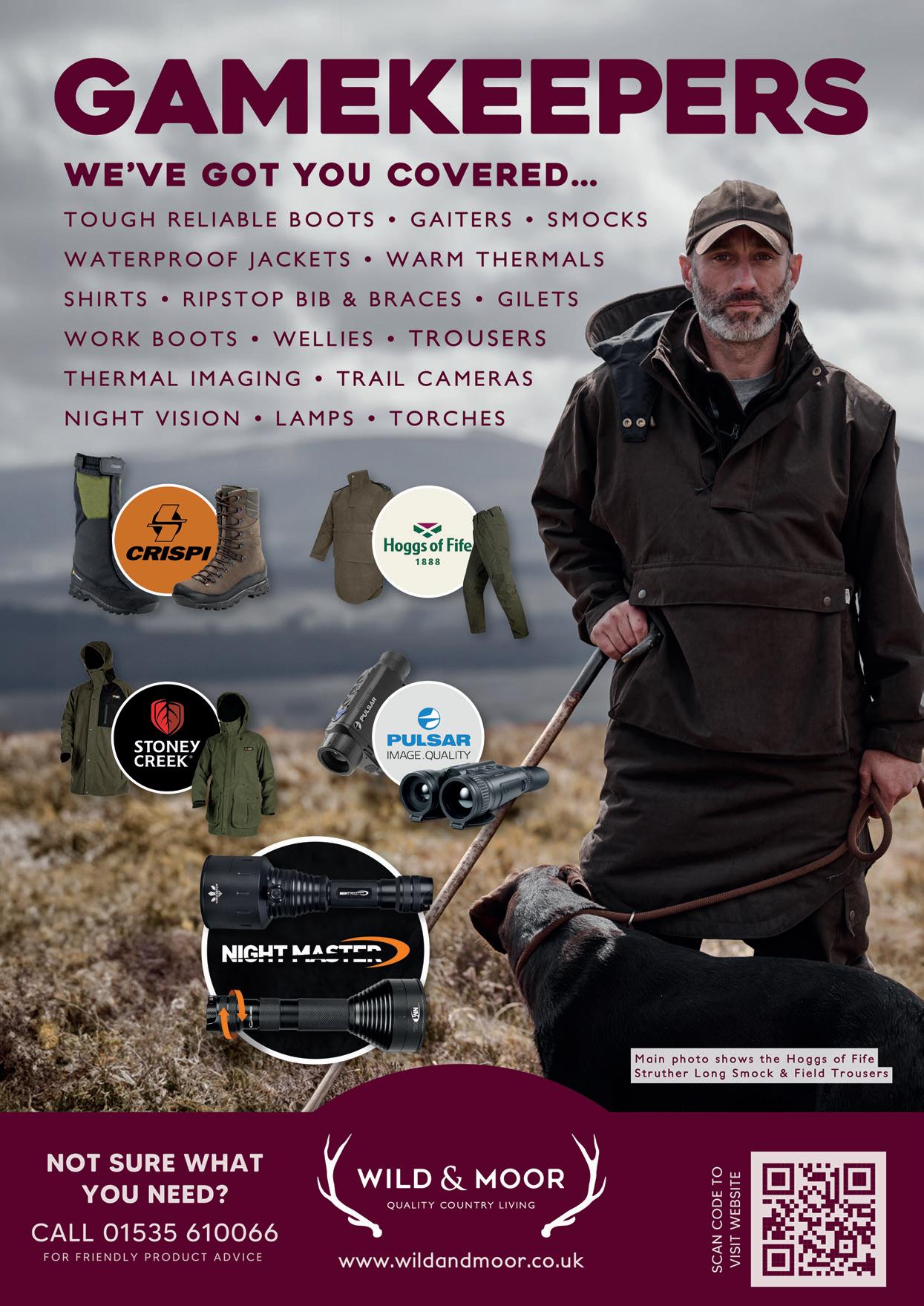
The Flexible Solution to Farm Accounts
As the new financial year for the majority of businesses commences in April, now is a very good time to assess if your bookkeeping solution is working properly for you, not just for your accountant.
SUM-IT’s TOTAL2 Farm Accounts software satisfies both parties. You get a straightforward, jargon-free program to make it simple to do your VAT and keep you in touch anytime as to the profitability of each of your farm’s enterprises, and your accountant gets a free Auditor version of the software to access your records easily to prepare your Year-End accounts.
SUM-IT’s TOTAL2 Farm Accounts is very flexible in how it can be run, either locally on your PC/Laptop or in the Cloud should you need multiple people to access it in real-time.
There are two main levels to the software. Users can choose the Starter level for purely Cashbook accounts or those
wanting a full accounting system can opt for the Standard level. Either way, because it’s designed for farmers, it handles all the idiosyncrasies of farm accounts such as self-billing invoices easily, unlike mainstream accounts software.
What also is critical is knowing that you’ve got easy access to phone support for help from our friendly Support team who know both farming and accounts. With open hours from 8am to 8pm, Monday to Friday and 10am to 4pm on Saturdays, you can talk to them when everyone else has gone home.
To book an online demonstration of the software, go to www.sumit.co.uk today.
Slurry & water storage grant
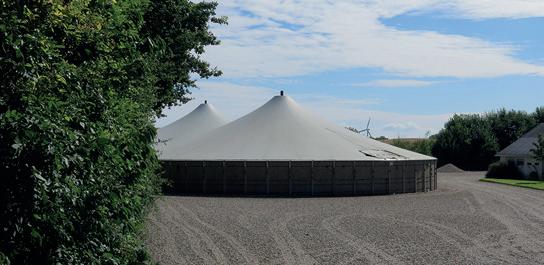
Around 60 Scottish farms applied for slurry storage funding in the 2023 funding round
Scottish farmers upgrading slurry storage to meet new requirements or building irrigation lagoons are being urged to apply before 19 April deadline.
The latest funding round has opened for farmers in Scotland hoping to erect or upgrade their slurry storage to meet new regulations.
It also includes support for irrigation lagoons, a new measure that the industry has been calling for given recent water shortages in some areas.
Scottish government confirmed that the funding for slurry storage and irrigation lagoons, delivered through the AgriEnvironment Climate Scheme (AECS), will consist of £4m worth available.


www.farmingscotlandmagazine.com 87 finance

Extensive area of land for sale where Robert the Bruce’s army disposed of their weapons after their defeat at the battle of dalrigh
Lying within the Loch Lomond and Trossachs National Park, Auchreoch is an extensive area of land including a Site of Special Scientific Interest (SSSI) and a Special Area of Conservation (SAC), for sale through Galbraith.
Auchreoch offers a superb natural capital and amenity opportunity as well as sporting potential.
In the northern section of Auchreoch, close to the River Fillan, lies ‘Lochan nan Arm’ which translates to ‘Lochan of the Weapons’, and this lochan is said to be where Robert the Bruce’s army hastily disposed of their weapons as they retreated after their defeat at the Battle of Dalrigh. This battle was fought in 1306 against Clan MacDougall of Argyll, who were allies of Clan Comyn and the English.
Auchreoch comprises a block of hill land extending to approximately 1520.31 acres (615.26 hectares) in total and is situated approximately 2.7 miles to the north-west of the village of Crianlarich, Perthshire in central Scotland.
The majority of the of the land has been classified as Grade 6.3 agricultural land, with pockets of Grade 5.2 and Grade 6.2 dispersed across the property. The property rises from approximately 170 metres to 650 metres above sea level at its highest point with a mostly northern aspect.

Iain Paterson, handling the sale for Galbraith, said: “The sale of Auchreoch offers a fantastic opportunity for interested parties to own a slice of Scotland in one of the country’s finest scenic settings within the Loch Lomond and Trossachs National Park.
“The woodland at Auchreoch, together with the extensive hill ground, offers a superb position and great opportunity for potential enhancement and diversification projects with a Natural Capital focus. Be it woodland creation, eco-tourism related enterprises, re-wilding, conservation and
bio-diversity enhancement orientated projects or such similar focused interests, all subject to obtaining the required permissions. Auchreoch also offers the potential for sporting interests, with the possibility of Red, Roe and grouse shooting.”
There are two parcels of woodland which comprise productive planting and native regeneration. The parcel of more productive woodland lies in the centre of the property and extends to approximately 80 acres (33 hectares) and consists of semi mature woodland planted. There is also the potential for woodland
development with Grade F4, F5 and F6 on the hill slopes, indicating that it will support tree crops with a moderate flexibility for growth.
In the west of the property is a beautiful area of naturally regenerated native pine forest, Coille Coire Chuilc, which has been classified as a (SSSI). This area extends to approximately 320 acres (129 hectares) and within this forest is a tributary to the River Tay which is a Special Area of Conservation (SAC).
Auchreoch benefits from a useful agricultural shed near the public road with a single in-bye
www.farmingscotlandmagazine.com 88
estate
paddock which has been used for sheep handling. This building would offer the opportunity for future development opportunities, subject to relevant permission.
Auchreoch, Tyndrum, Crianlarich is for sale through Galbraith at offers over £2,000,000 as a whole or in two lots as follows:
• Lot 1 – offers over – £1,950,000 – Land at Auchreoch comprising approximately 614.79 hectares (1519.15 acres)
• Lot 2 – offers over £50,000 – Barn and paddock at Auchreoch comprising the timber framed sheep shed and the in-bye park, extending to 0.47 hectares (1.16 acres)
FARMING SCOTLAND MAGAZINE
Subscription page 36

SLE welcomes agriculture policy co-design commitment from the First Minister
The views of all farmers and land managers in co-designing future agricultural policy must be taken into account for it to be a long-term success, Scottish Land & Estates said today.
The rural business organisation commented after several key commitments were made by First Minister Humza Yousaf in a speech at the NFU Scotland conference today.
The Scottish Government said it was to gradually return the missing £61million convergence funding to the Scottish agricultural budget. On future funding, the First Minister announced that from 2027,


estate www.farmingscotlandmagazine.com 89
Eleanor Kay, Senior Policy Adviser – Agriculture & Climate Change at Scottish Land & Estates

at least 70% of overall agricultural funding will be for tier 1 and 2 direct payments. The Less Favoured Area Support Scheme (LFASS) funding will also be reworked and be available from 2027.
Eleanor Kay, Senior Policy Adviser – Agriculture & Climate Change at Scottish Land & Estates, said:
“The First Minister has set out the allocation of future funding and this will increase the sector’s confidence to some degree. However, we have repeatedly made the case for impact assessments and modelling data to be produced by government
to explain the rationale for such changes and examine how changes to funding will have an effect. We still need to see this produced.
“Considering the challenges of biodiversity, climate change and food security, the Scottish Government must be clear on what balance it is seeking to achieve and how it will deliver a resilient farming sector. We welcome the announcement that the government will continue to support high-quality livestock production – as long as it is sustainable production, we know it can form a key part of ecosystems and habitat restoration.
“We would also like to see Scottish farmers and land managers who are striving to deliver climate adaptation, mitigation and biodiversity work have access to other parts of the Scottish budget, not just through agricultural support. These are national targets and the efforts of farmers and land managers will benefit all of Scotland, not just within the realm of farming.”
SLE added that improved communication with the sector remained key in the years ahead.
Eleanor added: “As we have said throughout this process,
communication with all farmers and land managers is what is required to strike an achievable balance between food production, nature restoration and climate mitigation.
“We are pleased that the First Minister has committed to co-design and we hope the government remains true to its word on this. This includes clearer communication and open dialogue on difficult issues. This work cannot simply be left to a narrow grouping such as the Agriculture Reform Implementation Oversight Board (ARIOB).”
New-look board announced to help drive land reform Michael Russell joins the Scottish Land Commission as Chair
The Scottish Government has announced the appointment of a new Chair and two new members to the Board of the Scottish Land Commission.
Michael Russell will join the Land Commission as its new Chair, replacing the outgoing Andrew Thin, while Dr Craig Mackenzie and Professor Deb Roberts have been appointed as Commissioners.
Incoming Chair, Michael Russell, served as a Scottish Government Minister and Member of the Scottish Parliament at various times between 1999 and 2021. He most recently worked as SNP president and has had long-term involvement in the topic of land reform, having been Environment Minister from 2007 to 2009.
The incoming Chair said: “I am honoured and excited to be appointed as Chair of the Scottish Land Commission after an independently scrutinised competitive recruitment process.
“Land is a vital resource for every citizen of our country and how we share it, care for it, and use it is a key issue at the heart of Scotland’s continuing story.

“I am strongly committed to a process of land reform which ensures that all communities benefit from this national asset and that it contributes to our sustainable well-being as a vital
part of the process of building a fair and equitable Scotland.”
Michael was a member of the Scottish Parliament Committee which scrutinised the Land Reform Bill in 2015, and an
MSP for the South of Scotland Region for two terms before being elected in 2011 to serve the constituency of Argyll and Bute. Michael retired from representational politics in 2021
estate www.farmingscotlandmagazine.com 90

but remained SNP President until 2023. He is the author of seven books and has worked as a columnist and commentator as well as a television producer and director and founded the Celtic Music Festival. Michael also was a part-time Professor in Scottish Culture and Governance at the University of Glasgow and is the trustee of several charities.
He added: “The first Chair and Commissioners, appointed as a result of the 2016 Act, have done a superb job and created a huge resource in terms of research and positive practice and helped to develop a strong staffing base with an enviable reputation for openness and fair dealing.“Andrew Thin has led the organisation with dedication and enthusiasm and I am very aware of the legacy to which I and the new Commissioners will have to live up as they learn from those still in office.”
Andrew Thin was appointed as the first Chair of the Scottish Land Commission in 2016 and has led the organisation through its establishment as a new public body and since. Andrew’s leadership has brought challenge and openness to the Commission’s approach, developing clear recommendations for changes in law and policy as well as a strong focus on culture change in responsible land ownership.
Michael Russell is joined by Dr Craig Mackenzie and Prof Deb Roberts who have been appointed as Commissioners, replacing the outgoing Megan MacInnes and Professor David Adams.
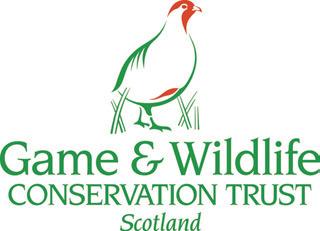
Blending productive farming with biodiversity stewardshipthe PepsiCo FAB project aims high in first year
By Fiona Torrance, Farmland Biodiversity Advisor, Game & Wildlife Conservation Trust

The GWCT-managed FAB project, supported by Pepsico and with key input from NatureScot and Scottish Agronomy, aims to demonstrate how productive agriculture does not need to suffer whilst accommodating biodiversity. The project builds on the EU Interreg PARTRIDGE project (20162023) and aims to scale up its approach. The project base at Balgonie Estate, Fife hosts several events throughout the year, with the project also helping five other pilot farms to prepare for the next round of agrienvironment schemes looming in 2025.
The Draft Agricultural Reform Programme coincided with the start of the project in February 2023 and we were delighted to discover that certain types of wild bird seed mix could now be established for two to three years, rather than just the one year available to farmers under the current AECS scheme. Although this was a direct
result of the work of the previous PARTRIDGE project, this was good news for FAB too in that other farmers can receive funding for one of the measures we feature, and that there are improved options for biodiversity.
One of the components of the project is communication and, in particular, peer-topeer learning for farmers and other project members. On 19 June we held our first farm walk for participants at Balgonie - a great opportunity to talk through some of the habitat measures established there and options to create different habitats. We also discussed what was wanted from a future AE scheme, and had a first look at the ‘hedge scorecard’.
Influencing policymakers is another aim and we met Lorna Slater, Minister for Circular Economy, Green Skills and Biodiversity at the Royal Highland Show. We showed her a video of our achievements at Balgonie, discussed farmer clusters,
and informed her about possibilities for private finance, such as the PepsiCo FAB initiative.
We attended several other events throughout the summer including the GWCT Scottish Game Fair and have welcomed visitors to Balgonie including members of Scottish Government’s agriculture department and from St Andrews University.
We have also spent time testing NatureScot’s scorecards that will be used in a future scheme. This involves taking participating farmers through the hedge and arable field scorecards and getting feedback on this app-based programme.
2023 was a great first year for the project with Balgonie also being shortlisted for the RSPB Nature of Scotland Awards in the Food and Farming category. Although we didn’t win, it was significant that our work was recognised in this way and it has certainly motivated our project team for the future.
www.gwct.org.uk/auchnerran/
estate
Photo: Eric Anderson
Farmer farm walk
FARMING SCOTLAND MAGAZINE Next issue out May 2024 Subscription page 36

Keep up the momentum on tree planting this year
Woodland owners, forestry companies, farmers and other landowners are being encouraged to keep up the momentum for this year’s tree planting season.
The more trees that landowners can get into the ground will all count towards this year’s new woodland targets, which get published in June.
The call to keep up the momentum comes as Scottish Forestry shares a summary of the main discussion points from last December’s forestry summit, which saw around 80 representatives from the rural and forestry sectors attending.
At the summit, a record number of 13,111 ha worth of woodland creation scheme approvals were announced. New figures reveal that Scottish Forestry has now approved 13,823 ha.
The December forestry summit undertook a number of workshops to explore barriers and opportunities to delivering increased woodland creation.
Some common themes raised included:
• The need for a more streamlined woodland creation process, guidance on further information to support applications and criteria for applications being returned for further work;
Climate, community, forestry and farming at the heart of Scotland’s Finest Woods 2024
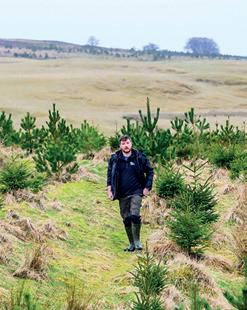
• Clarity on time frames for all parties involved in the application process;
• Clearer and fewer policy priorities and improved vision for future forests;
• Using a wider range of woodland and silvicultural models to create resilient forests;
• Better policy integration between forestry and farming
• More joint working and public/private training across the sector and better communication across all parts of the industry;
• Managing deer numbers to lower levels, targeted intervention and political leadership to use powers that exist to support landscape-scale control.
The summary note detailing the key points raised at the Woodland Creation Summit is available on the Scottish Forestry website.
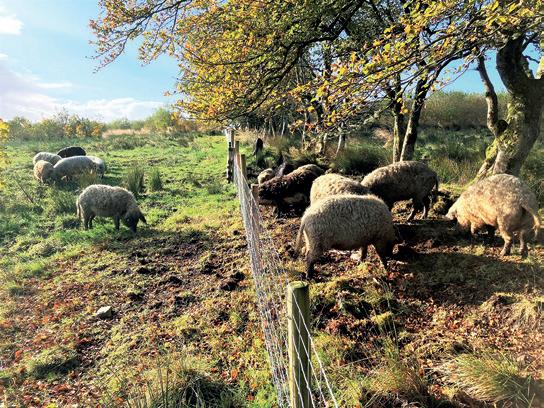
Scotland’s Finest Woods Awards are back for 2024 after a wonderful celebration in 2023. And this year four key areas form the focus of the prestigious Scotland’s Finest Woods Awards – climate, community, forestry and farming.
The environment is central to everything the awards are about and the competition for the Climate Change Champion Trophy promises a strong field.
Last year The Future Forest Company for Dumyat, near Stirling, took the prize with a “multi-use forest for the future”, which saw great examples of carbon sequestration, enhancing biodiversity and providing for communities.
Jean Nairn, Executive Director of Scotland’s Finest Woods, said: “Forestry and agriculture play a vital role in the rural economy of Scotland and we are proud to celebrate that in our awards. But they are also an important player in the nation’s attempts to move to net zero and tackle climate change – helping the environment not only in reducing CO2 but also reducing the risk of flooding and protecting vital peatland
habitats, as well as helping agriculture thrive.
“Last year it was great to see lots of community involvement, from both young and old, in the awards and we are expecting for the same again in 2024. It is vital the fight against climate change involves all sectors of society so everyone can help mitigate, educate and adapt to the challenges we face in Scotland and across the globe.
“Across Scotland we know there are inspirational people who are making a difference through their commitment to the woodlands they own, manage and volunteer in. This is the chance to celebrate them.”
The great work of communities was highlighted last year by the winners of the Tim Stead Trophy for the overall Community Woodland Award – Friends of Almondell & Calderwood with West Lothian Council for Almondell Woods.
The winner of the Woodland Trust Scotland Trophy for New Native Woods was Martyn’s Wood, Crannich, Isle of Mull – which created an area of biodiversity on inhospitable ground and was planted in the
www.farmingscotlandmagazine.com
www.farmingscotlandmagazine.com forestry 86
memory of the nephew of owner Robin Sedgwick.
Meanwhile, Fordyce Primary School near Portsoy in Aberdeenshire took home the Crown Estate Scotland Schools’ Trophy.
And the winner of the Scottish Forestry Early Years’ Trophy was Bushcraft Bairns at Comrie Croft, Perthshire who created a Forest School setting that nurtures connection with nature through play.
Forestry and farming form a bedrock for the awards with vital work in integrating trees into the Scottish landscape, to benefit wood production and agriculture, as well as the environment. This year we are excited to announce a new sponsor for one of the 11 competitions – the Farm Woodland Award Whole Farm / Croft, which comes with the magnificent Lilburn Trophy for an active farmer/crofter anywhere in Scotland, will be sponsored by Fountains Forestry UK Ltd. Without sponsors and supporters there would be no annual awards and the organisers are grateful for the new and continued support.
A brilliant example of agroforestry using pigs won David Carruth the Scottish Woodlands Farm Woodland Trophy for Young People in 2023 for his work at Brodoclea, Dalry, North Ayrshire for The Future Forest Company.
And the icing on the cake for the Quality Timber Awards was the highly coveted Dulverton Flagon, an occasional award given at the judges’ discretion for a successful balance between commercial forestry and competing objectives. It was given to Ardachuple, in a National Scenic Area at the Kyles of Bute, Cowal – owned by Bamberg Ltd and managed by Tilhill.
The Scottish Government continues to support ambitious
tree planting targets and organisers are hoping for another exceptional set of winners in 2024.
Last year, Mairi Gougeon MSP, Cabinet Secretary for Rural Affairs, Land Reform & Islands, presented the awards. She said: “The awards are a great opportunity to showcase Scotland’s woodlands and the very people who work tirelessly to manage and care for them.
“There’s a great variety of awards involving best practice in farm woodlands, climate change, community involvement, right through to schools and native woodlands.
“I would certainly welcome and encourage all those to enter the awards and help make the 2024 event another big success.”
The full list of awards are open to anyone with a highquality project, whether that be a school or pre-school nursery, a forestry business – small or large, an expert forester, farmer or crofter, and a community woodland.
Guy Watt, Chair of Scotland’s Finest Woods, the charity which operates the programme, said: “It was a pleasure to once again be at the Royal Highland Show to celebrate some wonderful work being done across Scotland. This year is already looking set to be a great success.
“It is important we celebrate and champion the environment as well as the community and commercial work which contributes to a wonderful diversity of woodlands in our country.
“Praise should also go to the judges, whose knowledge and guidance are vital to producing an awards programme that is of the highest excellence. We should also thank entrants for taking the time and effort to take part in what is a fantastic celebration of trees, woodland and forestry in all its forms.”

Selecting beef bulls for use on dairy
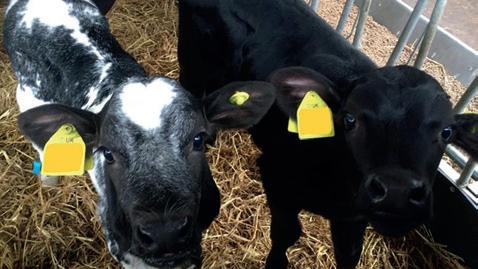
Sales of sexed dairy semen are increasing year-on-year and were reported by AHDB to be 76.5% of all dairy semen sales in 2022/23. As a result, not all pregnancies are needed to produce dairy replacements and there is an increase in the number of dairy-beef cross calves being produced which offer higher economic value than dairy male calves.
There is a growing interest in how to maximise the value of this dairy-beef cross calf further by using male sexed beef semen to produce a male beef cross calf which, in general, will attract a higher price than a heifer beef cross calf.
beef breed calves (e.g. Aberdeen Angus X) and a reduction in continental ones (e.g. Limousin X). Much of these trends result from an increase in the uptake of integrated calf supply chains where breed of beef sire is stipulated. Also, native breeds are popular amongst retailers. Which sire to use within a breed also needs careful consideration. The major breeding organisations have developed indexes which take factors such as calving ease, gestation length and calf quality into consideration.
Entries must be submitted by 23:59 on Sunday March 31, 2024.
For full details, criteria and entry forms see: www.sfwa.co.uk
www.farmingscotlandmagazine.com
At auction over the last few months, British Blue cross calves tended to command the highest prices. Data from AHDB on calf registrations has highlighted a growth in the number of British Blue cross calves being born. It also shows an increase in the number of native
Many of the dairy-beef cross calves leave the dairy farm of birth within the first few weeks of life and are reared on another farm. If these calves are going to a regular buyer (not as part of an integrated supply chain), then it is worth asking how your calves have performed in their system and look at the genetics of those that have performed well.
forestry 85
Destination Dunfermline
Dunfermline’s farming story starts when you wake up in the 200 year old Garvock House Hotel, formerly famous as Transy House, an estate renowned for its Shetland Pony Stud Farm. The award winning Transy stud was founded in 1896 by William Mungall, who also housed ponies at Lochend, a small farm three miles north of Dunfermline.
The hotel shares the story that the first breeding ponies were purchased in 1897, building up to around forty ponies by 1908. From 1909 to 1914, many
By Janice Hopper
championships at the Highland Show were won by ponies from the stud, including Silverton, Silver Queen, Selwood and Sovereign.
Transy bloodlines continued to lift trophies till the outbreak of World War Two when rural events were paused and the farm at Lochend was requisitioned for the army, but the Shetland pony expertise ran in the family into the 21st century. While William Mungall was awarded presidency of the Shetland Pony Stud Book Society in 19061907, his son-in-law William

Dick was honoured with the role from 1959-1961, and Mungall’s grandson, Dougal Dick, held the coveted position from 19691971 and again from 2000-2001.
Garvock House transformed into a homely yet grand hotel in 1996 when it was opened by the current owners, Pamela and Rui Fernandes. The couple hasn’t forgotten the estate’s agricultural history: the restaurant and function suites are named after the award-winning stud, including Dunsmuir, Transy, Harviestoun and Rosemalen.
From Garvock House, visitors often head to the city’s renowned abbey. It’s famous as the birthplace and burial site of kings, from the arrival of Charles I to the resting place of Robert the Bruce. The land is also on a key pilgrim’s route, with the devout paying their respects at the shrine of St Margaret who established a community of monks here and reigned over Scotland with her husband King Malcolm III in the 11th century.
A more agricultural link at the abbey is its gatehouse that once housed Dunfermline’s first damask weaving loom, set up by James Blake in 1718. The linen industry supported the town for the next 200 years, plus the flax farmers who contributed to it. The area’s weaving story is
explored in more detail within the city’s Library and Galleries, which house a great Jacquard loom built around 1835. Display boards state that the trade dates back to 1491 in Dunfermline. At its peak Dunfermline linen could be found in great houses across Australia, Canada and America, and the luxury materials graced Cunard cruise liners. Silk from Dunfermline even featured in Queen Elizabeth’s wedding dress of 1947.
Over time great names have derived from Dunfermline’s linen heritage. Sculptor Amelia Robertson Hill was the daughter of a Dunfermline damask designer. Her brother was the artist Joseph Noel Paton, known for his detailed work featuring myths, legends and biblical scenes. But the most famous weaving child started out in notably humble beginnings before rising to become the world’s richest man. It’s the inimitable Andrew Carnegie. Today it’s possible to visit the modest cottage on Moodie Street where he was born in 1835. On the ground floor is housed a Jacquard loom similar to the one worked by the Carnegie’s. The original was sold to fund their passage to America. The cottage is part of the Andrew Carnegie Birthplace Museum,

www.farmingscotlandmagazine.com 94
Travel Scotland
Pamela & Rui Fernandes, Garvock House Hotel proprietors
A room at Garvock House Hotel
which is free to visit and full of fascinating facts about this remarkable industrialist and philanthropist.
With his wealth Carnegie went on to gift several stained glass window’s to the city’s abbey. While most church windows depict biblical scenes or figures, Carnegie’s Tiffany window, created by the globally celebrated Tiffany Studios in New York in 1912, is a celebration of nature, transporting viewers to a rural idyll. It’s said that Carnegie suggested that Scottish thistles could be incorporated into the design, but as the New York based artists weren’t familiar with Scottish plants, rhododendrons became the blossom of choice. Nevertheless, to showcase scenery such as hills, flowing water and flowers in bloom is relatively unusual — to the extent that in August 1913 the window was rejected as out of harmony with the
existing stained-glass windows by a surveyor from the Royal Commission on the Historical Monuments, and thus lay in storage until 1937. This exquisite wild scene was only displayed within the church in 2019, and for those with a connection to the land it’s a particular calming and beautiful piece of work.
Ultimately one of the greatest gifts Carnegie bought the people of Dunfermline was land itself. Pittencrieff Park (or ‘The Glen’ as it’s locally known) was part of a private estate until the millionaire bought this vast green space for the community to enjoy, presenting it to the people in 1903. Carnegie knew that working people benefited from opportunity and investment in their lives; this included the chance to relax and exercise in the great outdoors amid greenery. The animals of the park are quite surprising too. For any farmer seeking an escape



Travel Scotland
from agricultural livestock, Pittencrieff Park boasts possibly the most exotic offering of any Scottish city. Peacocks call the park home, having been introduced to Dunfermline from India in 1905 by local philanthropist Henry Beveridge. The fowl wander as they wish, and were even granted Freedom of the City in December 2023. The birds shelter within the park’s Peacock Sanctuary, run by volunteers and open to visitors at the weekend between 11.00am3.00pm.
A few final Dunfermline recommendations include dropping by the city’s oldest building, Abbot House. A gift shop inside stocks local
producers such as wool creatives, Scarlet Knitwear. For a taste of local produce place an order with Urquhart’s Farm who specialise in Highland beef and Scottish lamb. After all the free attractions available to visit in Dunfermline visitors may well have travel money left to shop local!
Garvock House Hotel - garvock. co.uk
Dunfermline Abbeyhistoricenvironment.scot/visit-aplace/places/dunfermline-abbeyand-palace
Andrew Carnegie Birthplace Museum - carnegiebirthplace.com
Pittencrieff Peacock Sanctuarypeacocksinpittencrieffpark.com

95
www.farmingscotlandmagazine.com
Robert the Bruce, Dunfermline Abbey
Andrew Carnegie birthplace museum
Pittencrieff Park Glasshouses
Exploring Dunfermline’s textile history at the Carnegie Library, Museum & Gallery
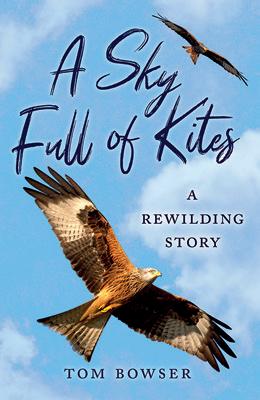
In the hills above the farm, the wild lands where the whin bushes sprawl and the wind is always a gale, where the lapwing wanders and the curlew calls, the remains of a wooden shelter can be found. It collapsed a few years ago. One
Opportunities
day it was standing, the next it was down, a little bit of history rotting into the ground. This was our original hide, where visitors first came to watch the kites.
One night, soon after I’d begun my squirrel hunt, with

Rowan asleep upstairs, Mum and Sarah both out, Dad and I lit a fire, poured a dram and reminisced about those days.
By the early 2000s we had a few pairs nesting on the farm and a growing number roosting here through the winter.
‘There was a real opportunity,’ Dad told me. ‘I knew it must be possible to entice the kites down for food. When they first arrived on the farm, the RSPB used to come up and put meat out for them. Because the birds had been taken from the nest they had nobody to show them how to feed, like the parents would do in their first month in the wild. As the red kite officer, it was lorcan o’Toole’s job to replicate that.’
There were precedents for feeding adult birds, too. At Gigrin Farm, near Rhayader in mid-Wales, a feeding station had been established in 1992. For over a century, conservationists had been working to protect the last Welsh kites, distributing instructions for their preservation to gamekeepers, paying landowners to keep nests safe from egg collectors and persecutors, even tasking the British armed forces to guard nest trees. Now, thanks to this and to the supplementary feeding at Gigrin, the kite population was rising. A feeding station in Central Scotland might benefit the kites every bit as much as the Welsh one had.
Dad continued: ‘When he took over from lorcan, Kevin Duffy tried feeding over on Doune lodge and found that some kites would come down. He felt that Argaty would be a better site for it, though, and gave Mum and me a presentation about Gigrin one night. We went down to Wales to see it for ourselves and it really opened our eyes to the possibilities.’
‘Weren’t you nervous about bringing all of those people onto the farm?’ I asked.
‘A little,’ he said. ‘Maybe Mum was a bit more hesitant than I was. There’s always that fear that you get overrun, that the place turns into a zoo. But people were coming anyway, so it was better to try and accommodate them.’
‘And you knew it could be done? That you could feed the birds.’ ‘Absolutely.’
‘And how did you get on when you first started? Did they take to it straight away?’
A smile flashed across Dad’s face. ‘It was a fucking disaster.’
Through a contact at the Farmers’ Market in Stirling, my parents acquired a vanload of breasted pheasants. one day Dad disappeared off into the hills above the farm and threw a few out where he’d last seen kites hovering.
‘Absolute disaster,’ he repeated. ‘The kites – these bloody big birds that were supposed to come and take
www.farmingscotlandmagazine.com 96 BOOK SERIALISATION
A red squirrel on the prowl for food.
everyone’s lambs, hens and pheasants – just looked at the meat. I tried a few different spots, but the result was the same. Their beaks and talons weren’t strong enough to rip into food of that size. The only time they ever came down was when a buzzard had been in and torn it to shreds.’
Dad’s early attempts, trailing off across the hill with a stinking bag of halfchopped birds, wondering why the kites wouldn’t come for such a delightful treat, seems hilariously hapless. But there’s a serious side to the tale, too.
Red kites have been persecuted for centuries because people see them as voracious, greedy birds. As a society Britain has had a difficult relationship with both scavengers and predators. (It is interesting, at the very least, that the alternative definition of ‘predator’ in the Oxford Dictionary is ‘a person who ruthlessly exploits others’.) We’ve tended to sensationalise these animals, make them bigger, stronger and more capable than they are.
Kites are scavengers by nature, and the reality of their behaviour – that they will feed on any dead meat they can find –may explain some of our hostility towards them. (even now, in our apparently enlightened age, vultures in Europe are sometimes viewed with disgust because they feed on meat in oft-advanced stages of decay.) Centuries ago, when dead animals littered city streets and
battles between neighbouring nations were commonplace, one can only imagine how much carrion was to be found.
An interesting reference to this relates to the Battle of Killiecrankie, fought near Blair Atholl in Perthshire in 1689.
John Graham of Claverhouse led the Jacobite army into battle against the government’s troops. Halyburton of Pitcur, who also fought for the Jacobites, died in combat and Claverhouse succumbed to his wounds shortly after. Robert Burns’s ‘Killiecrankie’, written in 1789/1790, commemorates this:
The bauld Pitcur fell in a furr*, And Clavers gat a clankie, o, or I had fed an Athole gled, on the braes o Killiecrankie, o!
*furr: furrow
The image of a kite feasting on a corpse is hardly pleasant. In those times empathy towards wildlife was an unheard-of concept, and although the birds were merely exploiting the opportunities provided by us, we might easily have reached the conclusion that they were indeed ‘ruthlessly exploiting others’.
Aside from scavenging, kites will also take small prey. By the end of the Middle Ages, when their populations were at their highest, they must have caused people difficulties. In the countryside free-range hens and geese were kept. Although kites could not kill anything so large as an adult bird, they would have been partial to their chicks.
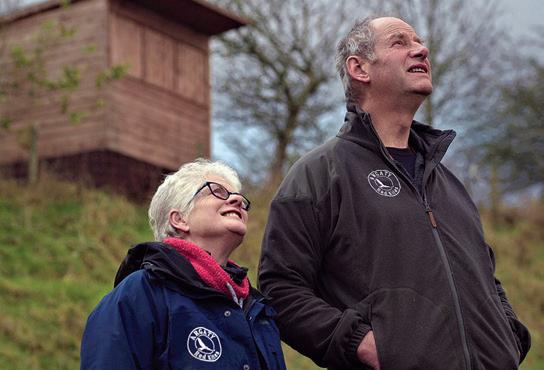
In that era many people lived in extreme poverty and squalor. Disease was rife, and if the harvest was poor they starved. Ducklings, goslings and rabbits (introduced by the Normans in the early twelfth century) were a vital food source, and it is little wonder that kites were reviled for predating their young.
Prompted by his subjects’ suffering, in 1457 James II of Scotland declared that kites should be killed wherever they were found. After bad harvests and subsequent food shortages, the Tudors followed suit, passing vermin acts in 1532 and 1566. Citizens were required by law to kill any of the many creatures that appeared on their monarch’s list of vermin. Church wardens ran the scheme, paying a penny for every kite head brought to them – and more for some other animals. Records still exist for several counties, particularly in the south-west. They paint a very grim picture. From lovegrove’s The Kite’s Tale we learn that from the seventeenth to the midnineteenth century, when the law was finally repealed, over 10,000
bounties are known to have been paid for kite heads in Cornwall, Cambridgeshire, Cheshire, Kent, Devon, Somerset and Gloucestershire alone.
In Scotland the situation may have been different. James II died three years after declaring war upon the kites, and there is no evidence that his orders were ever acted out. The old Statistical Accounts of Scotland, written in the late 1700s, state that kites were common in most parishes. up to that point, we can only infer that levels of killing in this country were not significant.
This changed, first with the Highland Clearances, when tenant crofters were cleared from the land to make way for large-scale sheep farming, and then with the growth of game shooting in the 1800s. From this point forward we see increasing examples of longheld antipathy towards predators turning to coordinated, devastating action, as gamekeepers and landowners moved to eliminate any animal that threatened, or was perceived to threaten, sheep or game. Red kites were on the road to extirpation.

www.farmingscotlandmagazine.com 97 BOOK SERIALISATION
Mum and Dad watch the kites at feeding time.
Pic by Andrew O’Donnell
Battling against the elements: A kite braves the weather in search of food.
Pic by Clare Harte

Women in Agriculture Scotland attends the Oxford Farming Conference
By Alana McLean, WiAS Committee Member

I’ve been trying to think of what the collective noun for farmers would be. A gaggle? A parliament? A herd or flock? And when politicians are
speaking, perhaps a murder or horde? Surely to describe us as a wave seems a little too cruel with the recent weather.
Regardless, since 1936 farmers and producers across all sectors dust off their best boots and descend on Oxford during the first
week of January for the Oxford Farming Conference (OFC).
It was my first-time attending the OFC and I was delighted

www.farmingscotlandmagazine.com 98
Women in Agriculture Scotland
to be accepted onto its Inspire Programme – formally known as Emerging Leaders. The Inspire Programme, facilitated by The Institute of Agriculture and Horticulture, enables ambitious candidates from the rural and agri-food sector to attend the conference, develop their own network and leadership skills, and receive support from industry bodies and professionals.
I applied to not only challenge myself, but to hear from leaders and changemakers from across the industry. My 9-5 job is working with Food Standards Scotland, the public sector food body for Scotland. But, during the weekends, and in the hours before and after work, I pull on my wellies and help out where I can on my husband and mother-in-law’s organic dairy farm in Aberdeenshire. My jobs mostly include bucket filling and calf rearing (un-supervised), some milking (supervised), and standing in the wrong place when trying to shift sheep.
Other than the benefits of being part of the programme, it was this year’s OFC theme – The Power of Diversity – that really appealed to me. Our industry has some real challenges ahead, and I believe that the greater diversity of thought, background, experience, and ability that we can encourage into agriculture the stronger our sector will be.
Over two days we heard from supply chain experts, politicians, farmers and agri-professionals about a range of issues and opportunities. But for me, the standout session was delivered by Dr Awal Fuseini, Senior Halal Sector Manager at AHDB.
With a background in meat science and a PhD from Bristol University, Dr Fuseini expertly outlined the economic opportunities for farmers looking to understand a growing halal market.
Dr Fuseini started by explaining that only two slaughter protocols are recognised by UK law for religious communities: halal for the Muslim community and shechita for the Jewish community.
LINE OF SLAUGHTER METHOD.
For most farmers, conversations about faith consumers and ethic markets aren’t the usual topic of conversation over their fly-cup–but they should be.
So, why should Scottish farmers care about the halal market?
Well, when valued at nearly £2 billion, the halal market is one that can no longer be ignored.
For starters, it is important to recognise that the Muslim community currently absorbs almost all the domestic mutton trade and a significant portion of the lamb trade too.
Scotland’s general population are not high consumers of sheep meat. QMS’s Scottish Red Meat Industry Profile reports that per capita consumption is sitting at only 2.2kg per year. For comparison, our consumption of beef is 19.2kg per year.
In stark contrast, the Muslim community are above average consumers of lamb and sheep meat, with 62% eating it once per week. Important religious festivals also peak their consumption and present real opportunities for farmers to tap into this growing market.
We often bemoan the fact that consumers don’t know – or simply don’t care – where their food comes from. But after Dr Fuseini’s presentation, I believe that there is a large consumer base that I’m sure would welcome engagement from the farming community. New markets require new diverse thinking, and I’ve no doubt that the farmers that work closer with growing markets such as these will reap the rewards.

www.farmingscotlandmagazine.com
Southern Belle
Happy travels!
The tour season is here again! Just arrived back from Argentina. What an amazing tour of great cattle and vineyards and fantastic guides, with a group of exceptional farming types, all of whom brought something to the table, when it wasn’t already laden with red meat and red wine!
As a tour leader, one of my major headaches is someone’s luggage not coming off the plane. Travel guru Simon Calder once said, “pack hold luggage, in the certain knowledge that you will never see it again!” Best advise I ever had and I never travel with anything other than a small cabin case.
Weather delays at Heathrow, meant we were running late for our connection in Madrid and while we made it, our luggage didn’t and we landed in Buenos Aries to discover our cases were still in Spain! Ditto the flight from Frankfurt. All except one that is… yip…only ever travel with hand luggage.
So, for those of you who are travelling this year, here are a few tips:-
1. Buy some packing cubes. They are much

easier to pack and if you are looking for a shirt for example, you only have to lift one pack out.
2. Put all of your liquids (under 100mls) in a plastic bag in your hand luggage, so you can get them out easily at security.
3. Pick up some dry shampoo in Boots (no other chemists are available at an airport} after you’ve been through customs. Great for second day hair, freshening t-shirts, keeping your feet fresh and ladies, for stopping chaffing in the inner thigh area.
4. Don’t use the bidet to wash your smalls as it will end up washing the ceiling instead.
5. Buy the cheapest clothes you can find because they wash and dry quicker that good stuff.
6. Always put medicines, valuables etc in your hand luggage!
Finally….. book through a good agent like Field Farm Tours (other companies are available) Your job is to arrive at the airport, their job is to do everything else and….relax.
Happy travels everyone
99
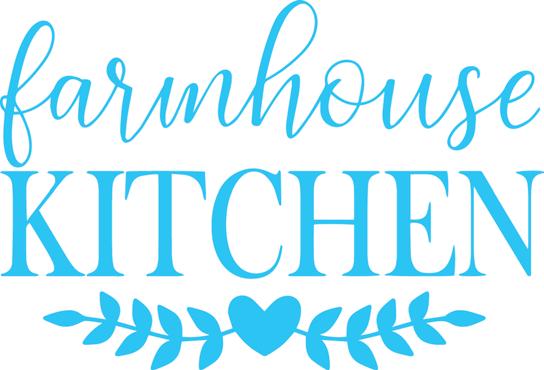
A Celebration of Cheese
By Wendy Barrie
The world would be a dull place without cheese and cheesemakers - and Scotland has its fair share of both which is why I founded Scottish Cheese Trail in 2002. It offers the perfect opportunity to share my love of good cheese whilst supporting those who work tirelessly creating it. From Orkney to Dumfries & Galloway, there will be a cheese for you: creamy brie and melting gouda, mature farmhouse and moist mozzarella, crowdie, tomme and tangy blues, from cow, goat and sheep milk. The range of flavours reflect the breed, feed, starter cultures and terroir, so check out www.scottishcheesetrail.com and discover for yourself.
Westray Wife Cheese Soufflé (an Alpine inspired cheese from Orkney)
Serves 2 as a starter. Cooking time depends on the depth of the dish.
25g butter
25g flour
125mls milk
2 Eggs
50g Westray Wife cheese, grated Blackthorn Salt & milled pepper ½ tsp wholegrain mustard
Dunlop & Pesto Pinwheels (Ann’s Ark of Taste cheese uses heritage Ayrshires, formerly known as the Dunlop cow). Half this pastry batch will make 2 dozen. The remainder can be chilled/ frozen to use later.
125g strong flour
100g plain flour
100g Dunlop cheese, grated Pinch of Blackthorn salt
150g chilled butter
150mls cold water
2tbsps pesto
Method:
• Pre-heat oven 190°C. Melt butter in pan, add flour and stir to form a roux. Gradually whisk in milk and bring through boil, resulting in a very thick sauce.
• Remove from heat and allow to cool a little. Stir in eggs yolks, cheese, seasoning and mustard. Whisk egg whites until thick with soft peaks and fold in to cheese mixture.
• Butter 2 individual ovenware dishes, fill and bake for 10 minutes or so until well risen and golden crusted. Serve immediately.
Method:
• Rub 50g of the butter into seasoned flour. Cut remaining cold butter into small cubes and add to flour along with grated cheese. Distribute evenly through the flour.
• Add liquid, mixing gently with a palette knife. It should come together as an uneven clump.
• Tip this rough mass onto a floured surface and shape into a brick, using the palette knife.
• Press gently/roll into a rough rectangle and fold over in thirds. Roll and fold three times more, making 4 roll’n’fold in all. Chill.
• Roll out chilled pastry into an oblong, spread thinly with pesto, roll up and slice.
• Bake spirals in a pre-heated oven at 220°C for 15 minutes until a rich golden hue.
Wendy is a cook, food writer & campaigner for local sustainable produce & biodiversity. Founder Director of award-winning Scottish Food Guide & Scottish Cheese Trail, Wendy is also Leader for Slow Food Ark of Taste & Cooks Alliance in Scotland, IGCAT Global Experts Network member, co-founder of Scottish Bread Championship & pioneer of East Ayrshire Council’s school lunch programme. She has co-written “Meadows: The Swedish Farmer & The Scottish Cook,” with her husband, on regenerative food production, available online & from selected farm shops.
www.farmingscotlandmagazine.com
100
Tomme Fondue (look out for delicious Tomme from Kedar & The Ethical Dairy)
Serves 2
225g Tomme, grated
150mls Orkney White Wine 10g cornflour Scratch of grated nutmeg

Quiche Lorraine (there are fabulous farmhouse cheeses on Scottish Cheese Trail)
For 2 individual servings
100g homemade shortcrust pastry
For filling...
2 eggs, beaten
2 tblsps double cream
Freshly milled pepper
2 rashers of streaky bacon, pre-grilled
50g farmhouse cheese, grated
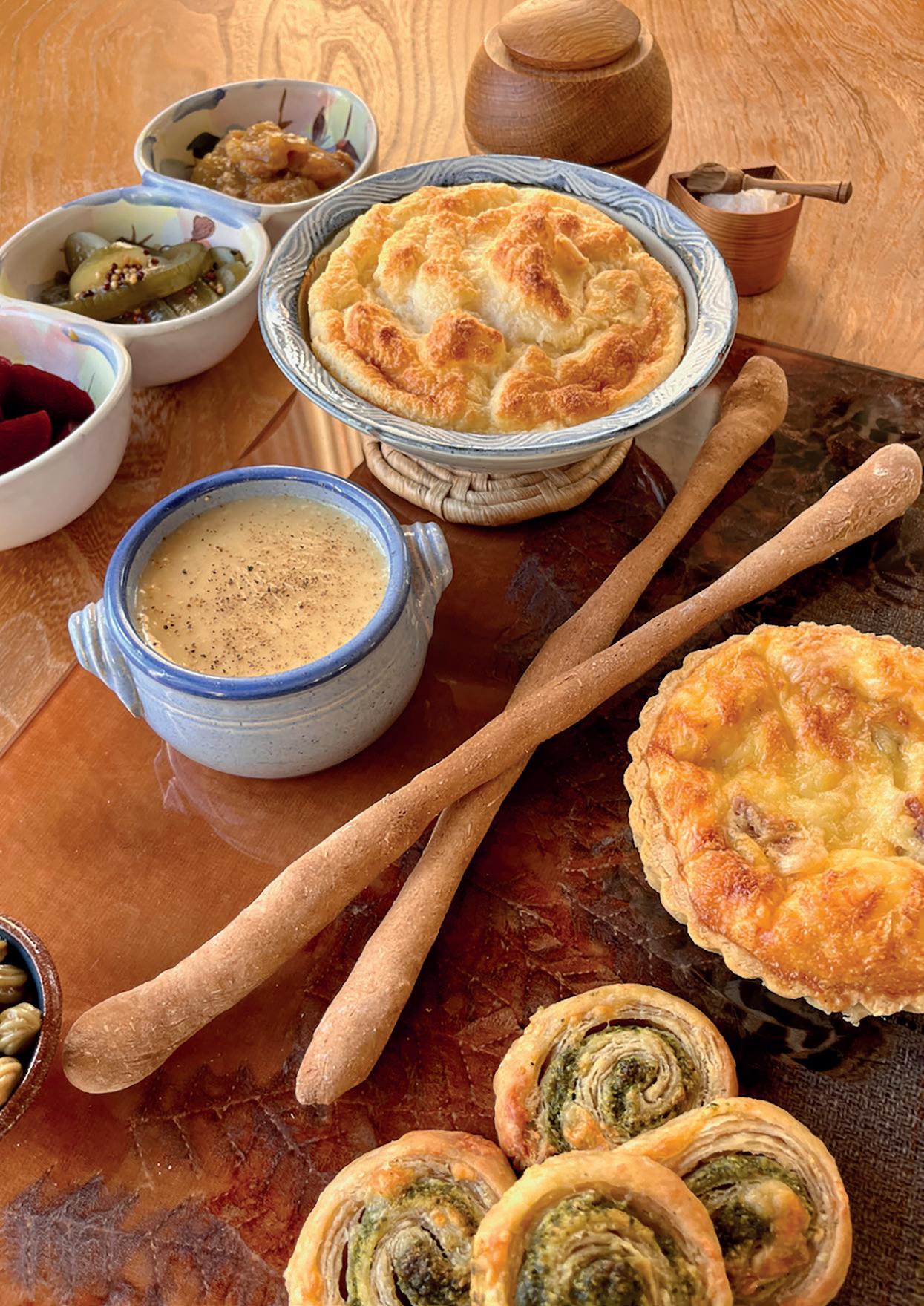
Method:
• Place wine in pot and bring to simmer temperature then add cornflour (blended in a little cold wine). Stir to thicken for a couple of minutes to cook out flour.
• Stir in cheese gently and gradually to ensure it melts.
• Season and serve with breadsticks/ bread cubes & pickled nasturtium seeds (poor man’s capers).
Method:
• Pre -heat oven 190℃. Roll out the pastry and line 2 pastry tins. Pierce pastry bases with a fork. Place on a baking tray and bake (empty) for 10 minutes. Remove from oven and reduce temperature to 160℃.
• Whisk eggs with cream, season and add bacon. Pour into pastry cases and add cheese.
• Bake for 20 minutes until filling is set.
Served with homemade salted cucumber, diced beetroot and apple chutney.
Photograph © Wendy Barrie
KUHN launches KARL – its future autonomous concept
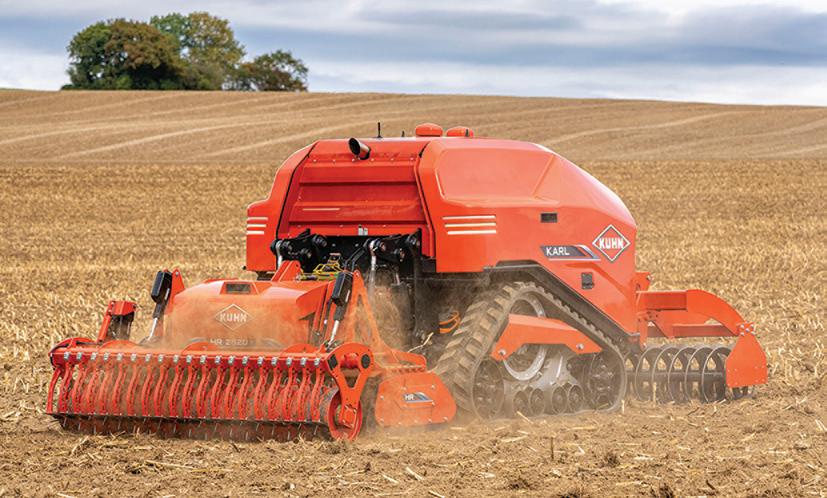

KUHN has launched its autonomous concept KARL, a driverless solution aimed at arable crop production.
KUHN presented KARL at Agritechnica 2023 to gauge customer feedback on the design concept and to assess if KARL’s attributes meet the needs of progressive crop production systems.
Edd Fanshawe, KUHN’s product marketing specialist for arable and connected services says: “KARL is an autonomous solution dedicated to plant production which we are convinced offers many advantages. Field crop production is evolving significantly, with farmers aiming to lower soil compaction and reduce chemical inputs, while maintaining food supply. This focus will likely increase the number of operations, and
agricultural robotics can help in a big way.”
KARL uses a hybrid diesel/ electric power source with a 175hp Volvo engine running an electric generator. The drive of the tracks and implement is solely electric, which offers a smooth drive engagement, along with the ability to make incremental adjustments to the implement. The implement has a level of intelligence to detect errors, blockages, and breakdowns by sending an alert signal to KARL if there are issues, something that isn’t possible with a conventional implement with no communication method.
A 2.5m HR 2520 e has been tested with KARL for several hundred field hours, with this width easy to load on standard trailers for transporting between fields without requiring additional licences. KUHN is currently exploring soil engaging and shredding implements, along with additional tools from KUHN’s portfolio, that can be available to KARL in the future.
“Although KARL isn’t ready for commercial production yet, we hope that a fiveyear timeframe is realistic as more field tests in real-world conditions take place over the next few years. KARL shouldn’t be considered a replacement for the tractor, but a different concept entirely, with the potential to run a fleet of KARL autonomous tools to adapt to different farm sizes and labour restrictions faced by farmers across the world,” concludes Mr Fanshawe.
www.farmingscotlandmagazine.com 102 machinery
FARMING SCOTLAND MAGAZINE Next issue out May 2024 Sbscription page 36




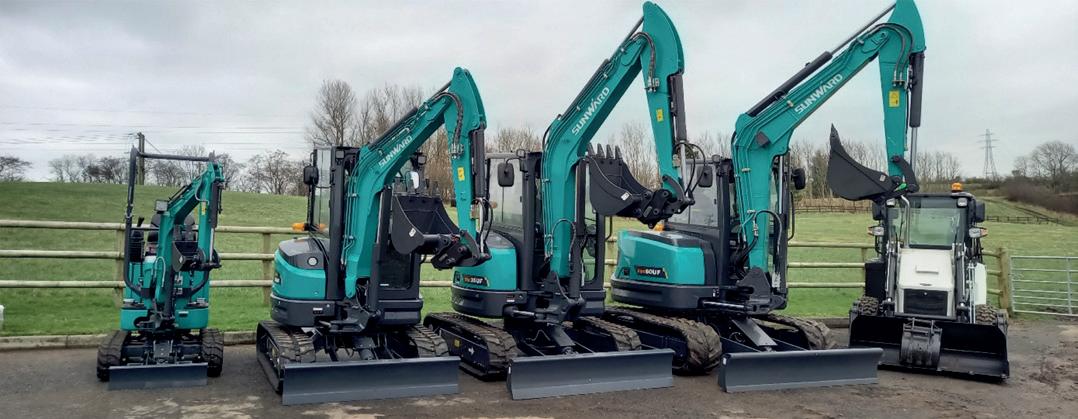
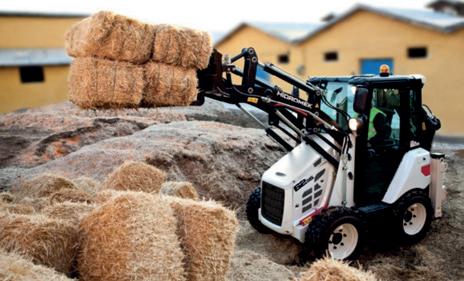
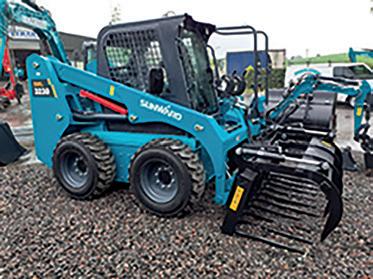
KATTRAK INTERNATIONAL LTD Newly appointed HOLP –ROTOP ATTACHMENT SCOTTISH DISTRUBUTOR & TOWMATE TRAILERS Distribution, Sales, Hire Fleet, Service, Spares, Training Wheeled dumpers, tracked dumpers, excavators, telehandlers, special machinery Kattrak International Ltd is proud to be an official Scottish dealer & distributor for Sunward, Hidromek and Holp Rototop Attachments Kattrak offers a broad range of wheeled & tracked dumpers as well as other machinery for hire at competitive rates Ardoch Farm, Old Glasgow Road, Kilwinning, KA13 7QJ Telephone: 01294 557835, fax: 01294 554095 E-mail: sales@kattrak.com or info@kattrak.com
Bunning reintroduces trailer range
G T Bunning and Sons showcased a new redesigned four-model trailer range at LAMMA 2024, with the company returning to trailer manufacturing 13 years since building its last one.
The new four-model range will be built at Bunning’s factory at Gressenhall in Norfolk, and the company has a proven track record of building high-quality trailers that began in the 1960s. The reintroduction of the trailer line has been driven through increased customer demand and will maximise the 6,840m2 state of the art factory expansion that has been completed over the past two years.
Chris Druce, sales director at Bunning, explains why it is the right time to start building trailers again. “We have been asked by existing Bunning trailer customers for several years to start production
again and our recent factory expansion has allowed us to streamline the build process with cutting edge technology. We’ve improved some key areas of the trailer that will please old and new customers and we are delighted with the final product.”
The new range is based on the old design but has been improved and modernised in certain areas and features a completely new tailboard. Four models will initially be available in 14, 16, 18 and 20t formats. Each will feature dual ADR axles with larger bearings and multi-leaf suspension replacing the single parabolic system.
The 4mm thick steel sides feature only one welded join along the length, which helps increase strength, and smooth internal faces prevent crops, such as potatoes, being damaged. The new design

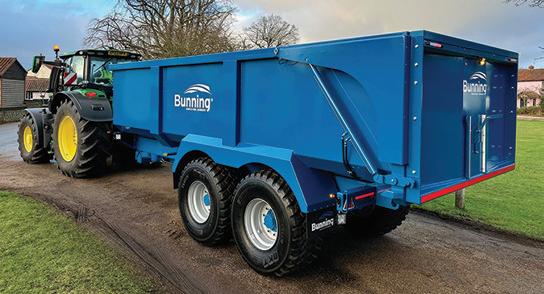
has a deeper top rail and wider rear corner posts, both now 80x120mm replacing the 80x80mm on the earlier models, offering further strength. The 300x150mm chassis remains from the previous trailers and the 200x200mm sprung drawbar has been proven on the spreader range.
The tailgate is a completely new design. It is constructed from pressed steel and is tapered from
the sides to the grain chute to aid unloading. As the hydraulic tailgate closes against the trailer, a locking pin on either side is hydraulically activated as the ram completes its final travel. These pins hook onto the tailgate and pull it into the trailer, providing a tighter seal than the previous design. The grain hatch has been redesigned with plastic runners for easier operation.
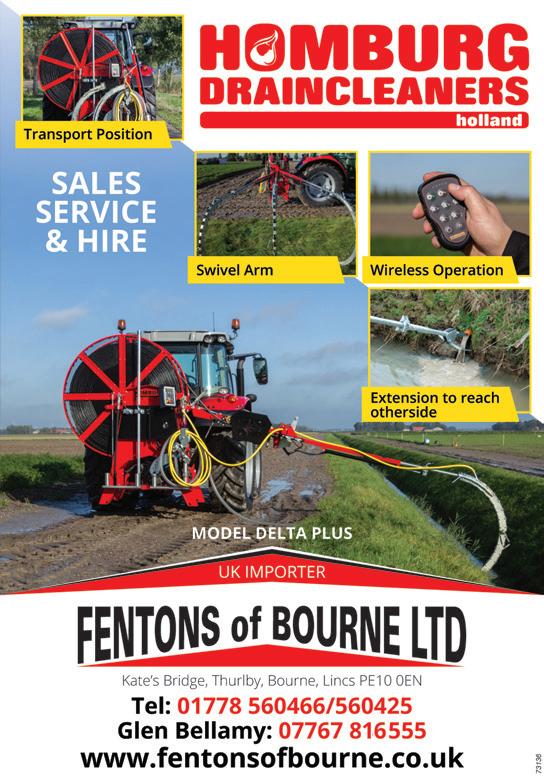
machinery www.farmingscotlandmagazine.com 104 See us at Croptec 2022 23rd & 24th November STAND 2326
Retrofit part halves trailing shoe row spacing
Vogelsang has launched a new DoubleFlow linkage option for its trailing shoe slurry applicators that enables the operator to halve the row spacing from 25 centimetres to 12.5. This doubles the surface area coverage operators can achieve without affecting tractor forward speed.
“The DoubleFlow runner divides the drop hose into two outlets, using a Y shaped piece, which splits the row spacing when spreading liquid manure to enable operators to cover more ground with a narrower spreading belt,” says Vogelsang’s Andy Hayhurst.
The new DoubleFlow trailing shoe part is easy to retrofit and can be added to the Vogelsang UniSpread and BlackBird trailing shoe linkages from May 2024. It has been designed to fit the
flow optimised PrecisionFlow nozzle that existing Vogelsang customers will recognise from the BlackBird.
Mr Hayhurst suggests Vogelsang’s trailing shoe applicators are becoming more popular in the UK due to the PrecisionFlow spout used, which ensures precise slurry positioning.
“This is especially important on grassland to improve forage quality and reduce the risk of slurry contaminating the green crop,” he adds.
The lightweight design of the Vogelsang trailing shoe applicators features a new runner design which is made from Hardox steel blades and wearresistant plastic. This offers operators a hard-wearing and robust design that is easy to operate and maintain.
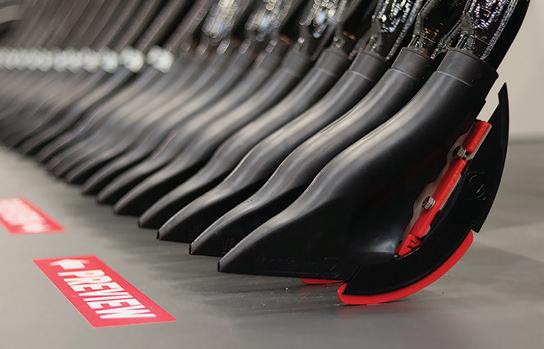
“The steel blades can be replaced individually. Operators will also benefit from the long
service life of the applicators and low cost of spare parts,” concludes Mr Hayhurst.


machinery
New universal 360 mm wing share with three mounting positions for AMAZONE mulch cultivators
The new wing share for the Cenius and Cenio mounted cultivators has a width of 360 mm and can be mounted in three mounting positions to cater for a variety of operating conditions. This means that the cultivators can be used more universally on farms with variable soil conditions.
The wing share can be mounted on the tine at various heights and angles depending on the application and soil condition. For the shallow cutting of cereal stubble, the wing share is mounted in the lowest of the holes in the leg.
In this case, the wing share is almost parallel to the soil, which allows shallow working from 5 cm to 15cm. If the soil is very hard due to extremely dry conditions, penetration may be problematic due to the lower mounting position of the wing share and therefore more prone to riding out. For this reason, the second mounting point enables the wing shares to be bolted on slightly higher than in the first position. As a result, the point works deeper than the wing share and thus generates a greater undercut with an easier pull-in.
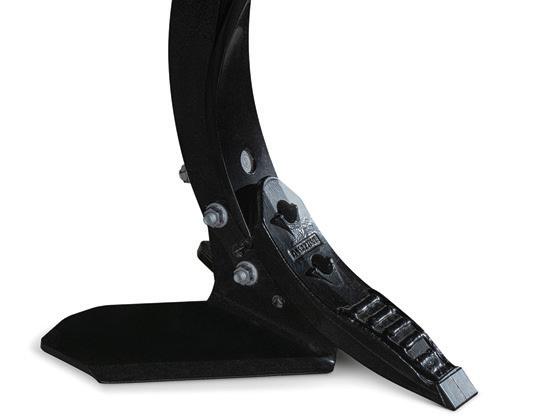

machinery www.farmingscotlandmagazine.com 106
One for all from Pöttinger: TEGOSEM, the tank for flexible application
The TEGOSEM hopper made by Pöttinger is available as an option for a wide range of machines. With the TEGOSEM, soil cultivation, seeding and application of different seed and fertiliser materials can be carried out in a single pass. This saves time and money. The flexible hopper can be combined with both linkage mounted and trailed machines.
Different application materials
Thanks to the two different metering shafts, grass seed or similar companion crop seeds can be sown in addition to small and large-seed cover crops. The TEGOSEM can be combined with a range of machines –whether tillage implements or
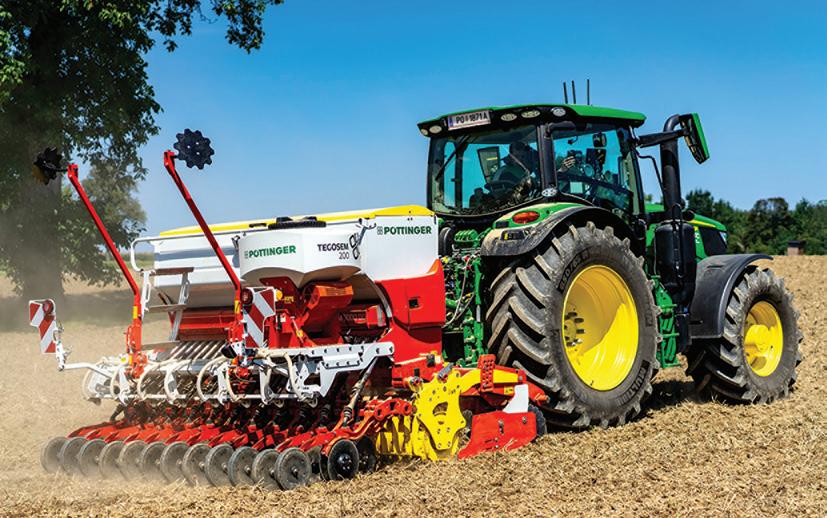
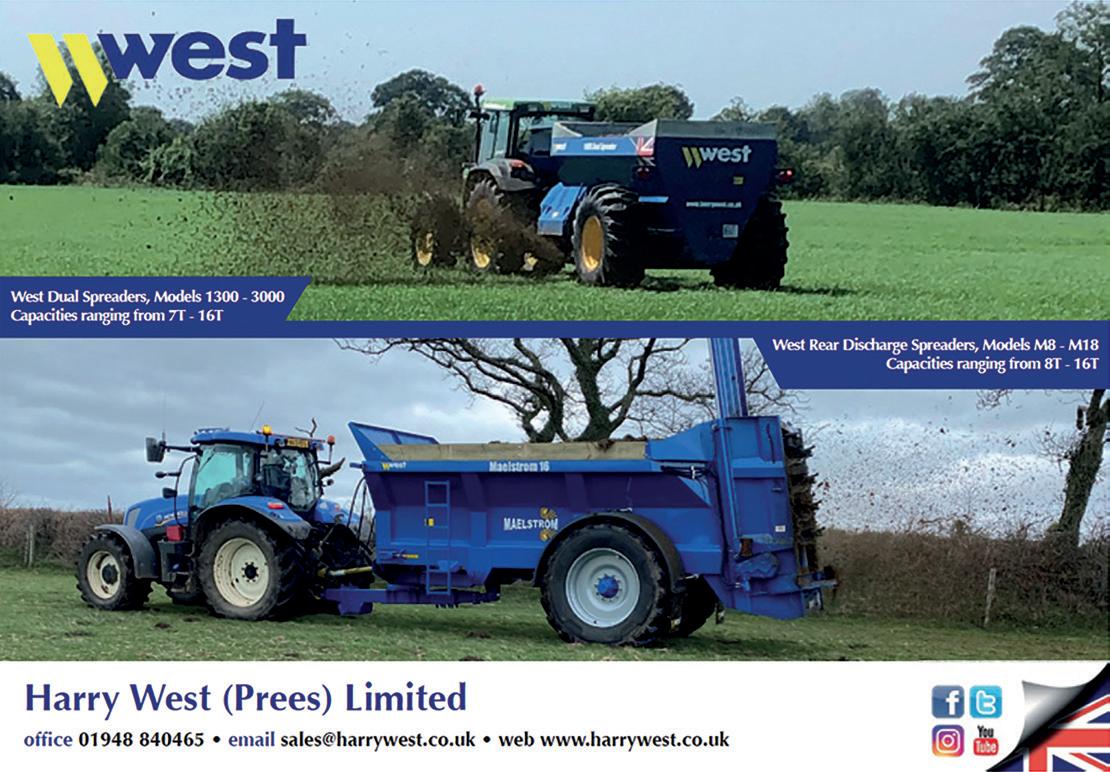
machinery www.farmingscotlandmagazine.com 107


seed drills -.to cover a broad spectrum of applications
In a single pass
Used in combination with a Pöttinger seed drill, the TEGOSEM enables an additional component to be applied to the surface. This means that the sowing of companion crops or cover crops can be carried out on the same pass to conserve the soil. Small seeds are very good for adding to cover crop mixtures, but require placement on or near the surface for optimum germination. The TEGOSEM enables material to be deposited on top, while placing the majority of the mixture deeper down. As a result, several components can be included successfully in the cover crop mixture. Soil fertility is also given a positive boost, because mixtures with at least eight different types of seed are proven to promote soil life and increase the biodiversity of microorganisms.
The TERRASEM seed drill with TEGOSEM sowing unit enables three components to be applied simultaneously. This means that companion crops can be sown with the main crop. In addition, a component from the TEGOSEM can be fed directly into the coulter. At the same time, the FERTILIZER-PRO coulters are used to deposit starter fertiliser.
The TERRIA, SYNKRO, TERRADISC, LION and FOX tillage and seedbed preparation implements are also available with the TEGOSEM. A major advantage here is being able to combine tillage with sowing a cover crop, because suitable weather windows are often short and every second counts. Precious time is saved by eliminating the hour pass. Especially in terms of the Common Agricultural Policy, where fallow land over the winter can now be easily avoided. The seed is deposited by distributor
plates in front of the rear roller, which immediately ensures optimum consolidation and
restores the capillary effect. That way, everything is prepared for optimum seed emergence.
Processing perfection: Tomahawk C120 ‘Calibrator’

The Tomahawk was first released to make it easier for farmers to
bed straw in loose housing or feed baled silage for livestock,

www.farmingscotlandmagazine.com
machinery
110
and has been extended to meet the needs of operators looking for precision processed straw for bedding or feeding in modern TMR rations. Tomahawk models are now also found processing biomass for use in anaerobic digesters, or pelleting and briquetting applications, with electric drive Tomahawk models now available.
These applications require precision in the length and condition of material being produced and increasingly high outputs to meet the needs of contractors and large scale dairy units. In response, in 2017 Teagle launched the Tomahawk C12 Tub Grinder, which is now in use in over 20 countries. The C12 enables single operator use and homologation for safe use on highways. Importantly the machine allows quick screen changeover (direct from the ground), so that the operator can ‘Calibrate’ the material to precisely meet the needs of the application, from 100mm to an ultra-fine 5mm straw powder.
In it’s latest development, Teagle have released the ‘Tomahawk C120 Calibrator’ for Spring 2024 with a focus on increasing output further still, up to 15t/hr, and capability to process damp materials, with a focus on biogas applications. The popular grain milling hopper, an optional accessory, can now process up to 30t/hr.
The new Tomahawk C120 updated features include:
• Ease of use : A round tub for straightforward loading (folding sides ensure legal transport width on highways)
• Greater output : A wider, longer and stronger twin ram conveyor, fed by an upgraded wider rotor housing system
• Improved durability : Sintered Tungsten Carbide hammers as standard
• Easier maintenance: Autogreasing of main driveline bearings and auto oiler for tub drive chain
Components for the machine are now finished in a two coat powder paint system, the latest £2.5m investment in production facilities at Teagle Machinery.
The C120 is now available for on-farm demonstrations. Typical price on-farm is around £75k + VAT.
Contact Paul Curnow, UK and Ireland Sales Manager, on 01872 560592 for more information.

machinery www.farmingscotlandmagazine.com 111 FARMING SCOTLAND MAGAZINE Subscription page 36
Kubota appoints Ian Lauder as dealer manager for Scotland and the north of England
Ian Lauder has been appointed as Kubota (UK)’s agricultural and groundcare dealer manager for Scotland and the north of England.
Having gained an apprenticeship as a technician and developed a background in electronics, Ian’s early career took him through the electronics industry before taking on the role of territory manager for a golf and turf care dealership. It was a career path that led him to join a turf machinery manufacturer.
“Working at dealer and manufacturer level has given me a great insight into many aspects of the machinery business,” said Ian. “So, when the chance came to join Kubota, it was an opportunity I had to grab with both hands.”
Ian adds that the Kubota business has so far provided him with many opportunities to apply his existing knowledge, and also to further develop his expertise through the agricultural sector.
“There is growing demand from the industry for Kubota tractors and equipment, and with a desire from the company to be a major player in these markets, it’s a great time to be working for such a premium manufacturer,” he said. “It is a brand that is certainly being noticed.”


machinery www.farmingscotlandmagazine.com 112
FARMING SCOTLAND MAGAZINE Next issue out May 2024 Subscription page 36

Greater seeding flexibility –LEMKEN Solitair
Just under a year after the successful market launch of the Solitair 9+ pneumatic seed drill, LEMKEN now introduces its new “Duo” version with divided seed hopper. This machine offers a wide range of options for simultaneously sowing seeds, fertiliser and even catch crops.
The seed hopper of the Solitair 9+ Duo holds 1,850 litres. Its capacity can be split 50/50 or 60/40, depending on needs. As a result, two application variants are possible:
In the single-shot version, seeds and fertiliser are combined downstream from the two metering units in each of the two hopper segments. The different components are guided to the double disc coulters via a seed
with divided seed hopper


machinery www.farmingscotlandmagazine.com 114
pipe and deposited in a seed furrow. This allows a suitable starting dose of fertiliser to be added for winter sowing or a complete fertiliser application for summer sowing. An automatic tramline mechanism is integrated into the distributors.
The double-shot system provides greater deposition flexibility. With this system, the two components flow separately to a double disc coulter via doubled distributors in two seed pipes. They can then be spread either in a single row, as with the single-shot method, or separately and alternately in two rows following a quick exchange of the tramline cartridge in the distributor. In addition, the deposition depth of every other row can be adjusted separately via the pressure roller up to a difference of 5 cm. This allows two different seeds to be placed at different, optimum seeding depths or inter-row fertilisation to be app
Operation Operation is just as easy using a CCI terminal or via the
tractor terminal – either shows all key information at a glance. The machine is available in
rigid mounted configuration with 3m, 3.5m and 4m working widths.
Case IH Farmall 75C Electric and Steiger Quadtrac 715 Receive 2023 Good Design Awards
For over 70 years, the Chicago Athenaeum Museum of Architecture and Design and Metropolitan Arts Press Ltd. have presented the Good Design awards programme celebrating the yearly achievements of design excellence.
Case IH, a global leader in agriculture equipment, has been recognised as a 2023 Good Design® Award Winner for the Farmall 75C Electric and the Steiger Quadtrac 715 tractors. The award, presented by the Chicago
Athenaeum, showcases global industrial innovation and cuttingedge graphical designs.
“The principle behind the development of the Quadtrac 715 is not simply more power,” says Franz Josef Silber, Case IH product marketing manager for high-horsepower and 4wd tractors. “Our aim was to create a machine that matches the requirements of our region’s largest farms, to operate implements at their ideal speed, producing higher workrates
and allowing operations to be performed at the ideal time, even in tough working conditions, to make the most of short weather windows. We also wanted to ensure soil protection via a bigger footprint and fewer passes, which also means greater efficiency and minimal trafficked land.”
Both the Farmall 75C Electric and Quadtrac 715 already boast award-winning pedigree with Farm Machine 2024 and ASABE AE50 Awards respectively.
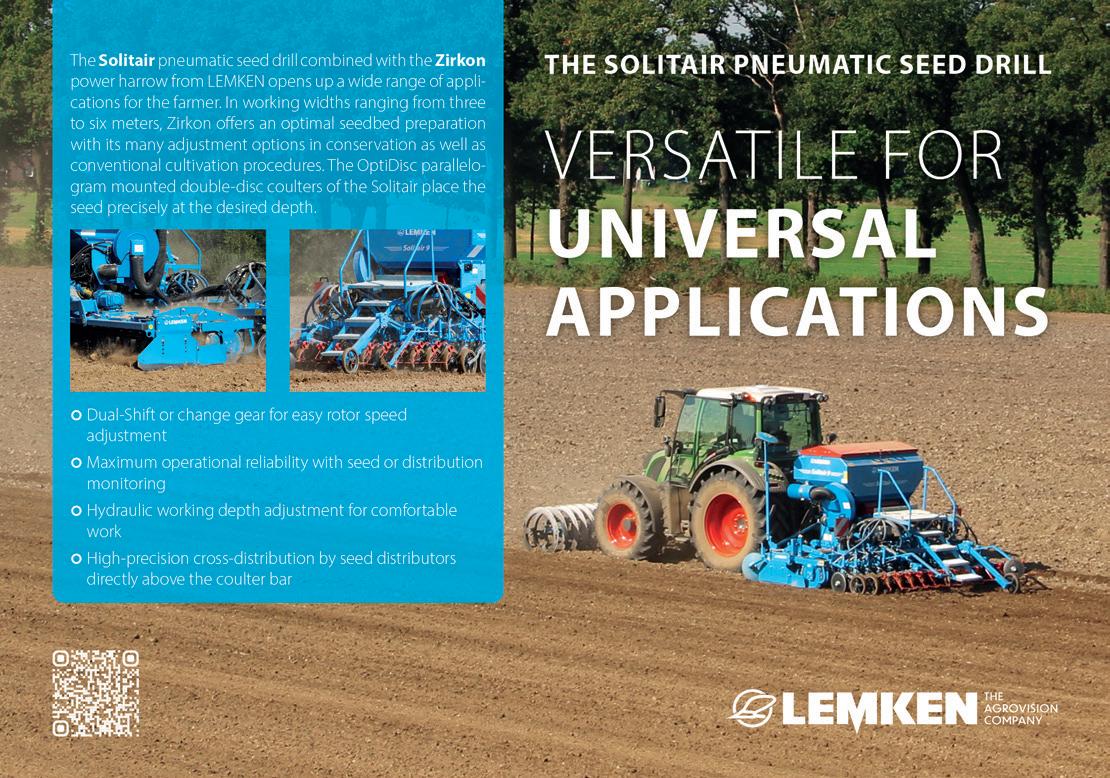
machinery
115
www.farmingscotlandmagazine.com

Farmall 75C Electric
Revealed publicly at Farm Progress Show 2023, the Farmall 75C Electric is Case IH’s first fully electric tractor. Sporting a brand-new design with diesel-like performance and power, the tractor is designed for agriculture’s toughest jobs.
The electrification of the Farmall coupled with the reduction in wear and tear on
parts and maintenance costs, can provide users with a reduction in operating expenses when compared to diesel tractors. Offboard digital features and additional automation capabilities like Safety Mode let farmers operate the vehicle with far more efficiency.
Quadtrac 715
Launched in 2023, the Quadtrac



715 was created to fulfill the customer need of increased productivity. Case IH focused on addressing the customer pain point of how to increase productivity by pulling larger implements at faster speeds while simultaneously enhancing the operator experience.
The most powerful Quadtrac tractor purposefully addresses this challenge delivering 778
peak engine horsepower, greater traction with reduced compaction, enhanced LED lighting to extend daily operations into the night, and a new hood that provides both improved service access and a signature new look that designates new levels of technology and performance that Case IH strives to provides its customers.
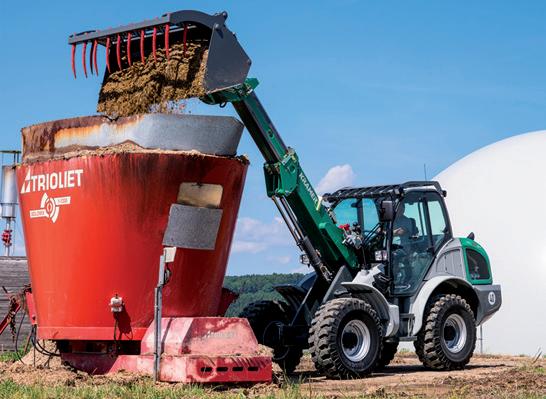


machinery www.farmingscotlandmagazine.com 116 Please visit our website www.john-kerr.com for up to date used machinery and special deals on new equipment 01506 842280 07836 527 480 (Andrew) email: andrew@john-kerr.com Your dealer for the best range of farm equipment in Central Scotland D-K-R AGRICULTURAL SERVICES LTD. Westfield, Coulter, Biggar, Lanarkshire ML12 6HN Tel. 01899 220897 • FAX. 01899 221413 E-Mail: dkrcoulter@hotmail-com D-K-R AGRICULTURAL SERVICES LTD. Main Dealers for Kramer Telehandlers

6o years celebration for New Hollands’ Essex tractor plant
The New Holland tractor plant based at Cranes Farm Road, Basildon, Essex, celebrates 60 years’ of continuous production this year. And as part of the commemoration, we are looking to collect any memories the broad farming community has of the plant, its products and impact over the course of the decades. We’d be delighted to hear from former employees, suppliers and farmers and farm workers who have been impacted by the plant, whether in New Holland or as it was formerly known Ford.
Please do reach out with memories – written, photographic or video.
We’d love to hear from you on newhollandukroi@cnh.com


machinery www.farmingscotlandmagazine.com 118
Bobcat Upgrades Compact Wheel Loader Portfolio
L75 and L85 updated with features from the Top-of-the-Range L95
In 2021, Bobcat launched the company’s first compact wheel loader (CWL), the L85. In 2022, the company added the L75 value model and in 2023, Bobcat launched its top-of-the-range premium model, the L95.
As part of Bobcat’s continuous improvement programme based on customer feedback, the company has announced annual updates for the L75 and L85 for model year 2024, allowing owners of the latest versions of these machines to benefit from some of the advanced features that were introduced last year on the L95.
Award-Winning Wheel Loaders
The Bobcat compact wheel loader range continues to win awards. The L85 was announced as a Product discipline winner in the 2021 edition of the worldrenowned iF Design Awards. In September last year, the L75 and L85 won in the Product Design category in the international BIG SEE awards promoting unique and original creative achievements.
With the award-winning designs of all three models, Bobcat has ensured that they share the same high level of standard features, providing high
operator comfort and ease-ofoperation, including:
• Heated cab designed around the operator
• Joystick integrated with the suspension seat
• Steering wheel adjustable in two directions
• Key ignition with quick StartStop
• Automatic parking brake to automatically engage and disengage, as required
• 5-inch digital screen with machine’s vital information managed via the jog shuttle control
New features on the L75 and L85 (2024 model year)
Power Bob-Tach (NEW) – factory option for L85
This provides a highperforming Bobcat attachment connection for applications in which maximum capacity for load and carry by bucket and pallet fork is not as important as connectivity to multiple Bob-Tach compliant attachments shared on the same job site with Bobcat skid-steer and compact track loaders.
Heated Air Suspension Cloth Seat (NEW) – factory option The cab seat now offers a higher

machinery www.farmingscotlandmagazine.com 119
back rest with a head rest, together with air suspension set-up, lockable floating and left-hand adjustable arm rest, providing a new level of operator comfort on the L75 and L85. The cloth surface of the seat with heating added improves the operator’s comfort all year round − in both cold and hot weather. The seat also includes a sensor to indicate operator presence and to enhance safety (by inactivating auxiliary flow).
Next issue out May 2024
Subscription page 36
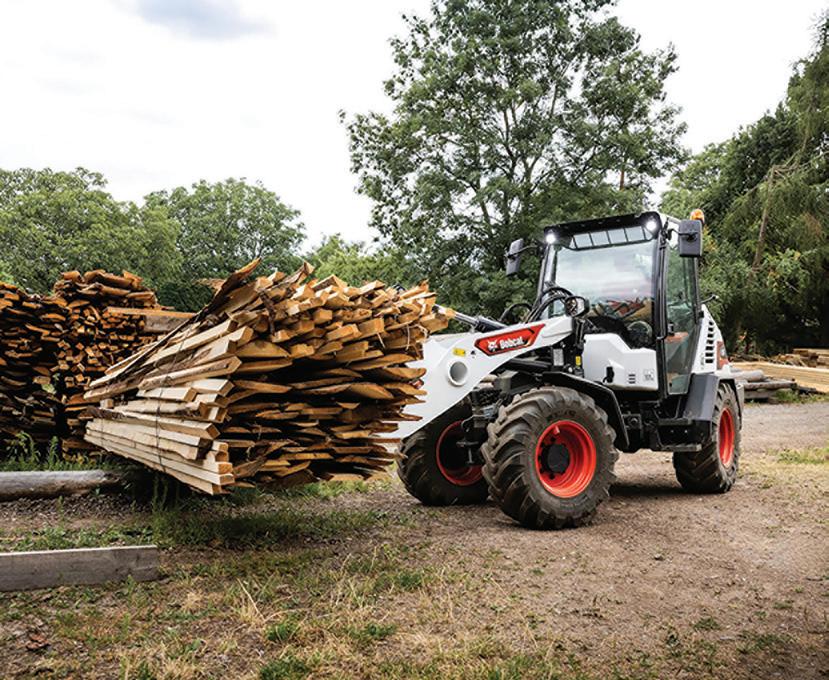


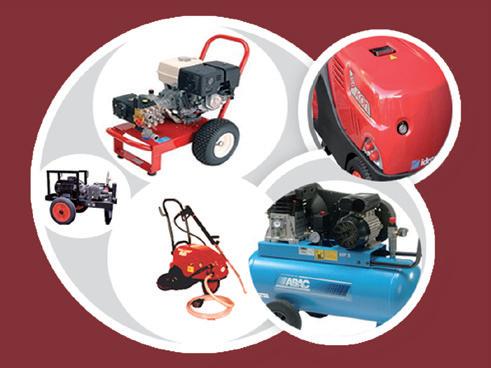

machinery www.farmingscotlandmagazine.com 120 Manufacturers and suppliers, W Bateman & Co has an enviable reputation for manufacturing and supplying both domestic and industrial pressure washers and air compressors. The Air Compressor and Pressure Washer Specialists Nationwide DELIVERY on all orders 01772 862948 email: info@bateman-sellarc.co.uk www.bateman-sellarc.co.uk
FARMING SCOTLAND MAGAZINE
PEOPLE ON THE MOVE

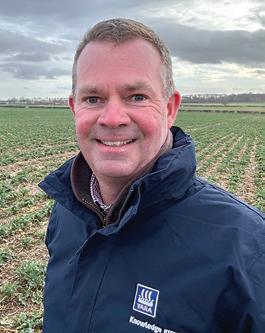


David Tripon
Avon Tuning HD increases technical support team.
David Tripon has joined Avon Tuning HD as a technical sales engineer to support and expand the authorised agent network of agricultural installers.
The newly created role is part of a strengthening of the in-house Avon Tuning HD team to assist the wider agent network, that now has over 150 agents in the UK and Ireland.
David joins Avon Tuning HD after working for Mercedes
Chris Harrold
Yara UK welcomes Chris Harrold, who joins the company as Product Manager for the YaraVita range in the UK and Ireland. As part of his new role, Chris is responsible for the commercial and technical promotion of the range of products which Yara develops for the UK and Irish markets.
Chris brings 10 years’ experience as a practicing agronomist to the role, which has helped him develop his technical expertise as well as giving him
Patrick Colquhoun
Scottish Land & Estates (SLE) is pleased to announce the appointment of Patrick Colquhoun as its new Vice Chair (Policy).
The rural business organisation, which is headquartered in Musselburgh, has appointed Mr Colquhoun to the role which will see him steer the policy development and political positions of SLE as well as chairing its National Policy
Donna Mearns
Barenbrug UK has bolstered its agricultural team with the appointment of Donna Mearns as regional sales manager for Scotland.
With 26 years of experience in the agricultural supply industry, Donna brings to Barenbrug a detailed knowledge of Scottish farming, its practices and – most importantly – its people.
as a service technician on commercial vehicles.
In his new role, David will be working closely with Avon Tuning HD director, Gareth Jones, to facilitate technical training days for existing and new agents, visiting agent depots to support installs of professional remaps, advising on technical issues, and recruiting new agents.
David comments: “I’ve always been interested in remapping and the technical efficiencies it can offer users. The HD side of the business is

“At the heart of any good business relationship lies good customer service,” enthuses
an appreciation of the challenges and issues arable farmers face.
As YaraVita Product Manager for the UK and Ireland, Chris will be liaising and working with distributor businesses, independent agronomists and growers, and promoting the extensive YaraVita product range.
Chris joins the business at an exciting time; the biostimulant market is growing with the recognition of the role they play in improving nutrient use efficiency and soil health, and
Group and acting as an SLE representative externally.
Outside of his new role, Patrick is Assistant Chief Executive Officer and part of the family ownership of Luss Estates Company, focusing on land and property areas of the business. He has been operationally involved with Luss Estates since 2016, having previously served as a director of the company for over 10 years.
Donna, “and as a ‘people person’, joining Barenbrug brings me back to a job I love doing, in a very down-to-earth way.
“I’m not one to sit behind a desk, so I’m relishing the prospect of getting out in the field and working with Scotland’s distributors, merchants and farmers.”
Donna is well-known in the Scottish agricultural supply industry, having worked for many years with the agricultural merchant Carr’s Billington,
www.farmingscotlandmagazine.com
growing fast and there is a lot of interest among farmers and contractors. Part of my role will be to support our agents to carry out remaps and identify new areas where our network could be expanded.
“One of my main tasks is to maintain the personal touch Avon has created within its network. As the agent numbers continue to grow, this becomes harder, and we don’t want to lose sight of what it means to provide valuable support to our full network,” concludes David.
helping crops better cope with abiotic stresses.
Yara also continues to invest in the development of crop specific nutrition products aimed at providing growers with a complete crop nutrition approach. In the YaraVita range, products include crop specific foliar nutrient products for crops such as oilseed rape and cereals, aimed at addressing specific issues and nutrient deficiencies. Helping growers get more out of the nutrients they are applying is a key focus for Chris.
Patrick is closely involved in policy, planning, and strategy for the estate, working closely with stakeholders including Loch Lomond & Trossachs National Park, NatureScot, local authorities and central government as part of decision-making for the business.
He also is involved in a number of community-led roles, including as an elected member of Luss and Arden Community Council, and as a director of the Luss and Arden Development Trust.
latterly as a regional operations manager. She has also served as secretary for the Scottish Seed Trade Association, a body which represents wholesale and retail Scottish seed merchants on issues relating to the herbage seed industry and in dealings with the Scottish Government.
“There’s a lot of technical knowledge within Barenbrug,” Donna notes, “and I will enjoy working with what’s a really closeknit team to build the Barenbrug brand here in Scotland.”
121
THE BOOK SHELF
Café Canna: Recipes from a Hebridean Island
by Gareth Cole
Canna, the beautiful Hebridean island measuring just two miles across and inhabited by only eighteen permanent residents, is home to one of Britain’s most remote restaurants. Café Canna is an award-winning restaurant and bar open every year from April to October. This brilliant new cookbook is a celebration of the café, its supportive surrounding island community, and the incredibly fresh local ingredients which constitute its fantastic recipes.
Café Canna is not your average restaurant – they have to employ some fairly non-traditional methods of acquiring ingredients, planning around incredible storms, and are, in general, more at the mercy of nature and its everchanging environment. This book, too, is not your average cookbook, as it highlights the unique joys and challenges of operating a restaurant on a remote island. Gareth Cole, the café owner and author, offers his valuable, first-hand experience in how he forages for food on the island,
brainstorms new recipes, and adapts to the constant changes on Canna. Raised in Aberdeenshire and having spent much of his adult life in London, Gareth has now run the restaurant for six successful seasons and has dedicated himself to sharing Café Canna’s incredible story in this book.
The book is divided into three main sections – The Shore, The Sea and The Land. These chapters are organised around which ingredients can be found from each area on Canna, and how you can try replicating these unique recipes in your own home. Before each collection of recipes included, Gareth shares practical wisdom on how to find and incorporate some unconventional ingredients into your own cooking. The first chapter explores how to forage and cook with edible seaweed, which will fascinate readers not from an island or seaside community.
The Sea section includes helpful step-by-step guides on preparing fish and shellfish, while the last section contains useful advice


on discovering wild ingredients like gorse, wild garlic, herbs, and concludes with a guide to jointing a rabbit.
There are some truly creative recipes in Café Canna which you may be inspired to try your hand at making at home, such as the Lobster macaroni and cheese tartlet or the wild gorse crème brûlée. Café Canna contains beautiful
photographs to illustrate every recipe and helpful tip, capturing the beauty of the island as well as the delicious dishes created from its bounty. This book will encourage all of us to be more thoughtful about how we can be sustainable in our own cooking and prompt us to go out into our local communities to replicate some of the inventive recipes designed on Canna.
Café Canna: Recipes from a Hebridean Island by Gareth Cole is published by Birlinn in March 2024 (£25, hardback)
www.birlinn.co.uk
The Dust Remover
Written by Jim Easton
Illustrated by George Mackie
This funny short story of a farming couple, who somewhat tired of making do, decide to invest in an all singing , all dancing dust remover machine.
However, they come to realise that rather than trying to keep up with the times, they find to their cost, sometimes old ways are best.
Available to order from Amazon
122
www.farmingscotlandmagazine.com

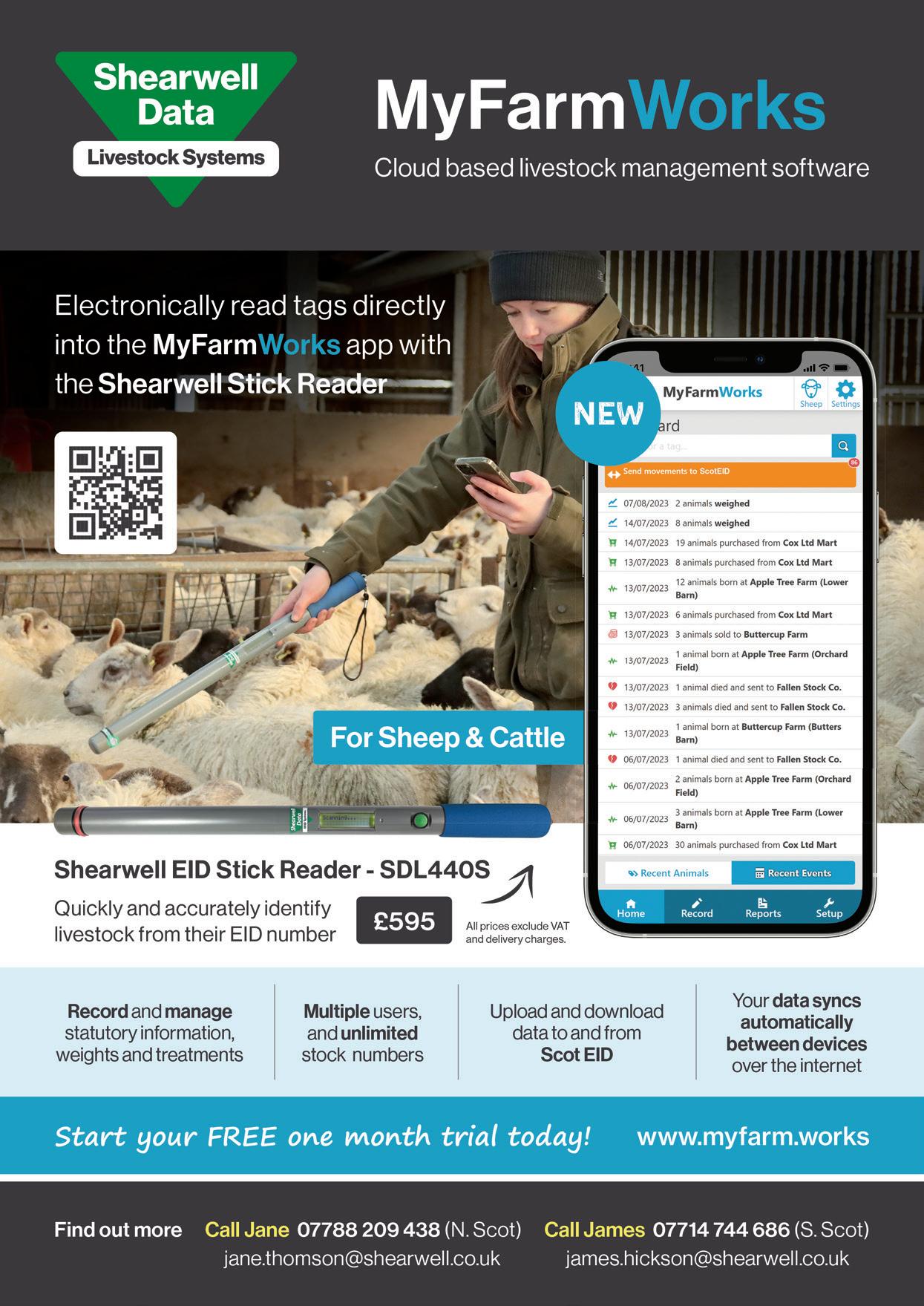




































 By Mairi Gougeon, Cabinet Secretary for Rural Affairs, Land Reform and Islands
By Mairi Gougeon, Cabinet Secretary for Rural Affairs, Land Reform and Islands






























 Ffermio Cymru
Ffermio Cymru
































































 By Balfour Hay Northvet Veterinary Group
By Balfour Hay Northvet Veterinary Group









 By Donna Smith
By Donna Smith






















 Jake Swindells
Jake Swindells































































































